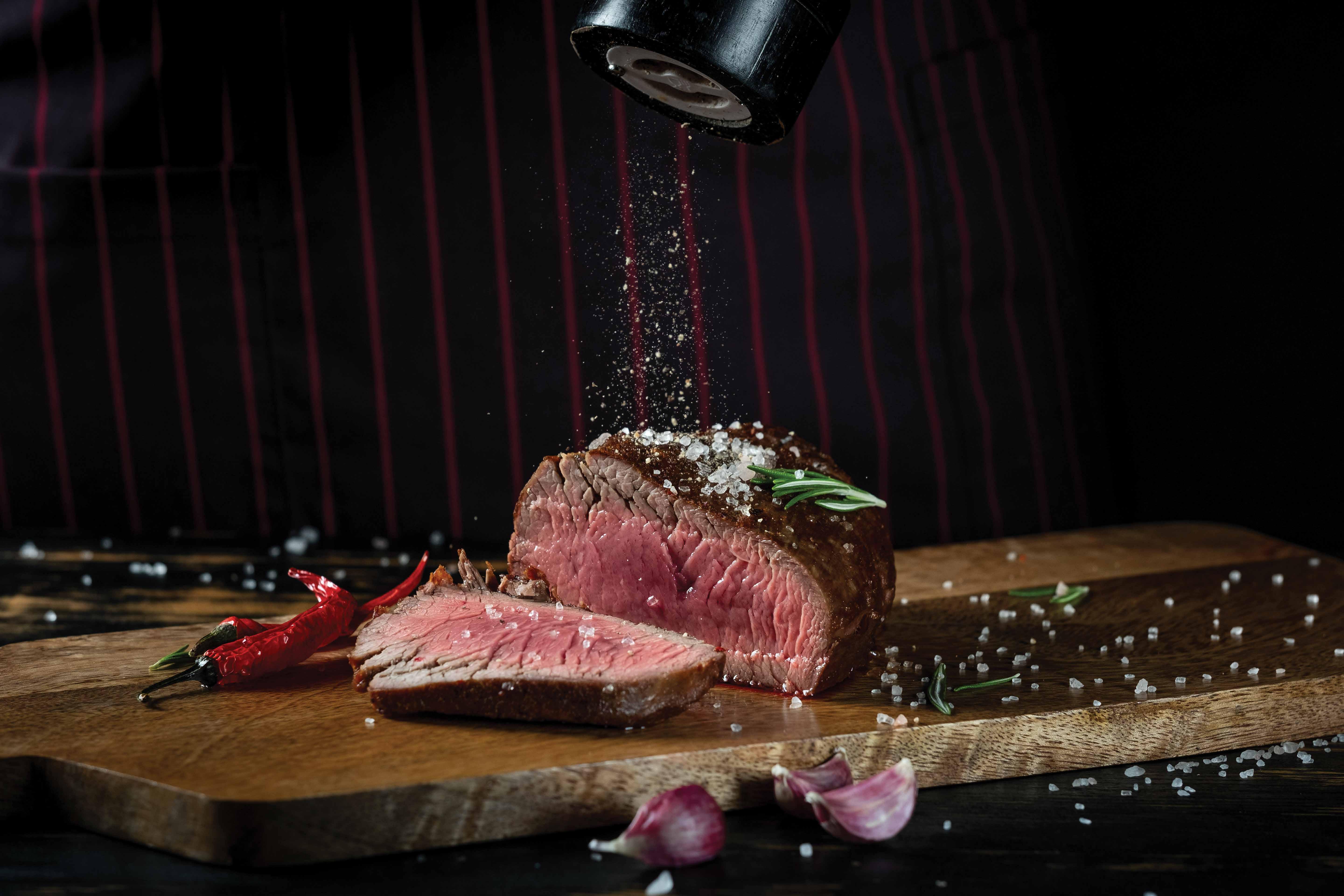

in Gold A Lesson
The UAE ECG Team defends the Best National Team title at FHAM 2025 with 21 medals. Gulf Gourmet chats with the culinary rockstars behind the hat-trick
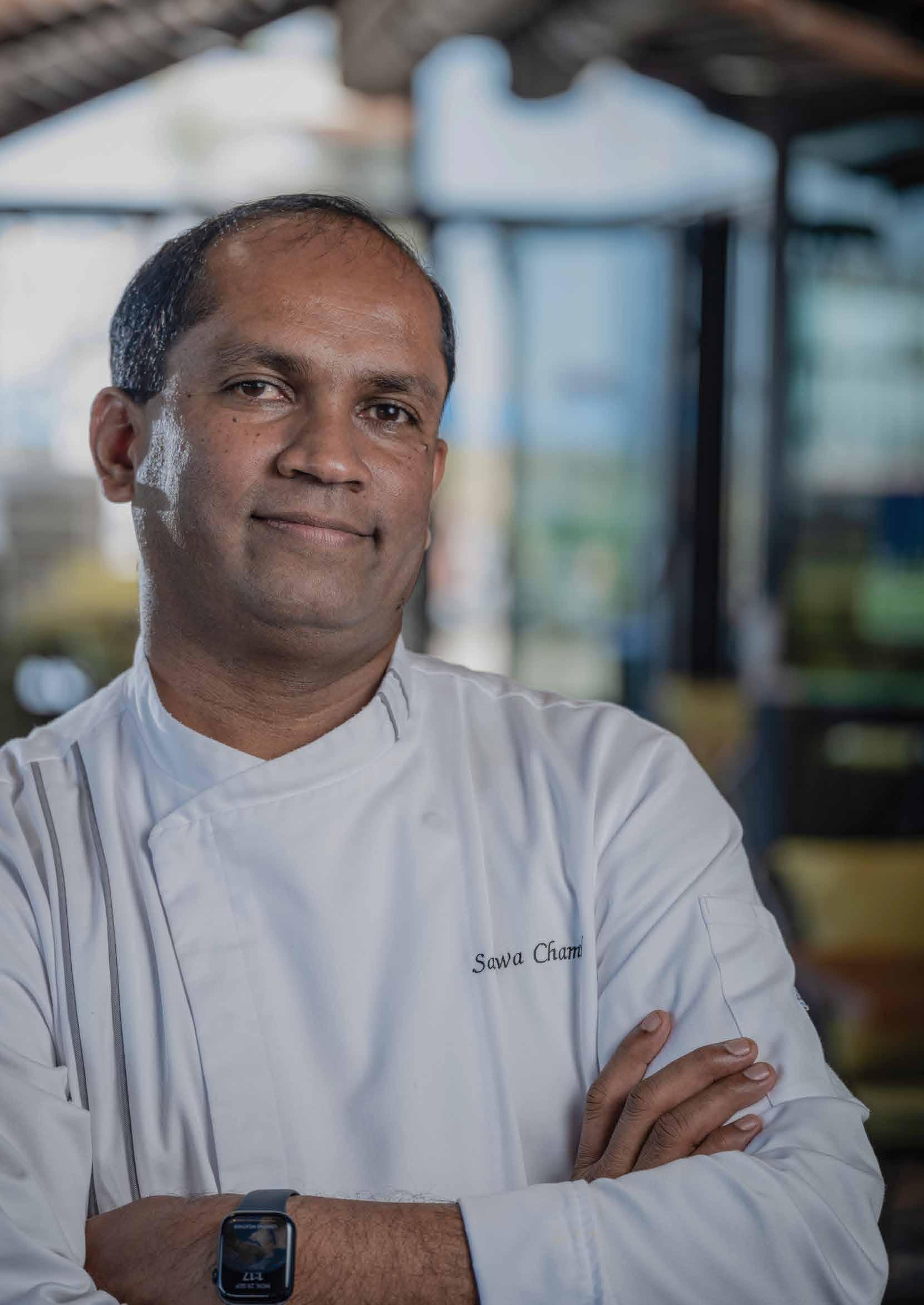
MADAME MAKETH IT HAPPEN
How does humility turn everyday efforts into impact? Josephine Cuthbert, VP of ECG Administration & Affairs, reveals the answer

BITE OF PAN-ASIA
Lin Naing Soe, Head Chef at ATTIKO Dubai, shares how he balances flavors and techniques for exquisite Pan-Asian dishes
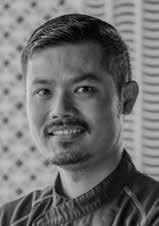
HOME IS WHERE THE HEART IS
Dhanushka Navod, Pastry Sous Chef at W Dubai, is turning sugar, chocolate, and mango into edible stories
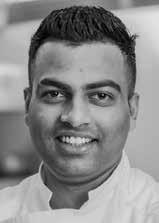
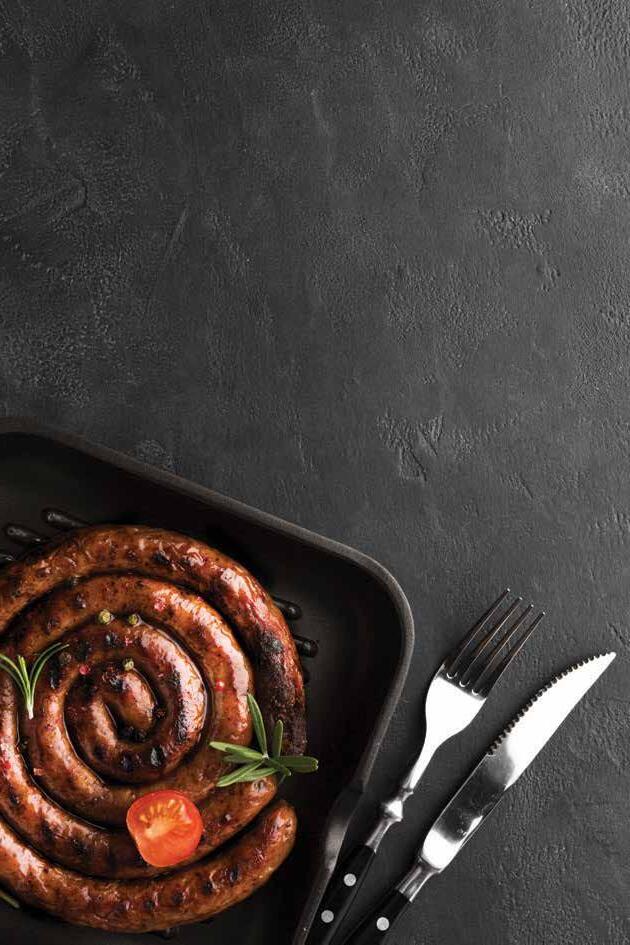
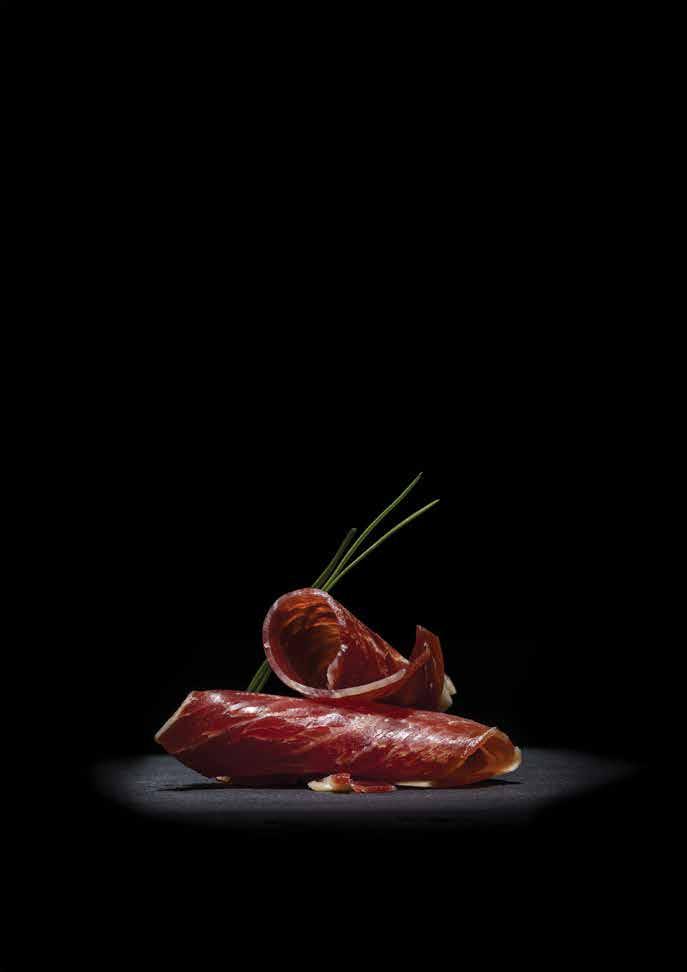

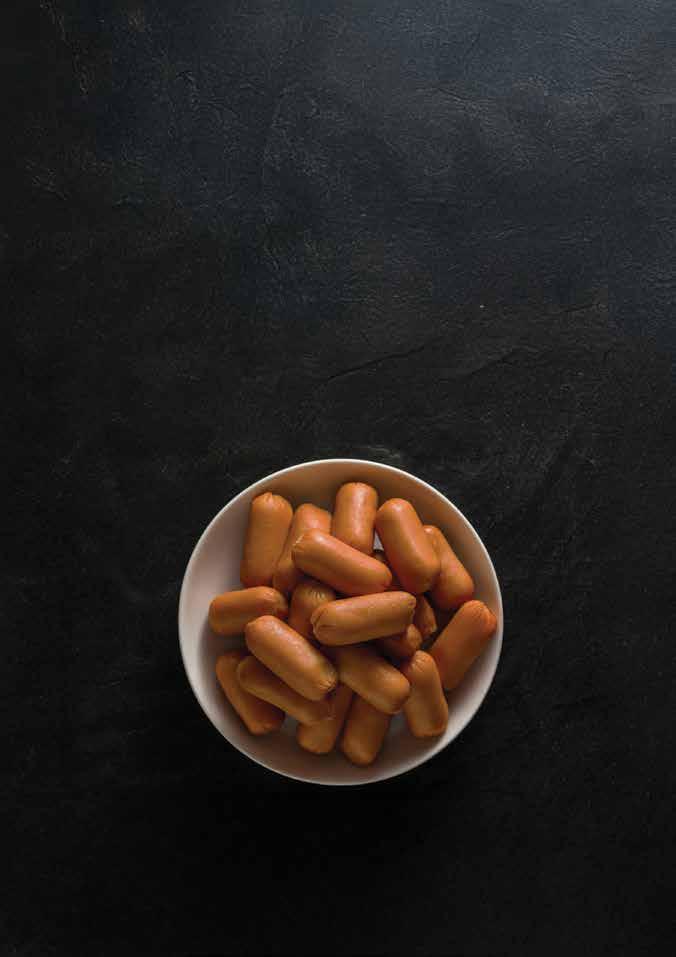
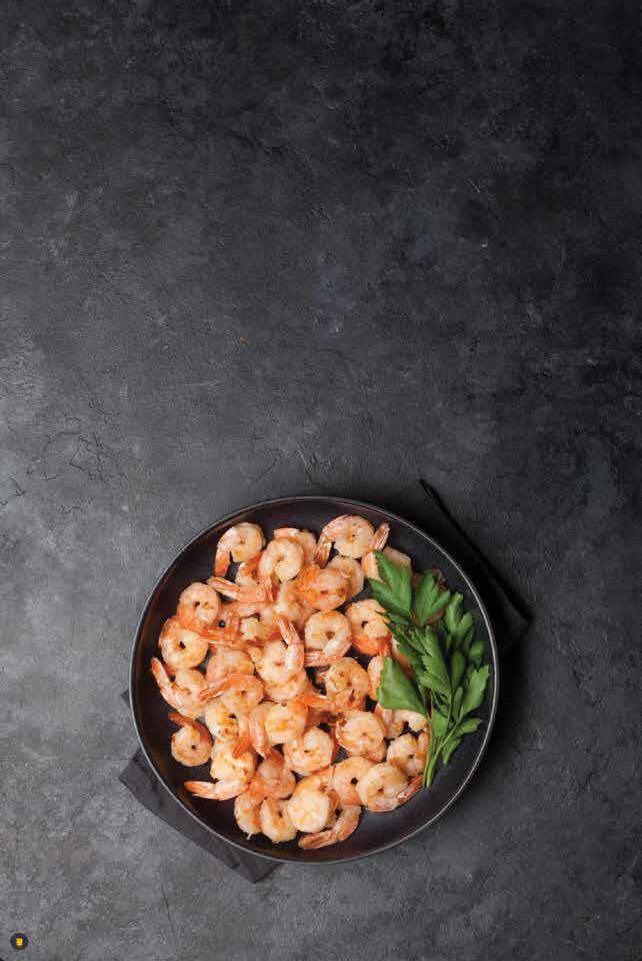
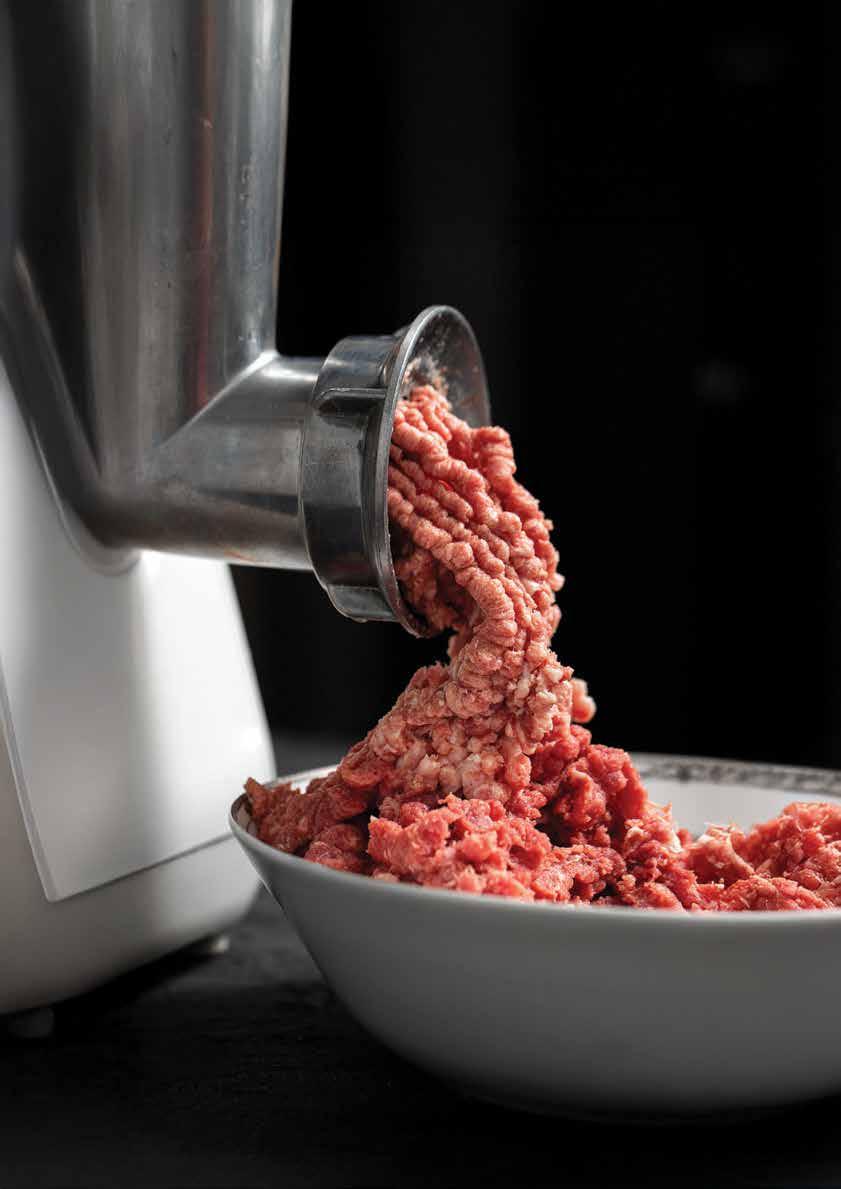



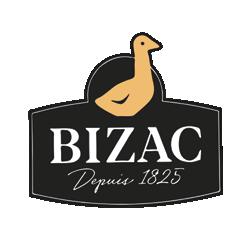

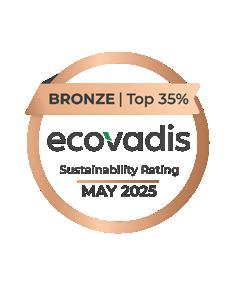

president’sstation
email editor@gulfgourmet.org
Dear Members, Friends, and Partners,
Welcome to the November issue of Gulf Gourmet
As we turn the page from last month’s celebrations, I would like to take a moment to wish all our readers a heartfelt Happy International Chefs Day! Why limit the appreciation to just one day, when every day is a reminder of the passion behind this beautiful, demanding craft? Chefs inspire, teach, and nourish entire communities, and their dedication deserves recognition every single day.
This year, the Emirates Culinary Guild, in collaboration with Chef Training & Consultancy (CIC), Chef Majed Al Sabagh, Madam Badya, and the ECG Committee, joined hands with senior and young chefs alike. Led by Chef Islam, the celebration spent a day guiding children through the joy of creating healthy dishes, proving once again that culinary passion begins with sharing knowledge.
Our cover story this month shines a spotlight on the outstanding chefs who triumphed at the FHAM Global Culinary Challenge 2025. With confidence as their constant companion, the UAE Emirates Culinary Guild team turned months of preparation into a glittering success. We also have an insightful Q&A with Chef Lin Naing Soe, Head Chef at ATTIKO Dubai, on balancing flavor, technique, and inspiration to create exquisite Pan-Asian cuisine.
Behind the scenes, we celebrate the leadership that keeps our culinary

world running seamlessly. With her wealth of experience in streamlining initiatives and fostering cohesion across competitions, Josephine Cuthbert, Vice President of Administration & Affairs of the Emirates Culinary Guild, continues to keep the guild's daily operations running efficiently and effectively, making a real difference every day.
And as the saying goes, where you have passion, you find your home. For Chef Dhanushka Navod, Pastry Sous Chef, that home is found in the artistry of pastry. Also in this issue, we have thoughtprovoking op-eds on entrepreneurship in hospitality, balancing mental health and passion in the F&B industry, rethinking food waste in professional kitchens, and how Gen Z's social media-savvy palates are shaping bold new umami trends inspired by East Asian flavors.
Take a moment to explore the company profiles of our corporate members. Also, do look at the Friends of the Guild pages to see all of our amazing
supporters. These are the people and companies that help us keep the spotlight where it belongs: on chefs and stories that make a difference.
We invite you to explore past issues https://issuu.com/gulfgourmetmagazine and emiratesculinaryguild.net to stay updated on events and news. If you have not already, follow us on social media to see what chefs around the world are creating, and perhaps connect with someone who inspires you. As always, if there is something you would like to see in a future issue, send us an email. Let us know what matters to you, what stories you want told, and what lessons you have learned along the way.
If you have any questions about the events, please reach out to us at emiratesculinaryguild@gmail.com
A heartfelt thank you to every member, corporate partner, supporter, and friend of the Emirates Culinary Guild who has contributed to our initiatives and competitions this year.
As November begins and we near the end of 2025, it is a great time to look back on the connections we have made, the creativity we have shared, and the stories that have shaped our community. This season is about appreciating the people and moments that make our culinary world so inspiring. So keep on reading and celebrating the people and flavors that make our world special.
Culinary Regards, Alan Orreal




As the Guild moves into November, President Alan Orreal looks back on International Chefs Day and initiatives that have strengthened the Guild’s culinary impact
support the
Latest industry news and updates from around
Lin Naing Soe, Head Chef at ATTIKO Dubai, shares how he balances flavors and techniques for exquisite Pan-
Gulf Gourmet chats with the culinary rockstars who cooked up the hat-trick and brought home 21 medals from FHAM 2025
How does humility turn everyday efforts into impact?
Josephine Cuthbert, VP of ECG Administration & Affairs, reveals the answer
Chef Tarryn-Leigh Green on balancing mental
and passion in the F&B
Robots in the kitchen promise a utopia of efficiency and productivity, but can they really help chefs be creative and burnout-free?
Chef Helen Morris on rethinking hospitality work culture to secure future
Don’ts (Part II)
From invisible growth to keeping things simple so they actually work, Chef Vivek Huria shows how smart strategies make all the difference
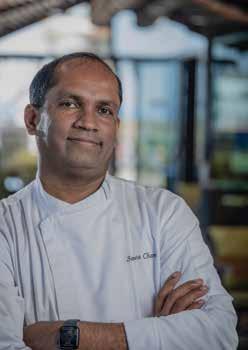




Chef Tarek Mouriess on dismantling run-of-the-mill CVs and why your actions today echo far beyond the kitchen
Smarter Way to Cater
How Progressive Web Apps Are Transforming Catering Operations
to Brilliance
Chef Carl Shi on rethinking food waste in professional kitchens (part 1)
Right Way To Store Boxed Beef & Lamb
Sulemana A. Sadik on why temperature and time matter for the quality and yield of chilled and frozen meat
on the Menu
Dr. Taghreed Aljaffal shares how human-centred culinary sustainability puts people, wellbeing, and tradition at the heart of every meal
Home Is Where the Heart Is
Dhanushka Navod, Pastry Sous Chef at W Dubai, is turning sugar, chocolate, and mango into edible stories
Where Wild Meets Wonder
Inside Alaska Seafood Marketing Institute International Culinary Retreat 2025!
Snapshots from the latest guild meeting
Membership Directory
A listing of all the leading food, beverage, and equipment suppliers in the region
Simon Says
Simon Martin, Executive Chef at Kerry Taste & Nutrition (Food Service), shares the latest culinary trends, from playful flavor pairings to indulgent comfort foods and multisensory experiences that surprise diners
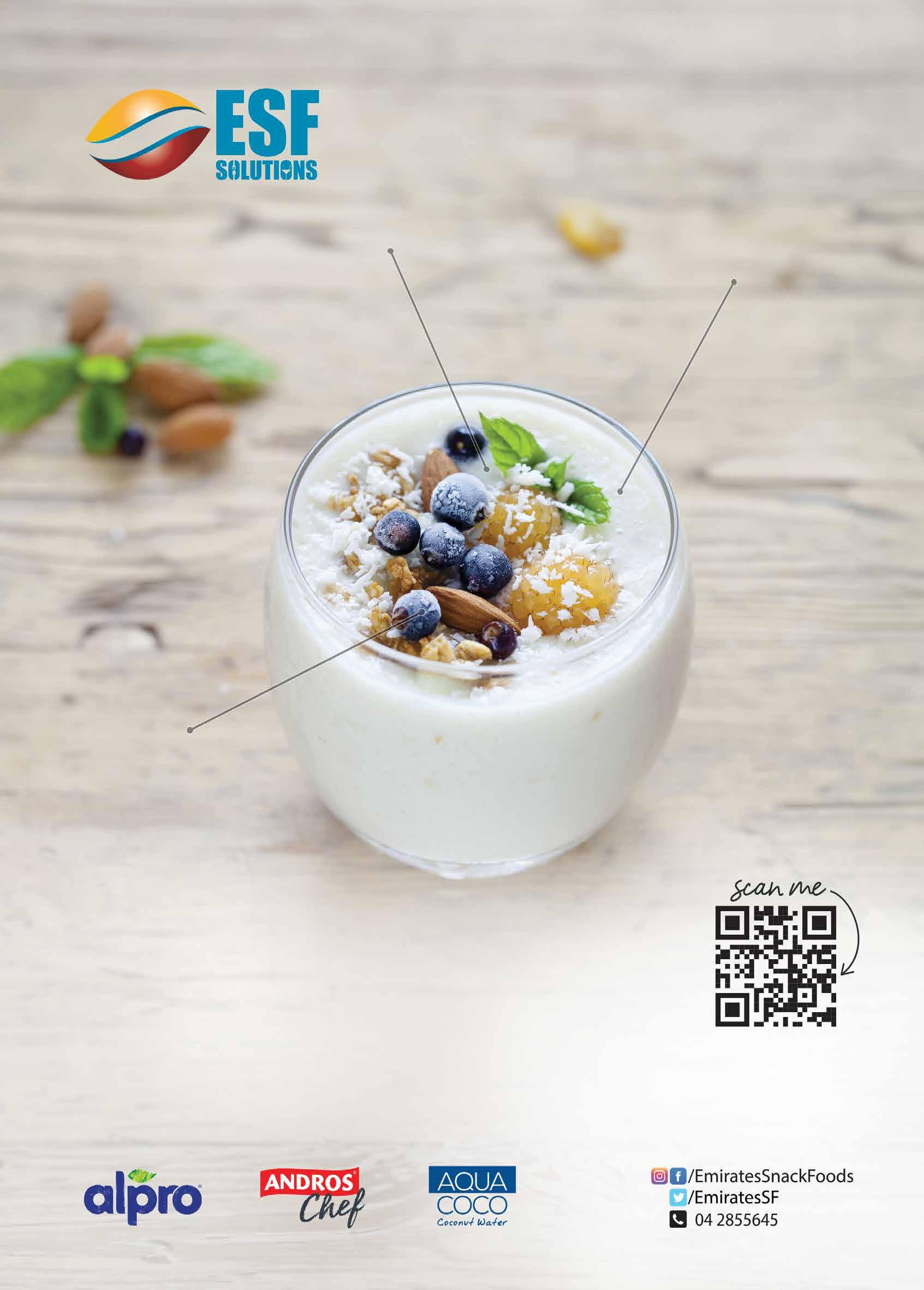

friends of the guild

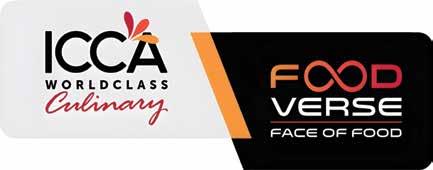














































newsbites
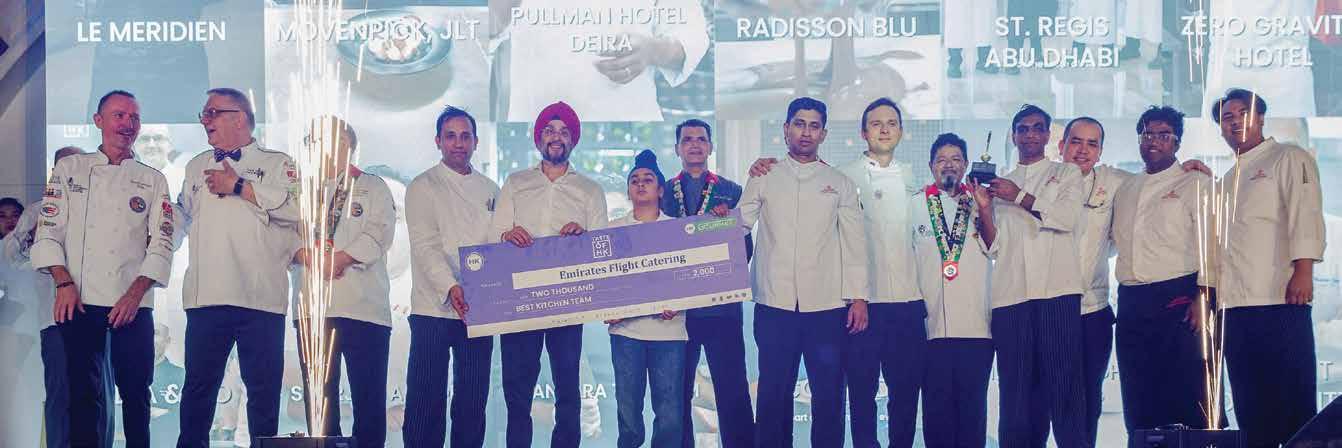
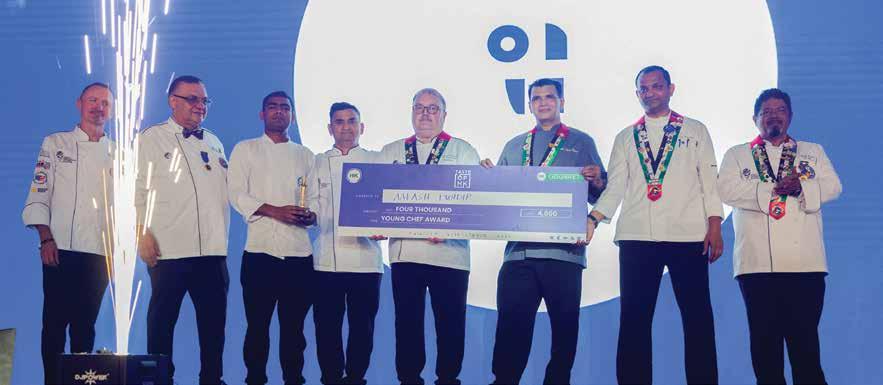
Cooking Out of the Box!

The Taste of H.K. Black Box Challenge 2025 brought Dubai’s top chefs together for a night of creativity, competition, and culinary brilliance
The second season of the Taste of H.K. Black Box Challenge saw the UAE’s leading culinary talents come together for an evening of creativity and competition at Zero Gravity, Dubai.
Hosted by HK Food Group and chaired by the Emirates Culinary Guild, the event featured 12 teams competing to create a four-course menu from mystery and sponsor-provided ingredients, testing their creativity, precision, and teamwork.
The event marked another successful edition of Taste of H.K., celebrating culinary innovation, collaboration, and the region’s exceptional talent. ■
Champion: Mövenpick JLT
Runner-up: Intercat
Best Kitchen: EKFC
Best Service: Mövenpick JLT
Best Young Chef: Chef Aakash
Pundir, Zero Gravity
Best Duck Dish ( USAPEEC): Anantara The Palm
Gold Medalists
Mövenpick
Intercat
EKFC
Zero Gravity
Silver Medalists
St. Regis Abu Dhabi
Radisson Blu Dubai Deira Creek
Pullman City Centre
Abela Catering
Le Meridien Dubai Airport
Conrad Abu Dhabi
Alpha Catering
Anantara The Palm


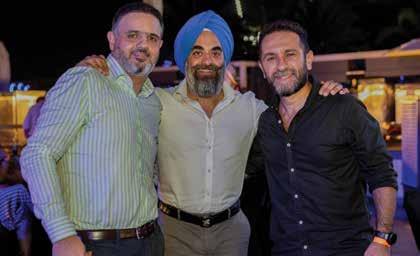
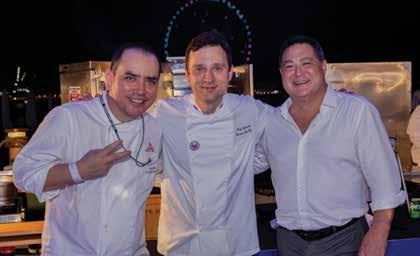
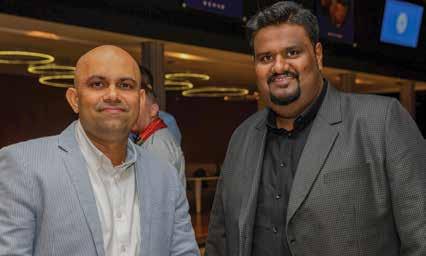
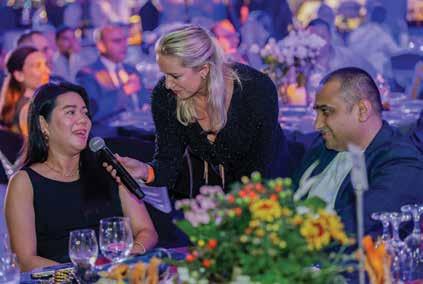
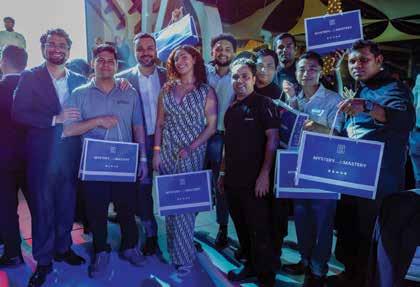
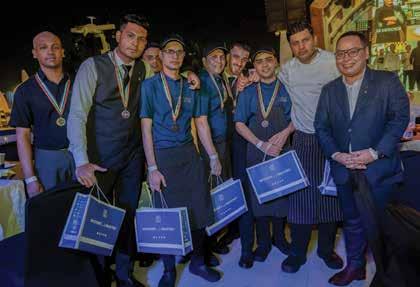
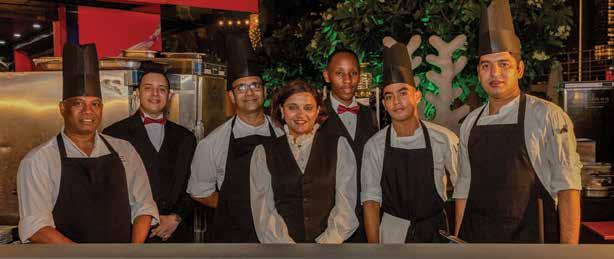



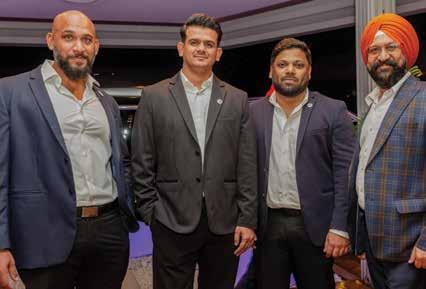
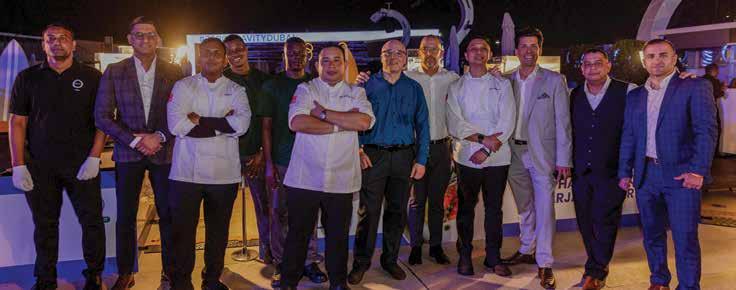


A Bite of
Pan-Asia
How do you create layered Pan-Asian flavors without overcomplicating the dish? In an exclusive Q&A, Lin Naing Soe, Head Chef at ATTIKO Dubai, explains exactly how he balances flavors, techniques, and inspirations to serve palatable Pan-Asian dishes
Growing up in Myanmar, how did your upbringing and culture influence your early relationship with food?
In Myanmar, food was always part of family life. We didn't just eat together, we connected through food. I remember sitting with my family, sharing meals made from simple ingredients that were full of flavor and meaning. My mother
never followed recipes. She cooked from the heart. That's how I first fell in love with cooking. It wasn't just about the food; it was about the feeling it gave us. That's what inspired me to become a chef.
Your mother’s advice that “cooking with love is the most important ingredient” is beautiful. How do you
bring that philosophy into a highpaced commercial kitchen?
Even when the kitchen is moving fast, I always try to keep that advice in mind. Cooking with love means being present, paying attention, and caring about the details. I remind my team that every dish is for someone who came here to have a special moment. We don’t just cook
We didn’t just eat together — we connected through food
food, we create experiences. Love in the kitchen shows up in the small things, like using the freshest ingredients, seasoning carefully, and plating with care.
You have had over 16 years of experience in the Middle East. What initially drew you to the region? At first, I came here out of curiosity. I wanted to learn, grow, and experience something new. The Middle East is full of diverse tastes, cultures, and ingredients. It pushed me to be more creative and to understand how to make Pan-Asian flavors connect with local guests. Over time, it became a place where I built a career, made friends, and found a new home.
Can you walk us through the process of creating a new dish for the ATTIKO menu, from idea to final plating?
Do you start with the flavour, the ingredient, or the visual concept first? It always starts with one idea. Most of the time, I start with the ingredients. I might find something fresh and in season, and I start thinking about what flavors would work with it. I ask myself, “What texture does it need? What feeling should this dish give someone?” Then I build the flavors, and finally, I think about the presentation. The final plate should look beautiful and also make sense in terms of taste and the story behind it.
How do you balance the need for kitchen efficiency with maintaining authenticity when using regional ingredients that may not be available locally?
Sometimes the exact ingredient isn’t available, but we can still preserve

the soul of the dish. We look for the closest possible match that offers a similar taste or texture, and we use authentic cooking methods to keep the dish’s spirit intact. It’s about honoring the culture while adapting to what’s available. For example, one of our dishes originally used shredded yuba for its delicate texture, but since it’s not always easy to source fresh yuba locally, we explored alternatives. We ended up using kataifi pastry instead. It gave us that same crisp, nest-like texture and added a subtle buttery note. It was a creative solution that stayed true to the dish’s intent while adding a local touch that made it our own.
How do you approach layering umami in Pan-Asian cuisine without overcomplicating the dish? Umami is all about depth of flavor, but it should never be too strong or heavy. I use natural ingredients like miso, soy, or fermented vegetables, but I always use them in the right amount. The goal is to make the dish taste full and satisfying without losing its simplicity.
When it’s done right, umami should feel natural, not forced.
How do you balance innovation and sustainability when designing a menu meant to appeal to diverse palates? I try to keep things creative but also responsible. I use local and seasonal ingredients as much as I can. Instead of flying in every special item, I look for ways to work with what’s already available nearby. That forces me to be more inventive, and sometimes the results are even better. Sustainability should be part of creativity, not something separate from it.
What is the philosophy of your culinary direction that feels fresh and modern while still staying true to the essence of Pan-Asian cuisine? My approach is to respect traditional flavors but present them in a new way. I keep the balance, spices, and spirit of Pan-Asian food, but I use modern techniques and cleaner, more elegant plating. At ATTIKO, I want each dish to feel both familiar and exciting.
Something that tells a story, but also feels fresh and current.
Your dishes combine Japanese color theory, aromas, and refined presentation with Asian spices and simple ingredients. How do you balance making sure the dish looks as good as it tastes, without one overpowering the other?
I aim for balance in everything. A dish should look beautiful, smell amazing, and taste even better. Every element on
the plate is there for a reason. It’s not just about decoration. The colors and plating should guide the guest into the full experience. But the flavor is always the most crucial part. I never let the looks take away from the taste.
What has been the most challenging dish you have created, whether in terms of execution or in capturing a specific emotion or memory?
Recreating Mohinga, a dish deeply tied to my childhood, was one of the most
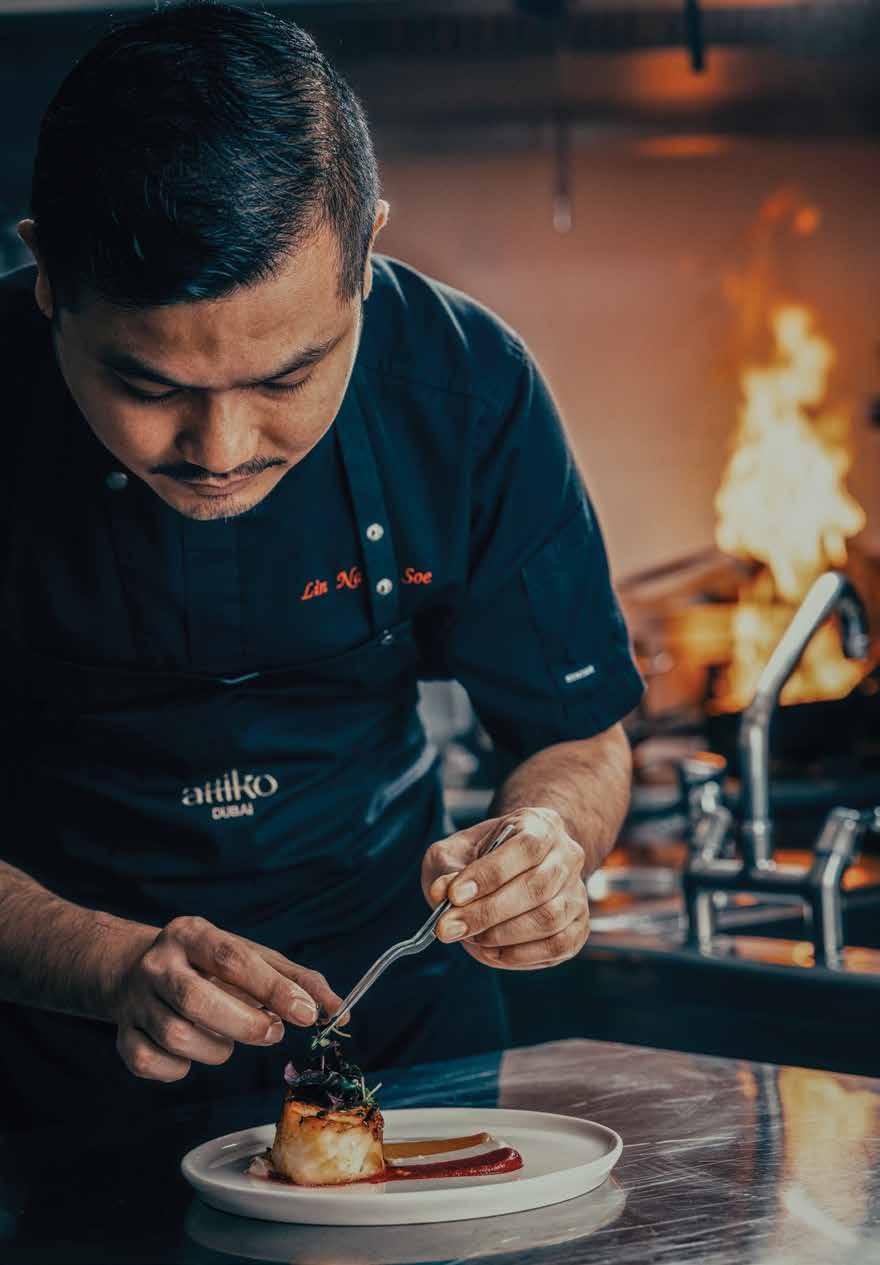
challenging yet meaningful experiences in my career. It was my grandmother’s signature dish, and for me, it represented comfort, love, and home. I wasn’t just trying to recreate the flavor. I wanted every bite to carry the warmth and memory I grew up with. It took weeks of testing the broth, balancing the spices, and getting the texture just right. But when I finally tasted it and felt that emotional connection come through, I knew I had brought a piece of my past into the present.
In the long term, how do you see PanAsian cuisine evolving in the Middle East, and how do you plan to stay ahead of the curve at ATTIKO?
Pan-Asian food is gaining popularity, and people here are starting to look beyond the usual dishes. They’re more open to trying things from different parts of Asia. I think we’ll see more variety and more storytelling behind the food. At ATTIKO, we’ll keep pushing by being curious, trying new ideas, and always staying connected to the roots of each dish. To stay ahead, we must continue learning and exploring.
What is the one feeling or memory you hope guests take away from their dining experience at ATTIKO Dubai, beyond just the food?
I want people to leave feeling something special, like they were taken on a small journey. It’s not just about being full. It’s about the way the flavors made them feel, the atmosphere, the view, the care behind every detail. I hope they leave with a warm memory that stays with them, even after the night is over. ■
Cooking with love means being present, paying attention, and caring about the details

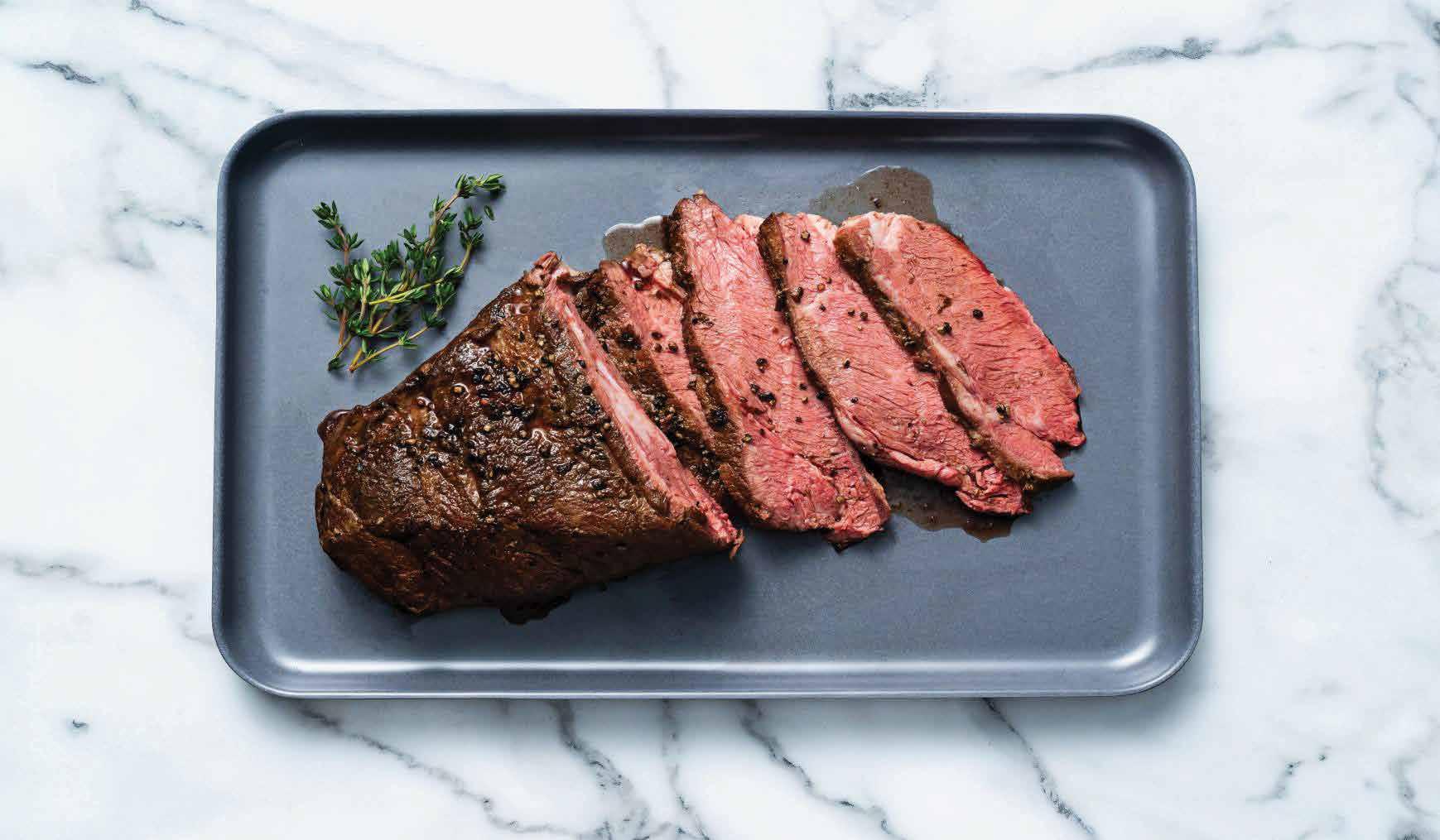

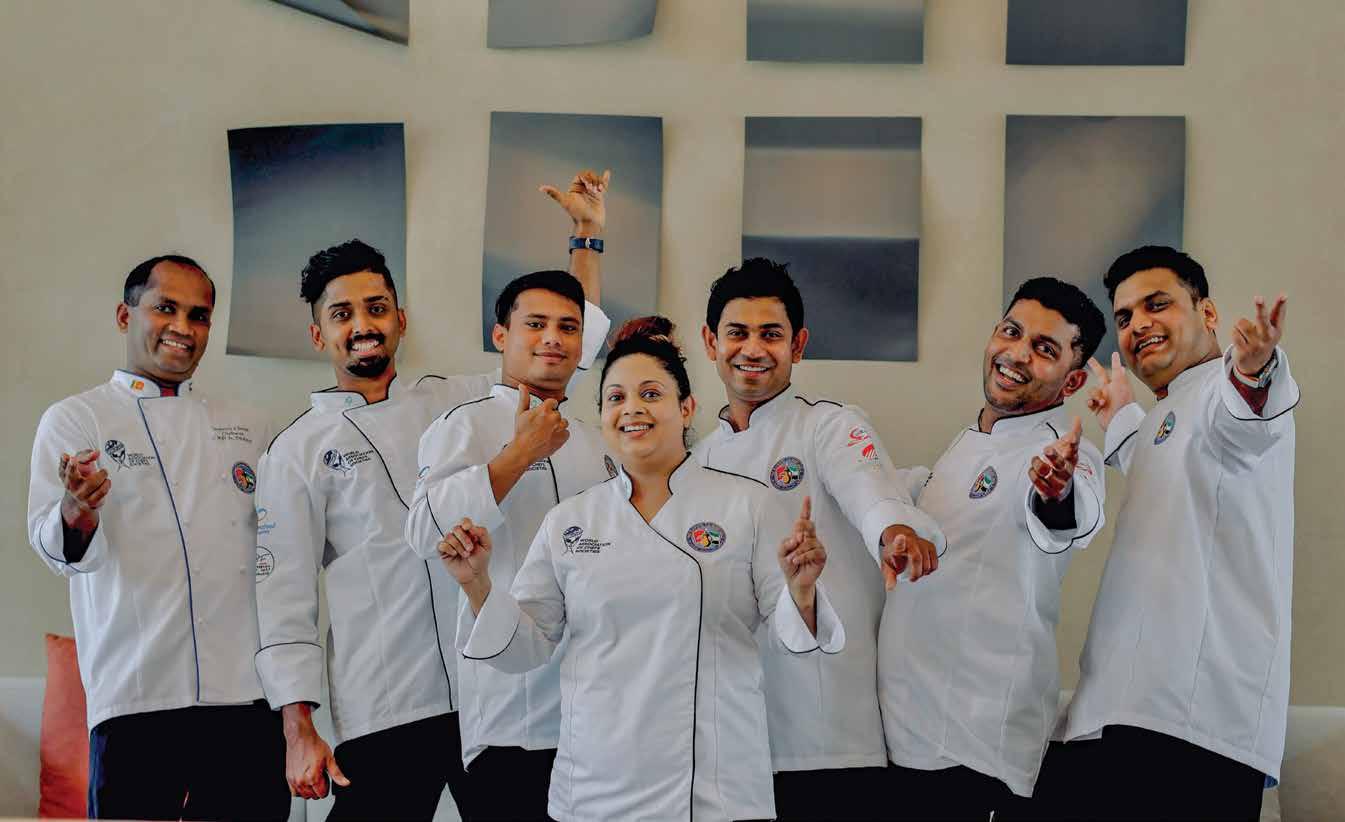
The Coral Championship Chronicle
Meet the culinary aces of FHAM Global Culinary Challenge 2025. With confidence as their middle name, the UAE Emirates Culinary Guild team turned months of preparation into a glittering haul of 21 medals
The Emirates Culinary Guild team continues to build on its winning streak at the eighth edition of Food and Hospitality Asia Maldives (FHAM) Global Culinary Challenge. Close on the heels of their previous triumph, the young team returned victorious with 21 medals, including five gold with distinction. They once again stole the show, earning the Most Outstanding National Team Award, defending their title for the third time.
Co-scripted under Chef Sanjeewa Chamil’s leadership and backed by a network of mentors and supporters, the team executed every challenge flawlessly. Chef Dinesh Kinson conjured gold from sugar, chocolate, and technique, claiming the Best Pastry Chef. Rising to every challenge,
We practiced weekly for months before the competition. Every sleepless night was worth it when we stood on that stage
Chefs Tharishma Mendis, Romani Liyanage, and Nishan Nayana Kantha faced high-stakes cook-offs undaunted, finishing on the podium. Meanwhile,
Chefs Krushnath Jadhav, Avinash Sahoo, and Nishan Nayana Kantha, with their confidence unshaken, turned every moment into medal-winning execution. Gulf Gourmet caught up with every team member, fresh from an encore that exceeded even their own expectations.
Such success, of course, would not have happened without a mentor like Chef Sanjeewa Chamil. The ECG Chairman of Abu Dhabi & District, Chef Sanjeewa, has let them bring out the best in themselves.
As the Cluster Executive Chef at Radisson Blu Hotel Abu Dhabi Yas Island, he is currently managing six hotels with 22 food & beverage outlets and leading a brigade of over 100 chefs. Despite the scale of his responsibilities, he still finds
Dinesh Hashan Kinson
Hilton Abu Dhabi Yas Island
Best Pastry Chef (Trophy)
Full paid chocolate course from Dubai by Nestlé Maldives.
Petits Fours or Pralines (Pastry) – Gold Distinction
Dress the Cake (Pastry) – Gold
Team Event - Hot Cooking (Three-Course Meal) – Gold
Distinction
Artistic Pastry Showpiece (Pastry) – Gold Distinction
Tharishma Madushanka Mendis
Royal Keita Catering L.L.C
Artistic Pastry Showpiece (Pastry) – Gold
Dress the Cake (Pastry) – Gold
Fruit & Vegetable Carving – Silver
Nishan Nayana Kantha
Radisson Blu Hotel Yas Island
White Fish Hot Cooking – Gold
Team Event - Hot Cooking (Three-Course Meal) – Gold
Distinction
US Beef Hot Cooking – Gold
Plated Three-Course Meal – Gold
time to guide young chefs and lead the UAE team in international competitions.
“Since 2003, when I came to Dubai, I dreamed of participating in competitions and eventually becoming a culinary judge. Over the last three years, I have focused on guiding young chefs and taking teams to international competitions under the support of ECG,” he explained.
Walking us through the preparation timeline, he takes us back three years ago, when he began mentoring the team for the FHAM Global Culinary Challenge. “We started small, with three chefs. In our first year, we won the Best National Team award and several gold medals. The next year, we repeated that success. This year, we expanded the team to six people with two artistic chefs, four hot kitchen members, and the results were incredible.”
The competition spanned three intense days, but the team had been preparing for months. “We practiced weekly for three to four months before the competition. With Chef Peter, we finalized the categories to participate across, covering everything from artistic events to hot kitchen challenges, and the team handled everything perfectly.”
Abinash Sahoo
Crowne Plaza Abu Dhabi Yas Island
Faham Best Chef Award
Poultry - Hot Cooking – Gold
US Beef - Hot Cooking – Gold (Top Winner)
Yellow Fin Tuna - Hot Cooking – Gold Distinction
Dunar Rice Creativity - Hot Cooking – Gold
Top Winner – Full paid tour to India (Dunar Rice Factory)
Romani Liyanage
Radisson Blu, Yas Plaza Hotels
Poultry Live Cooking – Gold
Seafood Live Cooking – Gold
Beef Live Cooking – Gold
Asian Noodle Challenge – Bronze (Top Winner)
Krushnath Jadhav
Crowne Plaza Yas Island
Lamb Live Cooking – Gold
Beef Live Cooking – Gold (First Runner Up)
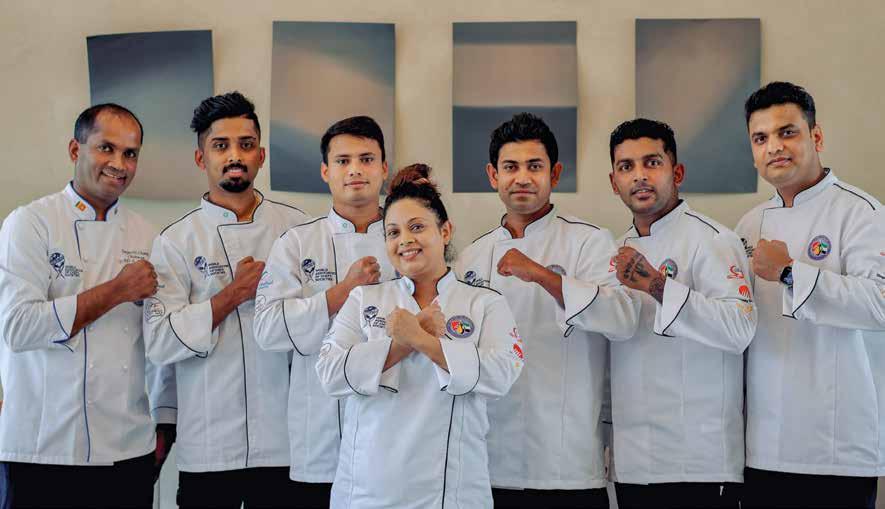
The results spoke for themselves. “We earned 21 medals, including five gold with distinction, alongside a silver and a bronze in highly competitive categories. Even the bronze, awarded in the live noodle cooking category, was top of the category, a remarkable achievement,” Chef Chamil noted, recalling the long days and sleepless nights of the competition.
Under his leadership, the team also took home special recognitions. He was confident about the Best Chef and Pastry Chef awards, but then came the spontaneous announcement
that amused him. “During the award ceremony, we received our gold medals, and then we were surprised to win the Most Outstanding National Team Award for the third time. We had strong teams from Qatar and Sri Lanka, and we made our mark. It was a great moment for us.”
In a world where no one simply takes time out of their demanding schedules, Chef Chamil does it out of passion for mentoring. “I manage my time to guide them, so that we set a high benchmark for culinary excellence. It is all about passion, guidance, and innovation.”
His mentorship also extends to emotional preparation. “It is important to prepare for mental and emotional readiness and make sure to understand the purpose and targets. We had a passionate team. Experienced mentors like Chef Peter, myself, and the support from the Guild and our partners ensure they practice 200% to achieve the best results.”
He further adds, “ The Emirates Culinary Guild supported us throughout, and our sponsors and partner organizations also helped a lot. I also thank Chef Andy, Chef Alan, Chef Uwe, Chef Peter, and the Yas Plaza Hotels. This achievement was a team effort.”
Setting his sights on the next milestone, Chef Chamil is already preparing the team for the Culinary World Cup. “ I aim to achieve 100 gold medals and continue to support the team, making sure they remain a leading team on the world culinary stage,” he affirms.

Undistracted and Unstoppable Competition mornings are rarely easyanxiety, last-minute fixes, and sleepless nights are all part of the grind. Yet Chef

Tharishma Madushanka Mendis thrived under the pressure. “The secret is to focus on the result. Think about what you have to do next. Do not let anything distract you. Keep your main focus on the task and the goal. That is how you win.”
Keeping distractions at bay, he tackled all four categories, from artistic pastry showpieces and chocolate carvings to live cake dressing and fruit and vegetable carving. By the end, chocolate carving and cake dressing earned gold, while vegetable carving brought home silver.
For Chef Tharishma, Junior Sous Chef at Royal Keita Catering L.L.C., this was not her first taste of pressure at FHAM. He had also competed last year, and behind every medal, there were mentors who charted his path. “ Chef Sanjeewa and Chef Peter, in particular, helped us through every step and gave us lessons to perform our best.”
Chef Tharishma also credits his wider support network. “A special thank you to my Pastry Chef, Krishman Priyanga; Executive Chef, Joman Plakkal; CEO, Mr. Richard Mathias; and Operations Manager, Mr. Kenneth Anthony Andrews. I am also grateful to the Emirates Culinary Guild
Dinesh Hashan Kinson, Sous Chef, Radisson Blu Yas Island
Tharishma Madushanka Mendis, Junior Sous Chef, Royal Keita Catering L.L.C
and our President, Chef Andy, for their dedication to the culinary community.”
Mindset Matters, Medals Follow At the FHAM Global Culinary Challenge, Pastry Sous Chef Dinesh Hashan Kinson of Radisson Blu Yas Island turned sugar, spice, and skill into pure gold. Winning Best Pastry Chef, Gold Distinction in Artistic Pastry Showpiece, Gold Distinction in Team Event Hot Cooking (Three-Course Meal), Gold in Dress the Cake Pastry, and Gold Distinction in Petits Fours or Pralines Pastry, Chef Dinesh says he went in with one simple thought, “We have a good team, and I knew we could do it.”
“This was my second time competing. After my first experience, I knew we could aim higher. So before going there, I told myself I would do this. And I did because I had faith in myself,” he adds.
Managing stress at such a competitive level is not easy, but for him, it is all in the mind. “Of course, it is stressful. Sometimes you do not even sleep at night. It is a mental game. Prepare your mind. If you think about winning, then you will win,” he explains.
Looking ahead, Chef Dinesh is also gearing up for the World Cup challenge. “I am going for the Culinary World Cup with the UAE team, competing in the artistic category,” he shares enthusiastically.
Chef Dinesh, with his belief and discipline, can turn talent into excellence, and excellence into gold. Along this journey, he has a whole squad of chefs to tip his hat to for their encouragement. "A very special thanks to Chef Eranda, his faith in me, and his guidance shaped me more than words can express. He always pointed me in the right direction, never giving up on me. My sincere thanks to Chef Dammika, Chef Patum, Chef Sanjeewa, and Chef Peter. Their trust, support, and constant presence have been my anchor. I carry their lessons and kindness with me always," he adds with gratitude.

Practice and refine your skills every day. Even for competitions, start months in advance
Preparation Goes A Long Way
Though it was his first international competition, Chef Avinash Sahoo was far from a rookie when it came to plating with panache.“ I did my best and got the results. I earned gold medals in all four categories I competed in, which were Dunar Rice Creativity, Poultry, Yellowfin Tuna, and US Beef,” says the Junior Sous
Having already made his mark in the local culinary scene, Chef Avinash brought experience from competitions like Salon Culinaire, where he also earned medals. “Those competitions also taught me the value of discipline, attention to detail, and experimenting with flavors,” he says.
To him, preparation is everything. “Think ahead and plan your schedule. Lock in your tasks before you execute them. Practice and refine your skills every day. Even for competitions, start practising months in advance. Often, it is as simple as doing your best with the work you already do. Whatever you are doing in your hotel or restaurant, do the same. Do not try to do anything extra, but give it 100 percent.”
Chef, currently working at the Crowne Plaza Abu Dhabi Yas Island.
Avinash Sahoo, Junior Sous Chef, Yas Plaza Hotel (Crowne Plaza)
Practice Makes Perfect, And Perfection Tastes Like Gold
This was Chef Nishan Nayana Kantha’s third time competing at the FHAM Global Culinary Challenge. Reflecting on the experience, he says, ‘For me, this feels like going home. Last time I won a gold, and this time again. It feels familiar, comfortable, and motivating.”
The Junior Sous Chef in the hot kitchen at Radisson Blu Yas Island brings extensive competition experience, winning medals at Salon Culinaire and the Culinary Olympics. Speaking about his time competing in the Maldives, he adds, “It was really nice, actually, really exciting. We got a great opportunity and gained valuable experience.”
Chef Nishan competed in the white fish hot cooking, US Beef Hot cooking, plated three-course meal, and team event hot cooking. Impressively, it was a clean sweep. “All of them gold,” he confirms proudly.
When asked about the key to success, Chef Nishan zeroes in on persistence and practice. "We practised many times, and finally we got it. The main thing is practising with the ingredients, using both familiar and unusual ingredients. In my experience, it is mostly about practice, focus, and managing your time well."
Fundamentals First
The basics build the masterpiece, and for Chef Romani Liyanage, Chef de Partie at Belgium Café of Radisson Blu Yas Island, those words have directed every move she made in the competition.
“It was a wonderful experience,” she recalls. “It had been some time since my last competition in 2024, so I felt both nervous and excited at first. But once I started, the confidence returned.”
Chef Romani took part in four categories, earning gold in Seafood, Beef, and Poultry Live Cooking, and bronze in the Asian Noodle Challenge. "The noodle challenge was tough; only one hour to
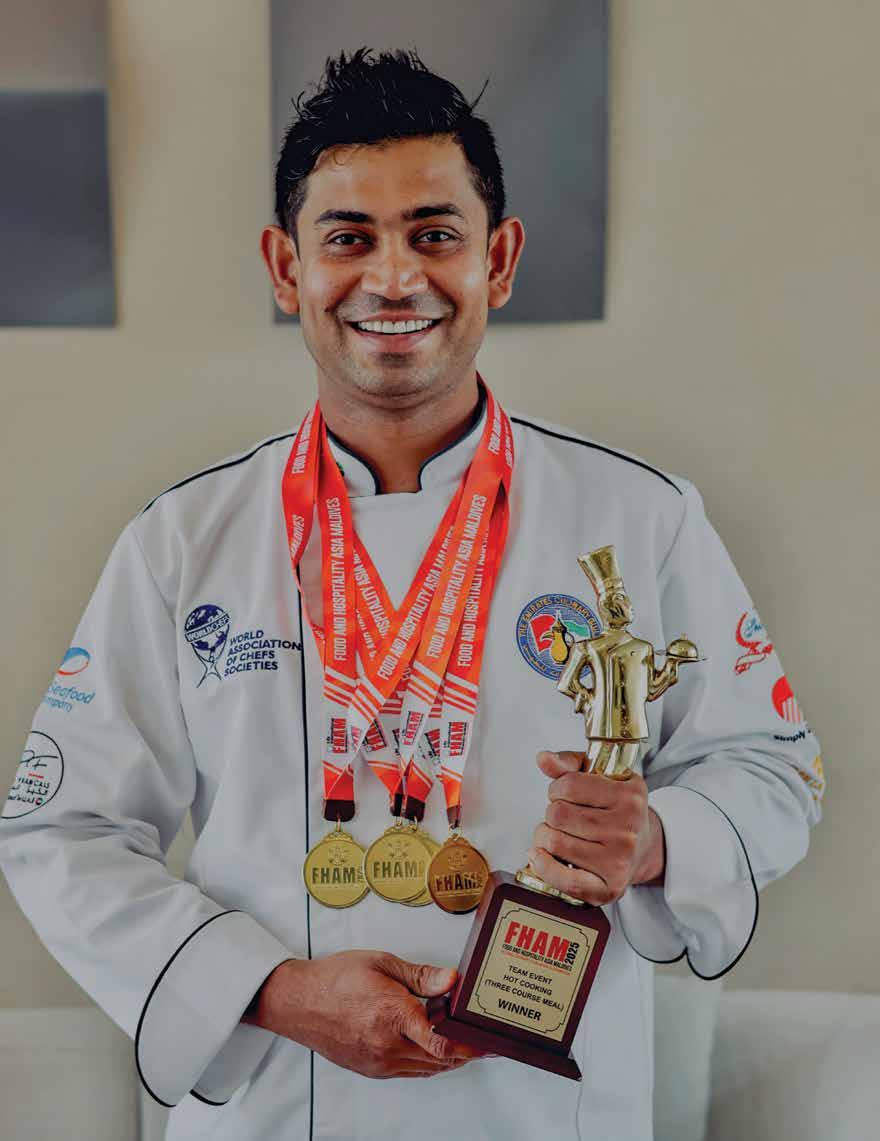
Even during shifts or free time, try to practice,” she says, an ethos that translated into medals and experience.
The main thing is practice. Work with the ingredients, stay focused, and manage your time well
finish everything. Still, it turned out to be a great learning experience," she said.
Preparation and mastery of the fundamentals matter the most to her. “You have to learn the basics thoroughly. Then you time your execution, add your creativity, and push boundaries. Research helps; follow Michelin-star chefs and check social media trends for inspiration. Sacrifices are necessary.
Every Win Is A Lesson In Gold
Among the many lessons at FHAM, one golden takeaway for Chef Krushnath Jadhav came from Chef Uwe. “Chef Uwe was in the judging panel, and he explained to us that the first medal you earn, be it bronze, silver, or gold, is like gold because out of so many participants, you have managed to win a medal. That is your achievement. You must learn from your judges’ advice and be like a sponge. Observe, absorb, take suggestions from seniors, and build on them. Every medal teaches us to be better,” shares Chef Krushnath.
And observe and absorb he certainly did. The Executive Sous Chef at Yas Plaza Hotel also stepped into a larger role this competition, assisting Chef Sanjeewa
Nishan Nayana, Junior Sous Chef, Radisson Blu Yas Island
Observe, absorb, take suggestions from seniors, and build on them—be like a sponge
behind the scenes. “While Chef Sanjeewa had previously handled most of the responsibilities, this year I assisted in making sure that timings, scheduling, recipes, and transportation were all running smoothly. This was my first hands-on experience learning all of this from him,” he reflects.
But the lessons did not stop there. Beyond managing logistics, Chef Krushnath was fully involved in the kitchen. “I wanted to contribute as much as possible to the team and win as many medals as we could. I worked on two classes, Beef Live Cooking and Lamb Live Cooking, and earned gold in both.”
Competitions, to him, are as much about learning as they are about winning. “This is a continuous journey. I am absorbing knowledge from senior chefs. Chef Sanjeewa also wants to pass on knowledge to me so that in the coming years, we can take more junior chefs and new talents to different competitions,” he explains.
Looking ahead, he is already preparing for future challenges. “Next year, we plan to participate in the Worldchefs Congress in Wales. Chef Sanjeewa will lead, and I will follow in his footsteps,” he says, eager to continue learning and collecting more lessons along the way.
With the team and their mentors attaining a phenomenon of culinary brilliance, it seems that in competitions, for them, the only thing impossible is… well, nothing. ■

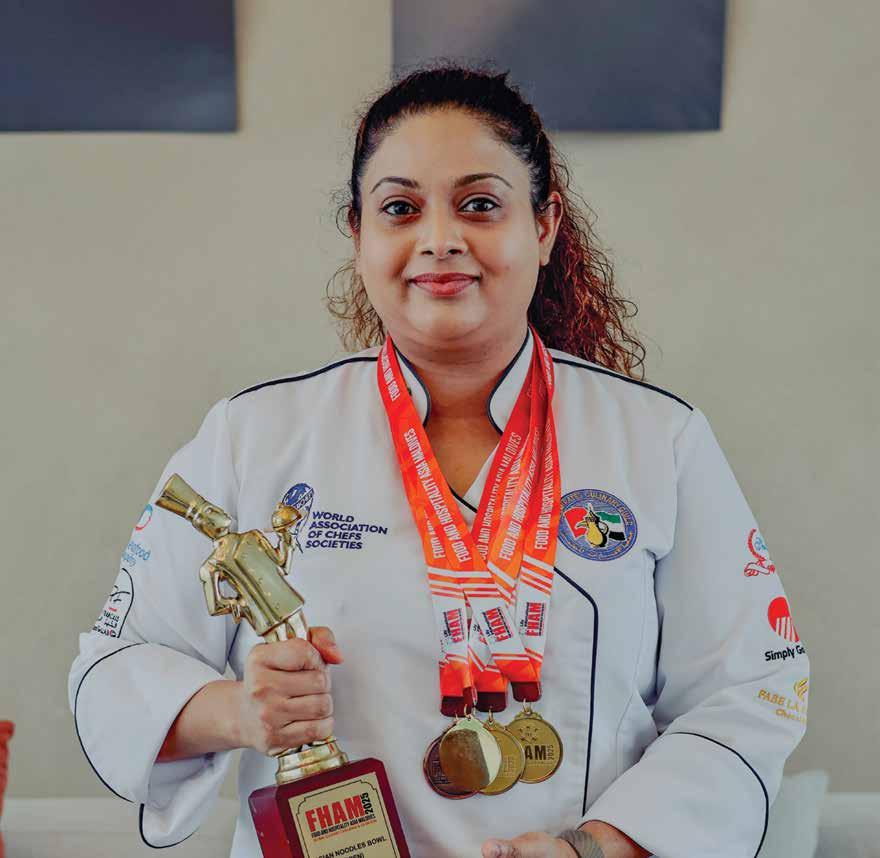
Romani Liyanage, Chef De Partie, Belgium Café, Radisson Blu
Krushnath Ramesh Jadhav, Executive Sous Chef, Yas Plaza Hotels, Yas Island Abu Dhabi
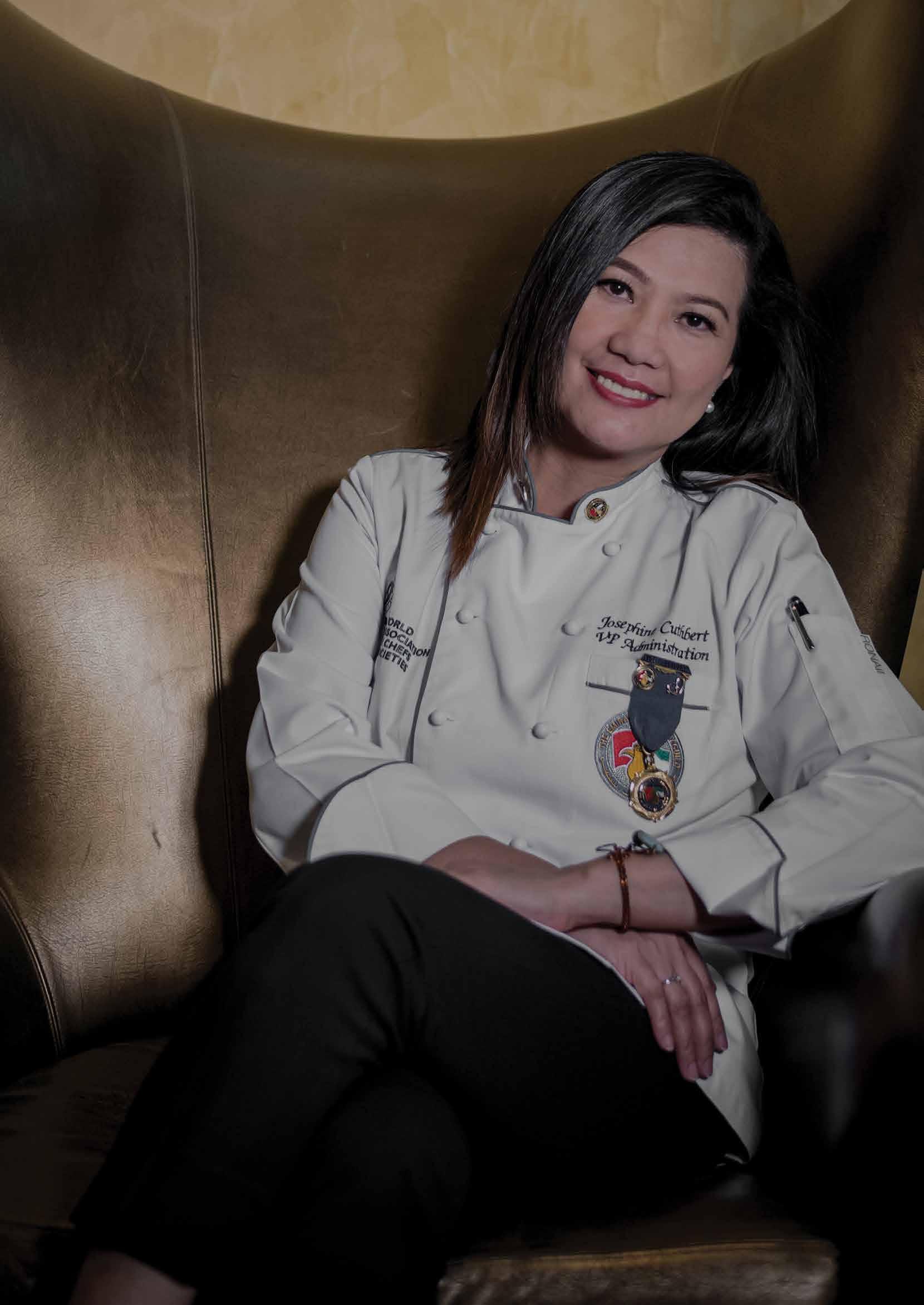
It Happen
With her vast experience in streamlining culinary initiatives and creating cohesion across the competition workflow, Josephine Cuthbert, Vice President of Administration & Affairs of the Emirates Culinary Guild, is bridging day-to-day operations to the Guild's broader culinary vision
Madame Maketh
Winners stood on the stage, faces alight with joy and triumph, after a nervebattering Salon Culinaire competition. The room thundered with applause and the gleam of camera flashes. The newly crowned Best Young Chef descended from the stage, medal glinting, making his way through the crowd, shaking hands and thanking mentors, until he reached Madame Josephine Cuthbert, standing as always at the edge of the stage, clipboard in hand, keeping the competition on track.
“Thank you,” he said, shaking her hand with earnestness and gratitude for enduring the headache of his endless, enthusiastic questions about the competition rules.
It is these heartfelt messages of gratitude from chefs after competitions that Josephine finds most rewarding. "When I see chefs win awards, it makes all the times they reach out to me with tricky questions about the competition rules, all the prep, and every challenge feel worthwhile," says Josephine.
The Organiser Extraordinaire, Josephine, is meticulous and dependable, offering guidance on rules and regulations when young chefs find themselves unsure of where to start. “I act as a liaison between the chefs and the guild,” she explains. “Preparing for the Salon Culinaire starts six months in advance for me, coordinating schedules, registrations, and requests while providing clarity on rules and regulations for young chefs who may be unsure how to get involved. My role is to support and guide them as they navigate the competition.”
The wearer of many hats, Josephine does it all with a smile. Always quick and genuine, she softens the formality of her role while keeping everything running smoothly. Much has already been said about her alacrity in moving through every task, qualities that explain why she is regarded as the administrative heart of the Guild. The reality, however, is far
To cultivate great ideas, you need to be surrounded by great people
more nuanced. As she puts it, preparing the ground for great dreams meant her lifetime was about supporting others. “And I do not really expect anything in return. My main goal is to achieve results. But I cannot do this alone. I have a strong support system of excellent chefs, the committee, and the marshals. Without the team, nothing would have been possible.”
Recognition is not something she chases, yet the Guild has found ways to celebrate her contributions time and again. "I was surprised when President Thomas Gugler summoned me to the stage and presented me with the President's Medal, recognizing my efforts toward the Guild's competition and events".
The Keeper of Calm Josephine's career maps a course of learning to stay one step ahead in dynamic environments. This was evident early when she worked as a personal assistant to three directors. "I learned a great deal about foresight and discipline during the six and a half years I spent in this role. Working with people from different walks of life broadens your way of seeing the world."
A similar thread of mining wisdom from a mosaic of voices pervaded her earliest days with the Guild. "I first helped the Guild with registrations in 2001. That was when I observed how people from different professions- secretaries, managing directors, general managers, chefs, and F&B leaders- came together and shared ideas openly, setting aside their titles. Everyone respected each other's opinions, which helped us make
informed decisions. That was the kind of environment I wanted to be part of. To cultivate great ideas, you need to be surrounded by great people."
Buoyed by this inclusive environment, she stepped into her first responsibilities as assistant coordinator in December 2004, learning about the competition database under Chef Alen’s guidance. A year later, she was handling competitions confidently. “I was lucky to learn the nittygritty from Chef Alen Thong and Chef Uwe Micheel. It was a process of learning and growing,” she says, noting that growth came as an accretion of know-how.
Reasonably, an increasing number of members meant higher expectations, and more competition left only a shoestring margin for error. Despite these benchmarks, the echoes of curiosity from meeting people of diverse nationalities and cultures kept her work from calcifying into a demanding routine.
Integrity remains the fulcrum of her work. “I will never jeopardize the ECG’s integrity for anyone. The committee and the president are fully informed of all my decisions throughout the process. Compromising integrity is not an option."
While registrations this year ran on the Foodverse app, earlier competitions had Josephine as a sentinel, gathering judges' results, and supporting competitors through any confusion. Her equanimity came in handy when dealing with the conundrums that arise when rejudging queries.
“One of my main challenges during competitions is to guarantee transparency and accuracy in the judging process. Competitors can feel frustrated if they believe there is a discrepancy in results, so it is important to handle these situations carefully,” she explains.
Maven Behind the Scenes
Another year of heightened anticipation for Salon Culinaire beckons, and Josephine is already focused on what
lies ahead. “In the upcoming edition of our competition, I want to create more opportunities for our corporate partners and members,” she says.
Among the ideas she hopes to bring to life in the upcoming edition, she gives equal importance to inclusivity. “We already have talented female chefs in our membership, and I want to encourage more women to participate, attend guild events, and engage in educational experiences,” she explains. “Moreover, our membership now spans over 250 nationalities, including Moroccan, Mauritian, Nepalese, Vietnamese, and Japanese chefs. Each represents a story of belonging, and it is important to highlight inclusivity not just within the Guild, but across our competitions as well.”
Leadership, she believes, is wedged between persistence and participation. “Even if you fail, you try again. Growth happens step by step; there is no elevator to the top. Being proactive is key. Even if a task is not part of your job description, when you take the initiative, you are not just helping yourself; you are alleviating the burden for others.” It is this practice of seeing things through that became a footnote to her story and collective efforts that positioned the ECG on the international stage, endorsed by the World Association of Chefs Societies (Worldchefs).
But long before the Guild's international acclaim, Josephine was finding perseverance in the ebb and flow of her early roles, starting at a coffee shop.
I thought the coffee shop would be small,” she laughs, “but this one was huge, and as the only woman on the floor, the role of waitress was challenging. Working alongside colleagues from around the world, the first days were tough. Over time, the chaos of the floor became manageable, and I earned their trust. Success depends on taking initiative; if you want something, you have to go for it. Believing in that, I earned a promotion

Growth happens step by step; there is no elevator to the top
within a year to a fine dining restaurant as a hostess,” she shares, looking back at her learning curve.
She continues, “You must have clear goals. Think about where you want to be in five years and what you hope to achieve in ten. If you are determined, you can achieve anything.”
Success, however, is easier to attain with the guidance and support of loved ones, as evidenced by the presence of her husband, Andy Cuthbert, founding member of the Emirates Culinary Guild and President of Worldchefs.
Josephine met Chef Andy in 1992, “My first impression of him still makes me chuckle. From the kitchen came this loud, confident voice, and then he burst into the coffee shop with all his energy and focus. He had a handlebar moustache back then, which only made him look more intense.”
Josephine found herself charmed by Chef Andy's easy patience and effortless way with people. Friendship grew into love, and by her birthday in October 1992, Chef Andy cooked up the ultimate surprise: a proposal. "In May 1993, we tied the knot.
I was 22, he was 28, and together we began a lovely new chapter. We had two sons, Kyle and Cody, who are our greatest joy," she recalls with a fond smile.
In those early years, Josephine quickly noticed how Andy poured himself into his job, putting in 18 to 20 hours a day. She remembered being pregnant with their first son at Christmas, while he came home at midnight, exhausted but indefatigable in his work. Their different cultural backgrounds added another layer of complexity; even so, they always found ways to face life’s demands side by side, by weaving care, patience, and understanding into their daily lives.
As the family settled into a routine, Josephine realized that being at home full-time left her wanting more. "I wanted to feel challenged again, to contribute in a way that mattered, without stepping away from my family. That is when Andy suggested I help parttime with the Emirates Culinary Guild. And working for Guild events meant a lot because it also gave me a chance to see Andy at work," she beamed. Little did she know that this part-time role would soon become a central part of her life.
By the time this article reaches readers, Josephine will already be busy strategizing for the next edition of the Guild’s competitions. “I am currently handling all these emails and communications on the admin team. And whenever the days get particularly full, I think about the chef community, their passion for hospitality, and their care for others; it keeps me going, year after year.”
Working with a fervour that is both silk and steel, one might wonder how she makes it all seem so natural. She sums it up succinctly, “Sometimes, all we need to do is concentrate on our work. Titles and labels are secondary. Focus on what you love, and everything else falls into place.”
And Josephine lives by that every day, one email, one smile, one perfectly timed plan at a time. ■
Two Dates, One Truth
Chef Tarryn-Leigh Green on balancing mental health and passion in the F&B Industry
As October unfolds, I am struck by the weight of two global observances that sit side by side in the calendar: World Mental Health Day (10th October) and International Chefs Day (20th October). The irony is not lost on me that, within just ten days, the world highlights two themes so uniquely entwined with the food and beverage industry.
I am a chef, but not in the stereotypical sense of being behind the pass in a restaurant every day. My career has been built in product development and entrepreneurship, creating and scaling food concepts for families and businesses. Across our industry, chefs and food professionals take on many roles, from hotel kitchens and airline catering facilities to manufacturing plants, product innovation labs, cloud kitchens, and start-ups. Our industry is as diverse as the dishes and products we create. And yet, no matter where you sit within it, the love for what we do is immense, but so too is the toll it takes on our mental health.
The stresses across F&B are not just about late nights in hot kitchens. They are about deadlines for product launches. Pressure from clients. The weight of operations across hundreds of outlets. Staff shortages. Constant firefighting. The expectation to innovate without fail. And always at an unrelenting pace.
World Mental Health Day is a reminder that mental health is universal and deserves recognition and care. International Chefs Day celebrates our creativity, contributions, and leadership.

But together, the message is clear: to sustain this craft, we must also care for the people behind it. Because without balance, passion burns into burnout.
The statistics reflect this reality. A Hospitality Action survey found that 76% of hospitality workers have experienced mental health challenges. Nestlé research revealed that 81% of professional chefs in the UK reported poor mental health during their careers. Across the hospitality workforce, three in five employees are struggling, and half have admitted to thoughts of self-harm or worse. This is not just a kitchen problem. It is systemic. It runs through operations, supply chains, development kitchens, event teams, manufacturing sites, catering facilities, and restaurants alike.
We have faced monumental shifts in recent years, from lockdowns and redundancies to the rise of digital ordering, delivery platforms, ghost kitchens, and AI-driven supply chains. Each innovation, while powerful, can sometimes reduce the perceived value
of the human touch. The craft, the instinct, the heart of our work risks being overshadowed by efficiency metrics.
So, the question is: how do we adapt, pivot, and recover when the workload is relentless, when technology reshapes our day-to-day, and when our mental resilience is stretched thin?
From my perspective, a few truths hold
Recognise the toll. No matter your role, the weight is real. Acknowledge it. Owning it is not a weakness; it is honesty.
Set boundaries. Directors, ops managers, entrepreneurs, and executive chefs —we all need rest. Protect time off, guard family moments, recharge. Without it, creativity and leadership suffer.
Lean on peers. Whether in a kitchen brigade or a corporate office, find your network. Talk openly. The best leaders listen and share.
Build recovery into culture. Businesses must put well-being on par with profitability and efficiency. A thriving industry relies on thriving people.
As we look back on World Mental Health Day and International Chefs Day, we must hold both truths together: our industry can’t celebrate craft without also safeguarding the people behind it. Mental health must be prioritised with the same energy we devote to innovation, growth, and excellence. This October, I call on leaders, operators, and chefs in every corner of our industry to not only celebrate what we create, but to actively protect the resilience, creativity, and wellbeing of the people who make it possible. Only then will our industry truly thrive. ■
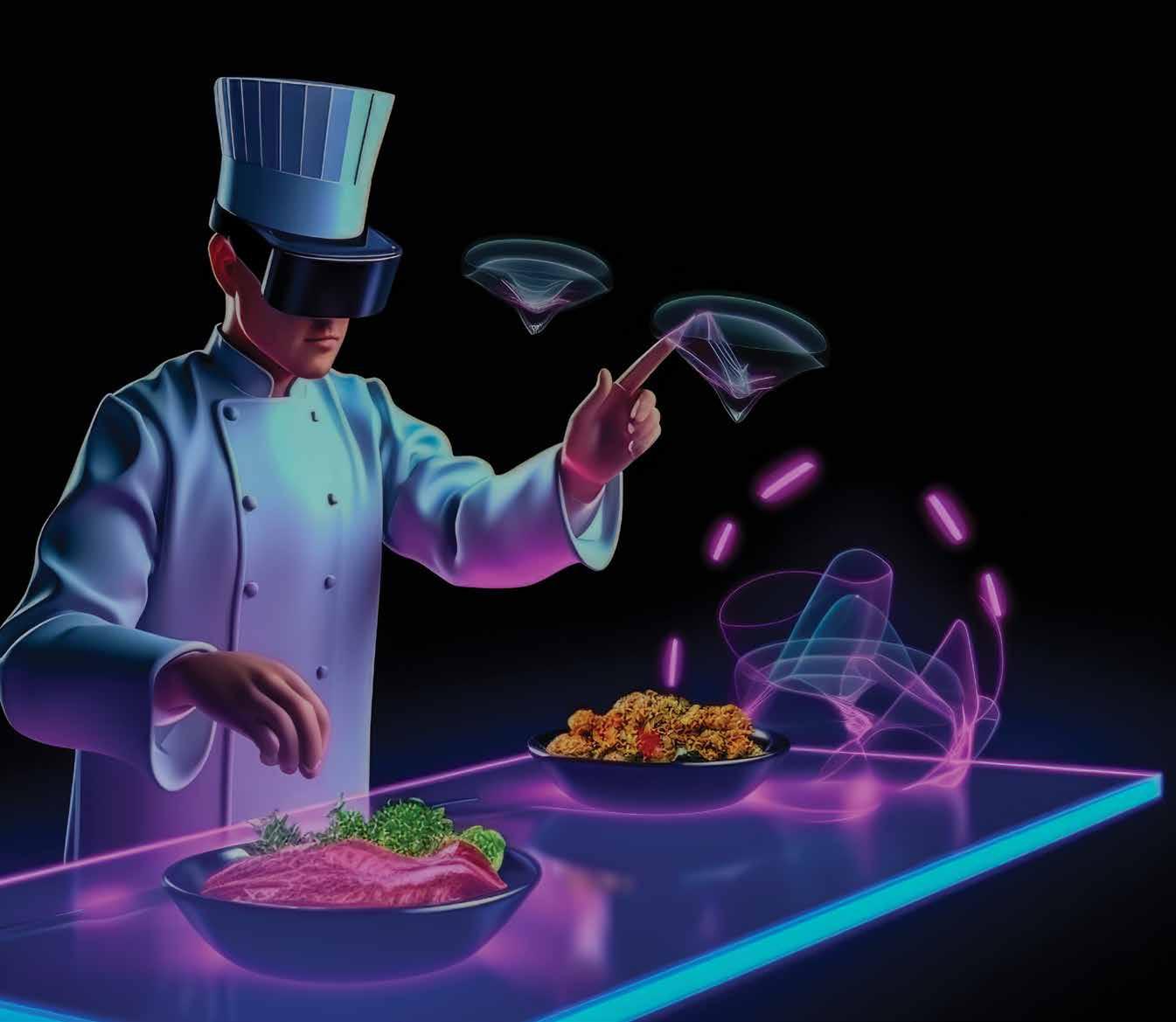
Beep, Boop,
Bon Appétit!
Robots in the kitchen promise a utopia of efficiency and productivity. But with little respite from constant tech, can they really help chefs remain creative and burnout-free, or is guardrail guidance the missing ingredient?
By Shreya Asopa
Almost anyone intrigued by technology and food finds the idea of robotic chefs a telling sign of our era’s uneasy negotiation between efficiency and experience. Even as debates rage on about whether robots will complement or replace human chefs, studies predict
rapid growth in kitchen automation over the next decade.
Originally designed for industrial production lines, robots now handle a dizzying range of culinary tasks from ingredient handling, decoration, serving, packaging, chocolate coatings, to making salads. “The most realistic roles for robots in kitchens over the next five to ten years
are in back-of-house food preparation,” explains Jeffrey Pittman II, Chef and Instructional Assistant Professor at the University of Mississippi.
“Labor-intensive tasks like bulk sauce production, produce cutting, meat fabrication, and dessert decorating require consistency, speed, and precision, but less creativity.” Professor
Pittman, who is researching both the potential benefits and challenges of introducing robots into restaurant kitchens, argues that robot chefs can absorb these repetitive tasks, reduce reliance on entry-level staff, address labor shortages, and free human chefs to focus on creativity and quality. Yet despite this potential, the adoption of robotics in food processing has lagged behind other sectors.
Dr. Wonda Grobbelaar, Assistant Professor at the State University of New York College at Oneonta, knows why robots have not yet become ubiquitous in kitchens. “Food production is complex, and hygiene standards in the industry are unforgiving. Successful integration of robots depends on the relationship between humans and machines, and how well they interact in the kitchen environment,” she explains.
If the potential is clear, the path is not. Dr. Grobbelaar points out that many restaurant owners remain unaware of what modern automation can actually do. “We talk about Industry 4.0, but in many ways, we are already entering Industry 5.0,” she says. “That means focusing on human well-being as much as efficiency. Technology already fine-tunes recipes and flavor profiles, helping chefs detect subtle variations. Robots analyze heat distribution, ingredient density, and timing far more precisely than human senses. But the insights still depend on people to interpret and innovate.”
Customer perception adds another layer. Drawing on Fred Davis’s Technology Acceptance Model, Dr. Grobbelaar explains, “If technology is easy to use, barriers can be conquered. Just as we saw in the case of mobile phones.”
Adoption, however, entails more than ease; it is underpinned by trust. “Consumers need transparency and human oversight to feel confident about food safety in robot-assisted kitchens.”
Professor Pittman offers a complementary perspective. Based

Robots cannot taste or imagine, but they can create the conditions where humans do those things better
on his survey data, he has observed that consumer trust and acceptance of robotic cooking are poised to grow, particularly among Millennials and Gen Z, who are accustomed to technology in daily life. “Many respondents even described robotic cooking as part of the ‘entertainment value’ of dining,” he says. “However, trust hinges on transparency. Open-concept or hybrid kitchens, where customers can see robots and human chefs working together, reinforce that food quality, safety, and creativity remain intact. Over time, this covisibility will likely normalize robots as part of the dining experience.”
Around the world, the early wave of kitchen robots is already clocking in. In the United States, Miso Robotics’ Flippy arm flips burgers and fries food at CaliBurger restaurants (Miso Robotics, 2024). In London, the startup Kaikaku uses its Fusion robotic assembly line to automate repetitive tasks, producing up to 360 salad servings per hour (Fruitnet, 2024).
In Japan, where food robots first gained traction, Suzumo Machinery continues to innovate. Through its United States arm, Suzumo International Corporation, the company is showcasing its latest technology at the NRA Show 2025. The centerpiece is the Super Compact Sushi Machine S-Cube, which can produce up to 1,200 Nigiri sushi portions per hour (Suzumo, 2025).
Automation is creeping into more upscale spaces as well. Sweetgreen’s “Infinite Kitchen” in Naperville, Illinois, uses a proprietary robotic system to build salads behind a glass display. Customers order via tablets, then watch as ingredients flow through transparent tubes, an oddly hypnotic mix of engineering and gastronomy (CNBC, 2023).
The Combination Chef Model Professor Pittman envisions a collaborative future rather than a robotic takeover. “In commercial kitchens, maintaining consistent visual and flavor standards can be challenging, especially with high turnover and varying training levels. Robot chefs can execute precise, repetitive steps, ensuring uniformity in preparation and base execution,” he says. This frees chefs to dedicate more time to creative elements. He termed this approach the Combination Chef model, where humans drive creativity while robots ensure reliable execution.”
Still, ethicists and labor advocates demand transparency and rules. Some have proposed that restaurants explicitly
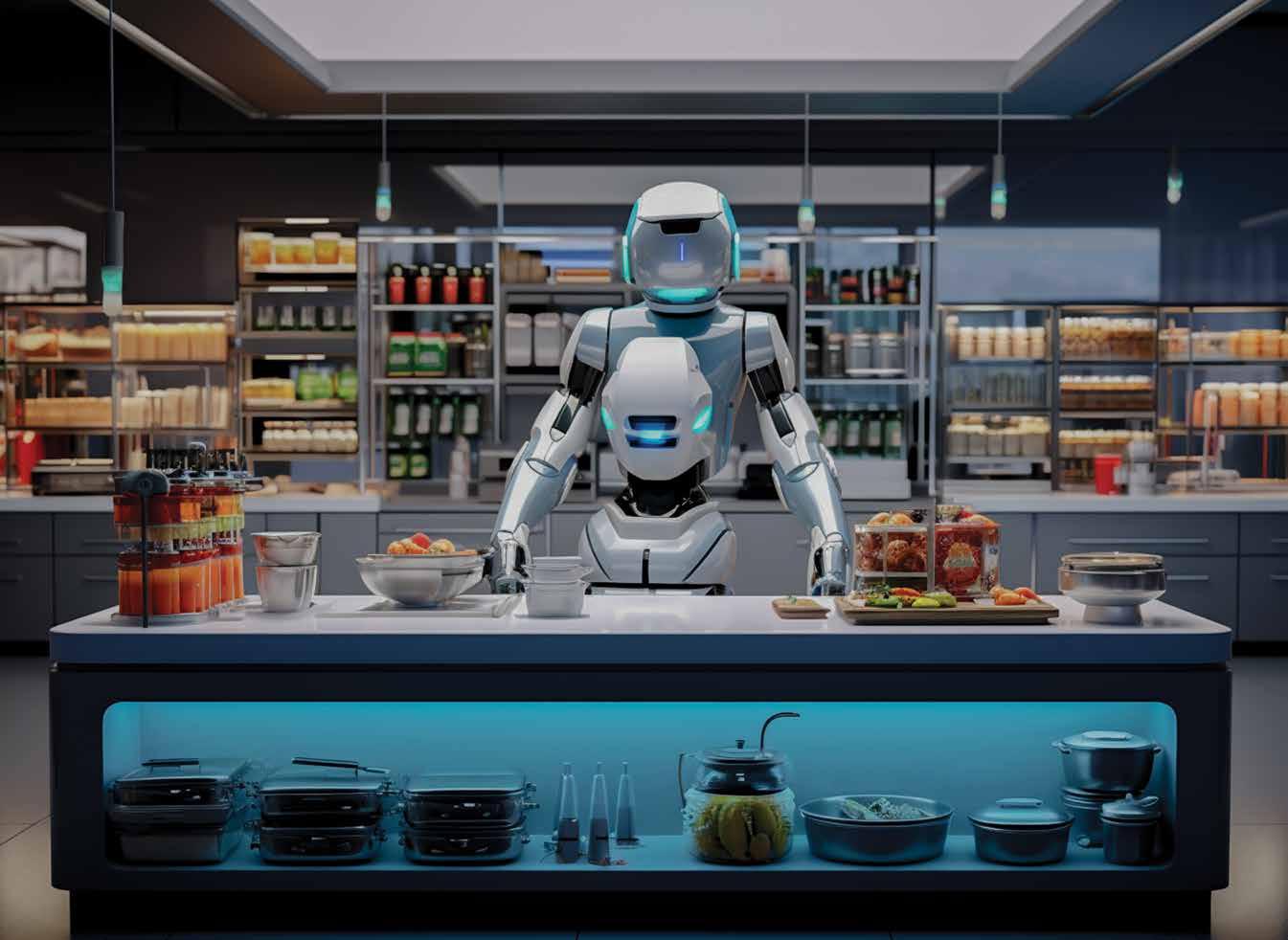
label which dishes are machine-designed and reinvest automation savings into staff (the Las Vegas union’s $2,000 “safety net” is one example) (AP News, 2024). Others call for new oversight, such as algorithmic audits, safety testing, or even AI regulations to preserve trust.
Ethical safeguards are only one side of the equation; sustaining them also depends on whether automation is economically viable. Dr. Grobbelaar observes that the key question is how large an operation must be for the cost–benefit analysis to be practical. “Automation is not one-size-fits-all. A robot that pours coffee is not the same as one that handles delivery or cooking. Investment, infrastructure, and maintenance all depend on the function.”
Professor Pittman offers a similarly pragmatic perspective. “A single robot may cost around $50,000 upfront, or $3,000 per month to lease,” he says, “but in high-volume quick-service or casual restaurants, that investment can replace multiple labor-intensive roles. In multi-unit operations,
The goal is not to remove humans, but to make their work more sustainable, productive, and fulfilling
economies of scale further improve return on investment by standardizing preparation across locations. Conversely, independent restaurants with lower traffic may not benefit, as labor needs are more variable and creative execution is central. In practice, robot chefs make the most sense where volume, standardization, and consistency are critical drivers of profitability.”
Keeping Pace with Cobots
The relationship between chef and cobot (short for “collaborative robot”) is the focus of Dr. Grobbelaar’s current research,
which explores how working alongside robots affects chefs’ stress levels.
Using surveys such as the 10-item Perceived Stress Scale (PSS-10), the Big Five Inventory (BFI-44), structured interviews, and frameworks like the TriTransactional Model of Stress, she found that chefs working with cobots reported higher stress than those without them. While cobots are increasingly used to improve efficiency, chefs still face stress from long hours, staff shortages, and challenging working conditions. The study also examined how sociodemographic and environmental factors, along with individual perceptions, influence stress, incorporating elements from the Transdisciplinary Stress Model and the Work-Related Stress Model (Grobbelaar, 2025).
The findings reveal that age, gender, and personality had little impact on stress; instead, leadership, management practices, and proper training were key. Interviews highlighted that effective integration of cobots depends on preparation and team involvement. “Implementation is everything,” she
says. “Cobots work best in fast-food or chain kitchens, where repeatability matters more than experimentation. They can reduce stress if teams are trained and involved, but if not, they create tension and confusion.”
Older chefs, in particular, are vulnerable to stress when cobots are poorly implemented, as they may question their own skills or feel undermined.
“Some lose confidence, thinking, ‘Maybe I am not as good as I thought.’ That is a human reaction, but it can be mitigated through communication, education, and confidence building.” Stress reduction, she emphasizes, does not come from technology itself; it comes from leadership. “Automation can reduce stress in high-pressure kitchens, but only when humans are supported and informed throughout the process. If chefs understand the system, they will feel empowered, not replaced. Robots can even help people with physical limitations stay in the workforce.”
This idea comes to life in Tokyo, where robotics enables people with disabilities to participate in daily interactions through remote avatars. A café there employs OriHime-D robots, 1.2-meter-tall avatars controlled remotely by staff with severe physical disabilities, including ALS. Using smartphones or tablets, operators transmit video and audio to take orders and interact with customers. The project provides meaningful work, combats social isolation, and allows participants to engage with society in ways that would otherwise be impossible.
Robots that restore independence for some also give overworked chefs more
Robot chefs can execute precise, repetitive steps — freeing chefs to dedicate more time to creativity
time and energy. Burnout remains one of hospitality’s most persistent problems. “When people say, ‘The robot will take someone’s job,’ I say, maybe. But what if it gives someone their life back?” asks Dr. Grobbelaar. “Cooking is physically demanding; you are standing all day, lifting, moving, and sweating. But if robots take on the repetitive, taxing work, experienced chefs can step into mentor roles. More time to think and create.”
But the picture is not entirely smooth, she observes. As part of her research, Dr. Grobbelaar spoke to a chef about using robots on a production line, who noticed his team stepping back and doing less. “They would say, ‘Oh, the robot will do it.’ A tool meant to boost efficiency was creating inertia. It led to downtime and low initiative. Morale and engagement drop,” she explains. “This is not about technology alone. It is about training and mindset. People need to see the robot as a tool, not a replacement.”
The Human Ingredient Skepticism and misconceptions about robot chefs are unlikely to abate soon.
According to Professor Pittman, two misconceptions dominate: that robots will eliminate restaurant jobs and that robot-cooked food lacks authenticity. “My findings suggest the opposite,” he states. “ Robot chefs tend to assume undesirable or chronically unfilled roles such as bulk prep, mass plating, or dish assembly. This alleviates pressure on staff, allowing human chefs to maintain creative control and elevate presentation. When integrated into hybrid “Combination Chef” models, robot chefs ensure consistency while human chefs deliver artistry. Much like factory robotics, the goal is not to remove humans but to make their work more sustainable, productive, and fulfilling.”
The endgame is not technological perfection; it is equilibrium. Automation should make kitchens more humane, not less. As Professor Pittman puts it, “Technology should make work more meaningful. Robots cannot taste or imagine, but they can create the conditions where humans do those things better.”
With the dawn of robot-assisted kitchens, the twenty-first century shifts from valuing speed and scale to intelligent automation that personalizes every dish. Robots erase the need for repetitive tasks, instantly execute centuries of culinary knowledge, and help reach a placid perfection. But the heart of the kitchen remains undeniably human.
Dr. Grobbelaar summarizes it best. “At the end of the day,” she says, “it is not about the robots. It is about us, how we adapt, how we collaborate, and how we keep the human spirit at the center of it all.” ■
SOURCES:
> Miso Robotics (2024). Flippy the world’s first autonomous robotic kitchen assistant now cooks burgers at CaliBurger in Pasadena, California. https://misorobotics.com/ newsroom/flippy-the-worlds-first-autonomous-robotic-kitchen-assistant-now-cooks-burgers-at-caliburger-in-pasadena-california/
> Fruitnet (2024). London restaurant features robot-powered salad bar. https://www.fruitnet.com/fresh-produce-journal/london-restaurant-features-robot-powered-saladbar/269182.article
> Suzumo (2025). Super Compact Sushi Machine S-Cube. https://www.suzumokikou.com/news/20250508
> CNBC (2023). Inside Sweetgreen’s first automated location. https://www.cnbc.com/2023/06/24/inside-sweetgreens-first-automated-location-plans-to-take-tech-nationwide. html
> AP News. (2024). Las Vegas union safety net proposal. https://apnews.com/article/ces-2024-robots-vegas-strip-casino-jobs-8bd3fd4f404a0cda90e69e539a19fb01
> Telegraph (2024) Kaikaku restaurant in London https://www.telegraph.co.uk/business/2024/08/25/would-you-eat-meal-cooked-robot-meet-machines-taking-over/
> Grobbelaar, W. (2025). Creating a lean culture by integrating robotics in back-of-house operations: effectual trio or an immense disaster. Anglia Ruskin Research Online (ARRO). https://doi.org/10.25411/aru.29598905.v1
Time for Change
Chef Helen Morris on rethinking hospitality work culture to secure future talent
By now, many of you know my passion for food, talking about it, teaching it, and endlessly seeking my next great culinary discovery. Yet, this month I want to step away from my usual musings about flavours, plating, and ingredients, and focus on something equally close to my heart, the people behind hospitality.
In recent months, I have had countless conversations with students, employees, and managers about one pressing topic: how we, as an industry, are treating our workforce. From working hours and staff investment to talent retention, these discussions have left me reflecting deeply.
This is not a criticism of those who are doing things right. Many hotels and restaurants genuinely look after their people, pay fairly for extra hours, and prioritize wellbeing. To those leaders, I say keep leading, keep inspiring, and keep pushing the agenda forward.
But across the industry, we must collectively recognise that the future of hospitality- its sustainability, creativity, and excellence- depends on how we nurture and retain our talent today. There is no denying it, we are facing a global skills shortage in hospitality. From front-of-house to culinary operations, from sales to HR, every conversation I have had with industry partners circles back to one urgent truth - we need more skilled people.
This is not just a local issue. By 2032, it is projected that 126 million new hospitality jobs will be created worldwide. That is an enormous opportunity and a monumental challenge. Yet despite the numbers, people continue to leave the industry. Why? Because the balance between personal fulfillment and professional expectations remains misaligned.
Passion should enhance life — not consume it
The shortage is not about passion. It is about preparation and investment. Somewhere along the way, our focus on short-term operational demands has diluted the depth of training that was once fundamental to ‘old-school’ hospitality, characterized by practicality, comprehensiveness, and a sense of pride in craftsmanship. We now need to reimagine that same approach through a modern lens and one that aligns with generational expectations.
Almost weekly, universities like ours receive requests from hospitality organisations eager to ‘collaborate’, to bring in interns, trainees, or new graduates. And collaboration, in principle, is great. It connects education with industry, theory with practice, and aspiration with opportunity.
But here is where the conversation often falters from my current location. When I ask:
'What department will the student be in? What is the training plan? What will they earn?' Too often, the response is: It is an unpaid internship, we do not have the budget right now, but it will be a good experience in operational roles as we are busy.
Seriously! Good experience should not mean free labour. It sends the wrong message to young professionals who are already questioning the value of entering
this field. If we genuinely value talent, then we must show it with proper training, mentorship, and yes, fair compensation.
Paid internships, structured learning plans, and clear progression pathways are not luxuries. They are investments in the sustainability of our workforce. After all, probationary periods exist for a reason: to evaluate performance, fit, and growth potential. Why wait until graduation to offer a job when we could nurture that commitment much earlier?
Let us talk about the next generation, Gen Z. They are often misunderstood, yet they might be the most promising group of professionals we have ever seen. They are ambitious, digitally savvy, and unafraid to voice their expectations. They want to be included in decisions, to have clarity in their roles, and to work for organisations that are transparent and ethical. In short, they want meaning in their work and a life outside of it.
I have had the privilege of working with some truly inspiring Gen Z professionals. One in particular stands out, a young female I have worked with for two years, who played a key role in supporting student internships and industry relations. She was energetic, driven, and deeply passionate about hospitality. Then one day, she told me she was leaving. Not for another hotel, but for a role outside the industry altogether. Her words struck hard, "Why would they let me go? I am passionate, I love what I do, but they have done nothing to keep me." It was a sobering moment. Here was someone with genuine potential, precisely the kind of person our industry needs to keep, and yet she felt unseen. She will thrive wherever she goes, but I cannot help wishing she had been given more reason to stay. The lesson? Gen Z is not the problem; our systems are. If we do not
adapt, we risk losing a generation that could redefine hospitality for the better.
During a recent staycation, I was sitting in a hotel lobby, enjoying a coffee (and, naturally, observing service), when I overheard a conversation between a young employee and her manager. She looked exhausted, pale, drained, emotionally spent, and even I was worried for her. As she quietly explained that she had not taken lunch in days and could not keep up with her workload, the manager listened attentively. The outcome, I do not know, after all, I was eavesdropping. But I could not help thinking, listening is only the first step. Without systemic support, more staff, better scheduling, and realistic workloads, empathy risks being just a temporary comfort. I left wondering how long she would last in that role. And if she leaves, will her final impression of hospitality be one of care, or of exhaustion? For all our talk about being 'people-centered', we must remember that this extends beyond the guest and includes our employees as well. Work-life balance is not a buzzword; it is a business obligation.
Not long ago, I was reminiscing with a general manager about our early careers. We spoke fondly of the long hours, the adrenaline of service, the pride in pulling off impossible events. But we also laughed (and slightly winced) at how unsustainable it all was. Working 10-12-hour days, it may have built resilience, but at what cost? Many of us accepted it as the way things are because we loved the industry. Passion was our currency. But looking back, we were, quite frankly, giving away free labour.
Today's young professionals have the courage to question that. They value rest, health, and family time. That does not make them lazy; it makes them wise. They have recognised what many of us realised too late: that passion should enhance life, not consume it. After all, we have been having this same conversation for over two decades about pay, hours, and work-life balance, and yet the issues persist. It is time we stopped
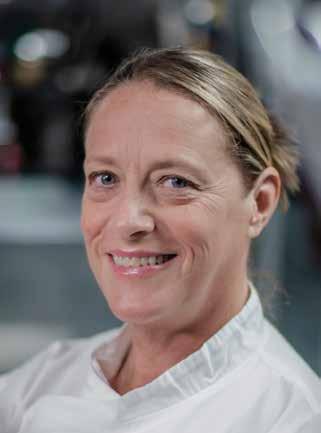
Let’s stop talking about change — and start being the change
talking and really started acting.
Friends in retail, banking, and manufacturing tell me similar stories of excessive workloads, long unpaid hours, and a growing exodus of talent seeking fulfillment elsewhere because senior managers think you get paid well, so you owe us mentality. The phrase people over profits is easy to say but difficult to live by. Yet the companies that truly embrace it and treat employees as their greatest asset are the ones thriving in recruitment, reputation, and results.
Hospitality can and should lead by example. We are an industry built on care. Creating a culture that supports wellbeing, growth, and purpose doesn't just benefit employees; it benefits the business. A happy, motivated team delivers better service, inspires loyalty, and enhances brand reputation.
We must ensure our values are lived every day. That means giving department heads real tools to manage workloads, champion wellness, and re-evaluate structures that normalise burnout.
Ask the tough questions: Are our training programs equipping employees for advancement, or are they merely filling shifts? Are we recognising contributions fairly, not just financially but emotionally? Are our leaders modelling balance, or glorifying
exhaustion? The answers to these questions will determine if hospitality remains an inspiring industry or becomes one of disillusionment.
One of the most potent solutions lies in collaboration between education and industry. Universities, colleges, and training providers are producing talented, motivated graduates eager to make their mark. But they need meaningful placements that offer mentorship and growth opportunities. Imagine if every hotel and restaurant committed to mentoring just one student a year, not as extra labour, but as a genuine apprentice. The return on that investment, in loyalty and innovation, would be immense. When education collaborates with industry, we connect academic learning to practical expertise. We create not just employees, but ambassadors for the profession.
For me, hospitality has always been more than a job; it is a way of life. It is about creating joy, crafting experiences, and connecting people across cultures. Let us ensure that the next generation experiences those same rewards without the same sacrifices. We have an extraordinary opportunity to redefine what it means to work in hospitality to make it a career of pride, purpose, and possibility.
So, let us stop just talking about change. Let us be the change. After all, the most memorable experiences in hospitality have never been about the grandeur of a place but about the people who make it special. Let us invest in them. They are, and always will be, the true heart of our industry.
Yes, I somehow stumbled into education, a happy accident that gifted me the elusive work/life balance (and the freedom to pursue my second great passion - travelling). But let us be honest, hand me a set of chef whites, a busy dining room, and that glorious chaos with work/life balance… I would be back in hospitality faster than you can say "table for two, please." ■
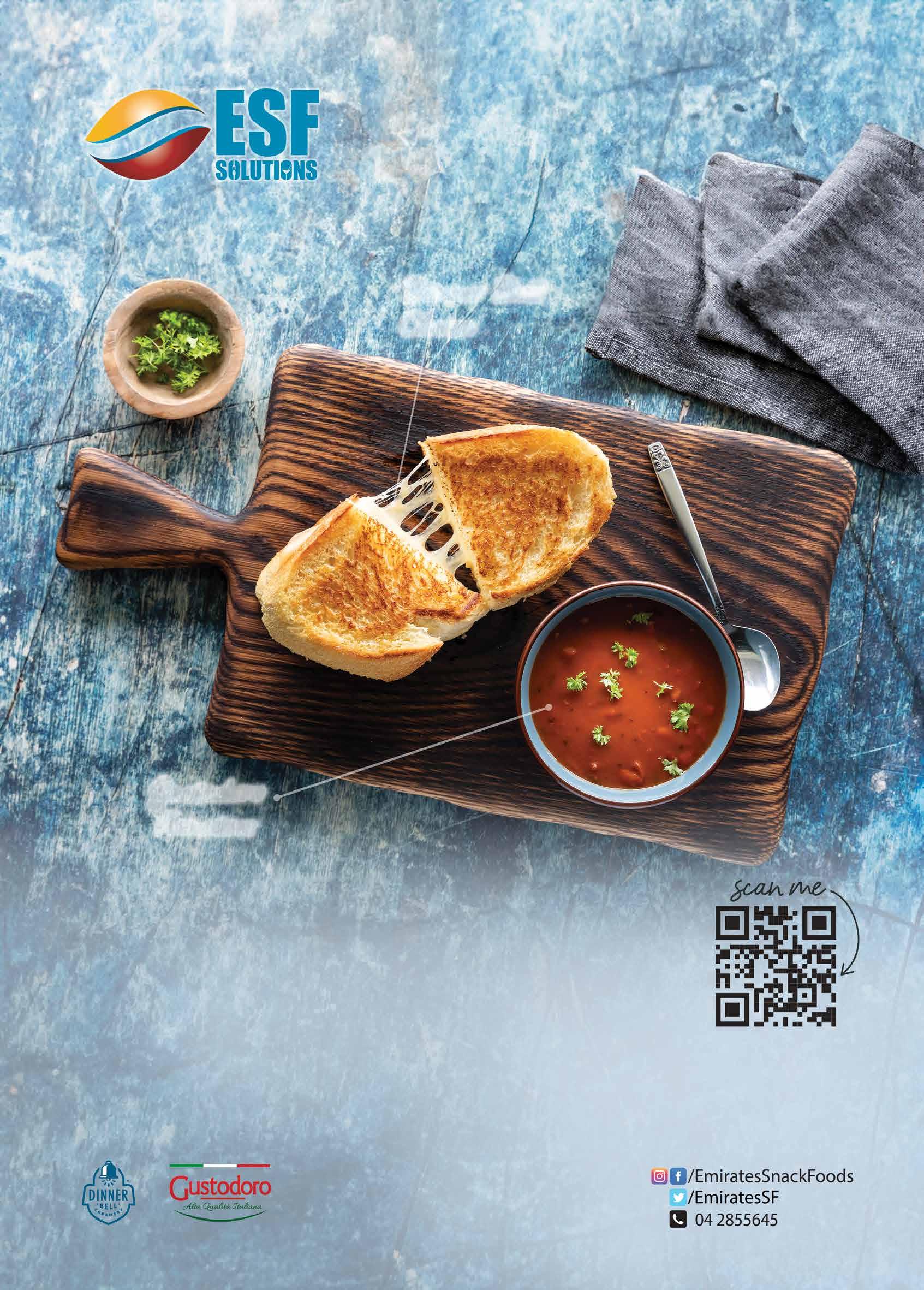

Oops! The Entrepreneurial Don'ts (Part II)
Chef Vivek Huria serves up his next batch of entrepreneurial don’ts. From invisible growth to keeping things simple so they actually work, he shows how smart strategies make all the difference.
It is easy to take a ‘no’ lightly until it is said to you. Somehow, that word stays with you longer than a compliment ever will. But in business, as in the kitchen, learning to accept ‘no’ is one of the greatest skills you can develop.
“No, the steak is not cooked right. No, it is not medium-well.” I still remember these words from a guest during my time at Le Royal Méridien. It is a story I have also shared in my book Jalfrezi: From the Vantage of the Culinary World. One of my young chefs had cooked the steak just a shade under, and though the guest was courteous, his ‘no’ said everything. I could not argue, after all, he was a well-traveled European guest.
That simple exchange taught me something lasting. The trellis of growth in this industry is built on how you handle rejection. Every ‘no’ is a cue to refine your craft.
So, continuing from Part I, here is another serving of entrepreneurial don’ts, lessons from the kitchen on turning every no into a chance to learn.
Don’t break the consistency: If there is one thing scarier than an undercooked steak, it is inconsistency. You cannot serve magic on Monday and mediocrity on Friday. Customers remember both. Consistency must run through every aspect of your restaurant. Be it in your food, the quality of service, the ambience, or the entire hospitality experience.
Don’t despair when growth feels invisible: Any restaurant is only as good as the team behind the line. Your staff is your most indispensable resource. As
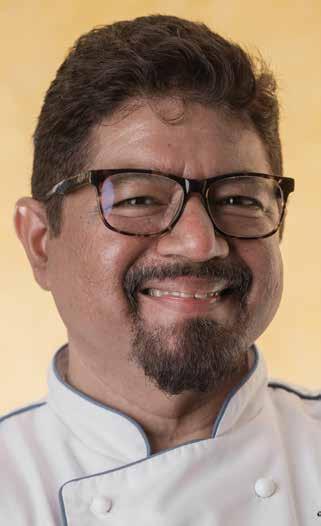
Every ‘no’ is a cue to refine your craft
a leader, your job is to show them that learning today is seasoning for their own future. Whenever I sit with my team, I tell them that whether they practice these lessons here or elsewhere, they will benefit. In today’s age of instant gratification, invisible growth may feel like failure. It is not. You plant seeds, and the sprouts take their time. Don’t dig them up to check. What you put in today will show results tomorrow. Patience and faith in the process are essential.
Don’t complicate the menu: A menu with too many choices overwhelms guests and slows down service. I have seen guests read a few lines, panic, and ask, “What do you recommend?”
Keep it simple. Offer your best dishes. By simplifying the menu, you make it easier for guests to decide, faster for your staff to serve, and more enjoyable for everyone. In other words, simplify to multiply. A simple, well-curated menu multiplies customer satisfaction, repeat visits, and even operational efficiency.
Trends like adding photos to menus do not always help anymore. With mobile distractions, guests often barely look at the lengthy texts or pictures. They are checking social media while scanning. Today, clarity wins. Don’t confuse your guests with a hundred options. Simplicity leads to better choices and happier diners.
Don’t Let Burnout Hinder Creativity: Reinvent without burnout. There is a thin line between innovation and exhaustion. When something is not working, change the approach. Reinvention is about using your existing ingredients and resources differently. Sometimes it means offering breakfast deals, sometimes adjusting how you present your story. For example, I considered introducing a breakfast menu priced at 10 dirhams or less to attract more customers, while using the same staff and resources I already had. Small strategic shifts like these can bring in extra business without overburdening your team. Burnout happens when you fixate on failure rather than think creatively. Step back, get inspired, and approach the problem with renewed energy. ■
Stay tuned for Part III, where more entrepreneurial don’ts will be revealed to help you sharpen your business instincts.
> Reference: (https://www.amazon.ae/s?k=Jalfrezi +from+the+vantage+of+the+culinary+world&crid =3VK4SFOMH5BLS&sprefix=jalfrezi+from+the+v antage+of+the+culinary+world%2Caps%2C338&r ef=nb_sb_noss)
The Butterfly Effect
Chef Tarek Mouriess on dismantling run-of-the-mill CVs and why your actions today echo far beyond the kitchen
Continuing from where we left off on giving hope to young talents hustling in the kitchen, it is time to move beyond the cookie-cutter approach in landing a job and focus on what truly supports your journey...which is not social media clout but you …resume.
The other day, I walked into a regular work session with my culinary internship students. The session that day was on building resumes. To me, a CV/resume is not just a list of experiences, it is a chance to say 'Hello' before you ever meet someone. Your CV is an extension of your personality; it should speak to who you are, because a busy chef scanning dozens of resumes should be able to sense your energy, your dedication, and your creativity in every line.
Here are some practical tips to make your CV stand out: Hobbies: The Secret Sauce
Boring hobbies are a CV killer. “I like reading, music, and traveling” tells nothing about who you are or why you belong in a kitchen. Instead, connect your life to your culinary passion. For instance:
Weak: “I love to read.”
Chef-Level: “Interested in food science and history, currently reading Salt, Fat, Acid, Heat to understand cooking fundamentals.”
Weak: “Listening to music.”
Chef-Level: “Play drums in a band, which developed a strong sense of timing and rhythm essential for coordinating in a busy kitchen.” Your hobbies should show your personality, creativity, related to the culinary world.
Experience: Show Me What You Did Just naming your job won’t impress anyone. Describe what you did and what you learned:
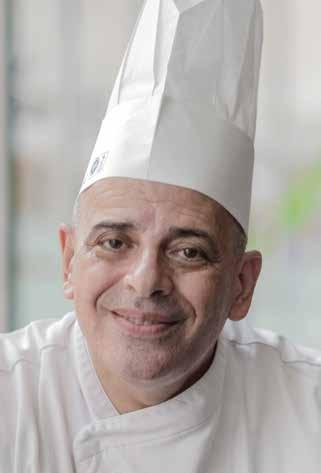
A CV is not a list of experiences — it’s your first ‘Hello’ before you ever meet someone
Role: Commis Chef, Pastry Section –The Grand Hotel (5-star resort)
Tasks: Prepared daily mise en place for desserts, managed the deck oven during service, and collaborated with the larder section on plating for 200+ covers.
Skills Learned: Precision in baking, time management, and essential kitchen communication.
Your CV should show your growth.
Skills: Stop Using Fillers
Saying "I am hardworking" or "a team player" doesn't prove anything.
Show it with examples:
Leadership: Trained two new interns on the meat slicer, reducing their training time by half.
Problem-Solving: Created a buttermilk substitute for missing crème fraîche, ensuring the dish went to service without delay.
Teamwork: Assisted the fallingbehind grill station during a peak rush, keeping the entire kitchen on schedule.
This specificity makes your CV stand out and show what you're capable of. Remember, in the kitchen, how you perform matters immediately. Every action, every choice, carries weight.
As mentors, even our encouragement, our actions, all of them ripple outward. Sometimes, it is the words we speak aloud. And sometimes, it is the unspoken decisions and choices we make. They speak too and carry consequences in ways we may never fully see.
Take, for instance, a young chef rolling pasta dough. A simple comment, recognition of their passion, can ignite a chain reaction. That chef might start reading specialized cookbooks, experimenting at home, and eventually excel in a field. I recall a young Moroccan intern, determination shining in her eyes. She had set her heart on pastry, but I encouraged her to train in the bakery section, working with bread. At first, she hesitated, yet she placed her trust in the mentorship. Over time, her skills grew steadily, and recently, at the Salon du Chocolat competition, her expertise in bread making earned her recognition.
Ripples like these touch lives, shape careers, and influence communities we may never meet. This butterfly effect is only the beginning. How these butterfly flaps guide growth, open opportunities, and develop your career- that perhaps is a story for another page. ■
A Smarter Way to Cater
How Progressive Web Apps Are Transforming Catering Operations, explains
Catering today is about much more than preparing good food. Companies are under pressure to deliver flawless events while dealing with rising customer expectations, tighter budgets, labour shortages and last-minute client demands. Whether it is a corporate luncheon for 50 or a gala dinner for 1,000, behind-the-scenes logistics can quickly spiral out of control if not managed effectively.
Now the pressure is even greater. The global business events industry is a $1.6 trillion contributor to GDP, employing more than 27 million people and generating an estimated $2.8 trillion in business sales, making it comparable to the thirteenth largest economy in the world. This is not a side industry — it is a global economic engine. The Events Industry Council’s latest Global Events Barometer reinforces the scale of opportunity, showing hotel group room-night bookings at 106 per cent of 2019 levels in Q2 2024 and RFP activity reaching 99 per cent, with some of the strongest gains recorded in the Middle East. By early 2025, room-rate responses were already 129 per cent of 2019 levels, underlining the speed at which demand has returned. For catering businesses, this growth brings opportunity, but also heightened expectations.
Traditionally, even minor adjustments — an unplanned dietary request, a forgotten set of tables or a last-minute seating change — meant frantic phone calls, hurried calculations and a heightened risk of mistakes. In an industry where reputation depends on precision and reliability, such slip-ups cost both money and trust. This is where digital solutions, particularly Progressive Web Apps (PWAs), can transform catering operations.
Unlike traditional mobile apps, PWAs work instantly across all devices without the need for downloads or constant updates. They provide an app-like experience with offline capability and real-time synchronisation, making them ideal for catering teams that need seamless coordination between sales, operations, suppliers and clients. For businesses, this means less time
Shishir Surendran
lost to administrative back-and-forth and more focus on service delivery. For clients, it creates greater transparency, faster communication and the ability to customise their event with confidence.
The real impact of a PWA comes when you look at how it changes everyday operations. Menu updates and seating adjustments can be made in real time, so if a client suddenly adds ten vegetarian meals, the system captures the change immediately and flags the operational requirements. Food stations can be showcased interactively, turning them into upselling opportunities while also ensuring the necessary logistics are covered. Booking and payment processes are streamlined, eliminating paperwork and speeding up confirmations. Realtime availability checks help teams avoid double-bookings or missed rentals, and integrated inventory visibility prevents the embarrassment of running out of supplies mid-service.
The commercial potential of PWAs has already been proven in other sectors. When Pinterest rebuilt its mobile web experience as a PWA, it saw a 60 per cent increase in core engagements, users spending 40 per cent more time on the site and ad-related revenue climbing by 44 per cent. Starbucks has also used a PWA for mobile ordering, building an app that is almost 100 times smaller than its iOS version and designed to function even in areas with weak connectivity. For catering companies, the parallels are clear: if digital tools can drive efficiency, engagement and revenue at scale elsewhere, they can do the same in this industry.
Catering is one of the most competitive segments of hospitality. Margins are often tight, yet clients expect flexibility, personalisation and professionalism as standard. Without digital tools, these expectations can quickly overwhelm a team. Imagine a client doubling their guest count two days before the event. With a PWA, the update is logged instantly, adjustments are calculated automatically and the operations team receives alerts to reallocate resources. What would previously have been a
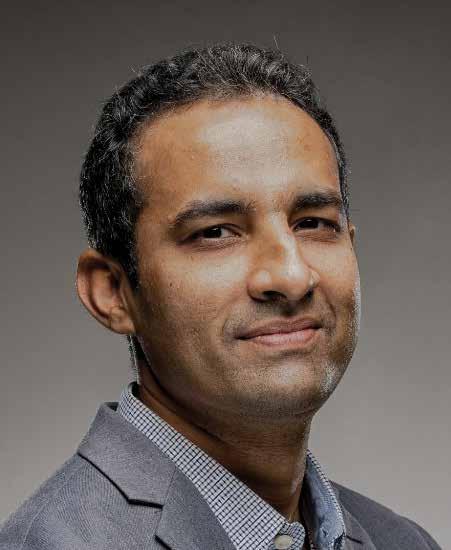
stressful and risky scenario becomes a manageable workflow.
Across the wider hospitality sector, digital transformation is already changing how businesses operate. Hotels and restaurants have embraced apps and cloud platforms to improve guest engagement and streamline operations. In the GCC especially, events are global showcase moments. Delivering reliably and innovatively is not optional — it is what separates winners from the rest.
The timing is critical. EIC research also notes that two-thirds of global business event spending was lost during the pandemic, totalling around $1.9 trillion, yet the recovery is rapid. Adjusted for inflation, spending is expected to return to 2019 levels by 2025. Companies that invest in digital solutions now are not simply catching up, they are positioning themselves to thrive in the next phase of growth.
By adopting Progressive Web Apps, catering businesses can shift from reactive firefighting to proactive clarity. Endless calls, scribbled notes and last-minute chaos are replaced with streamlined systems that deliver efficiency and client satisfaction in equal measure. This is more than a software upgrade; it is a reimagining of how events are planned and delivered in a digital age. For catering professionals, the opportunity is clear: those who act now will not just survive in a challenging market — they will lead it.
About the Author: Shishir Surendran, Founder and Director of Decimal Technologies, is a distinguished executive with extensive experience in digital product development and helping companies leverage cutting-edge technologies to achieve their business goals.
Bin to Brilliance
Chef Carl Shi on rethinking food waste in professional kitchens (part 1)
In the ever-evolving landscape of professional kitchens, excellence has traditionally been defined by creativity, precision, and consistency. But today, a new marker of culinary brilliance is rising to the surface: sustainability. Food waste, once considered an unavoidable by-product of kitchen operations, is now under intense scrutiny by chefs, educators, and researchers worldwide. In this two-part series, we will explore the practical roots and cultural mindset shifts needed to transform our kitchens from waste generators into waste innovators.
Food waste is one of the hospitality industry's most persistent and underestimated challenges. According to the United Nations Environment Programme (2021), approximately one-third of all food produced globally is wasted. In professional kitchens,

trimming during prep, overproduction on the line, and untouched portions sent back by guests.
Unlike visible challenges like staffing shortages or rising ingredient costs,
in the prep bin, in fridges that are not audited, or at buffet tables after the crowd disperses. The financial, environmental, and ethical costs of this waste are significant. Wasted food means wasted money, energy, water, and labour. And when food ends up in a landfill, it contributes to greenhouse gas emissions, particularly methane.
Rethinking the Meaning of Waste
To tackle the problem, we must first redefine what we consider ‘waste’. In many kitchens, usable food is discarded because of cosmetic imperfections, overpreparation, or rigid service standards. That herb stem, over-trimmed fillet, or misshapen carrot is often viewed as scrap, even though it holds culinary potential. This mindset has been reinforced by traditional kitchen hierarchies and operational pressures: speed over scrutiny, consistency over

1 2 3 4








The Business Impact of Food Waste






Spoilage











Plate Waste




Oversized meals




Unpopular dishes
Al l-you-can-eat lef tovers


Fridge “forgotten” items

Overordered perishables

Lack of FIFO system
and environmental pressures mounting, these norms must be reconsidered. The new gold standard for chefs is not just how beautifully they plate a dish, but how little they waste in the process.
The Food Waste Hierarchy (Source: EPA-USA, 2025)
One of the most useful frameworks to guide kitchen decision-making is the Food Waste Hierarchy, adopted by sustainability organisations and environmental agencies. This model ranks food waste management practices from most to least preferred:
Avoid and Reduce – Prevent waste before it begins through smarter procurement, inventory control, and menu design.
Reuse and Repurpose – Give surplus food a second life through preservation, reinvention, or redirection.
Recover – Use food scraps for animal feed or convert them to energy via biodigestion.
Compost – Turn organic waste into nutrient-rich soil.



Trim Waste








Uneven vegetable cuts
Over-trimming proteins


No scrap repurposing (e.g., stocks)

Bulk-cooking for "just in case"
Unadjusted buf fet por tions


Misjudged event RSVPs
> Reference: FAO 2011; WRAP 2018; Arcibar-Orozco et al. 2019; UNEP 2021
Food waste doesn’t shout — it accumulates silently in bins, fridges, and buffets, costing us more than we see
Dispose – Send to landfill or incineration only as a last resort.
For chefs, this hierarchy offers more than a sustainability checklist. It becomes a creative prompt: How can we elevate our practice by applying these principles in real-time service?
Smart Procurement - Buying with Intention
Many kitchen waste issues begin at the point of purchase. Overordering perishables, chasing supplier minimums,
or failing to check existing stock can all lead to spoilage. Instead, kitchens can adopt a more agile procurement strategy: order less in volume but more frequently, build flexible supplier relationships, and involve the entire kitchen team in forecasting. Using digital inventory tools, kitchen management software, or even simple spreadsheet trackers can make a significant difference. Beyond quantity, quality also matters. Choosing imperfect produce (sometimes called ugly food) at a discount not only diverts potential waste but often supports smaller, local suppliers who may not meet strict supermarket standards.
Storage and Inventory - Systems Over Guesswork
Poor storage practices are a silent contributor to food spoilage. Adopting a structured FIFO (First In, First Out) system is essential, but it must be paired with regular audits, staff training, and visual cues like colour-coded tags or transparent bins. Temperature control in fridges, clean seals on cool rooms, and consistent
labelling are maintenance practices that prevent loss before prep even begins.
Kitchens that prioritise daily or weekly inventory checks see measurable reductions in spoilage. These practices also create opportunities to rotate ageing stock into specials or shift menus toward available ingredients.
Prep and Portioning - Craft Meets Efficiency
Trimming, cutting, and portioning are areas where culinary technique and waste prevention intersect. Poor knife skills can turn a whole carrot into half a yield. Overtrimming proteins, misjudging yields, or discarding stems and peels without thought compound waste.
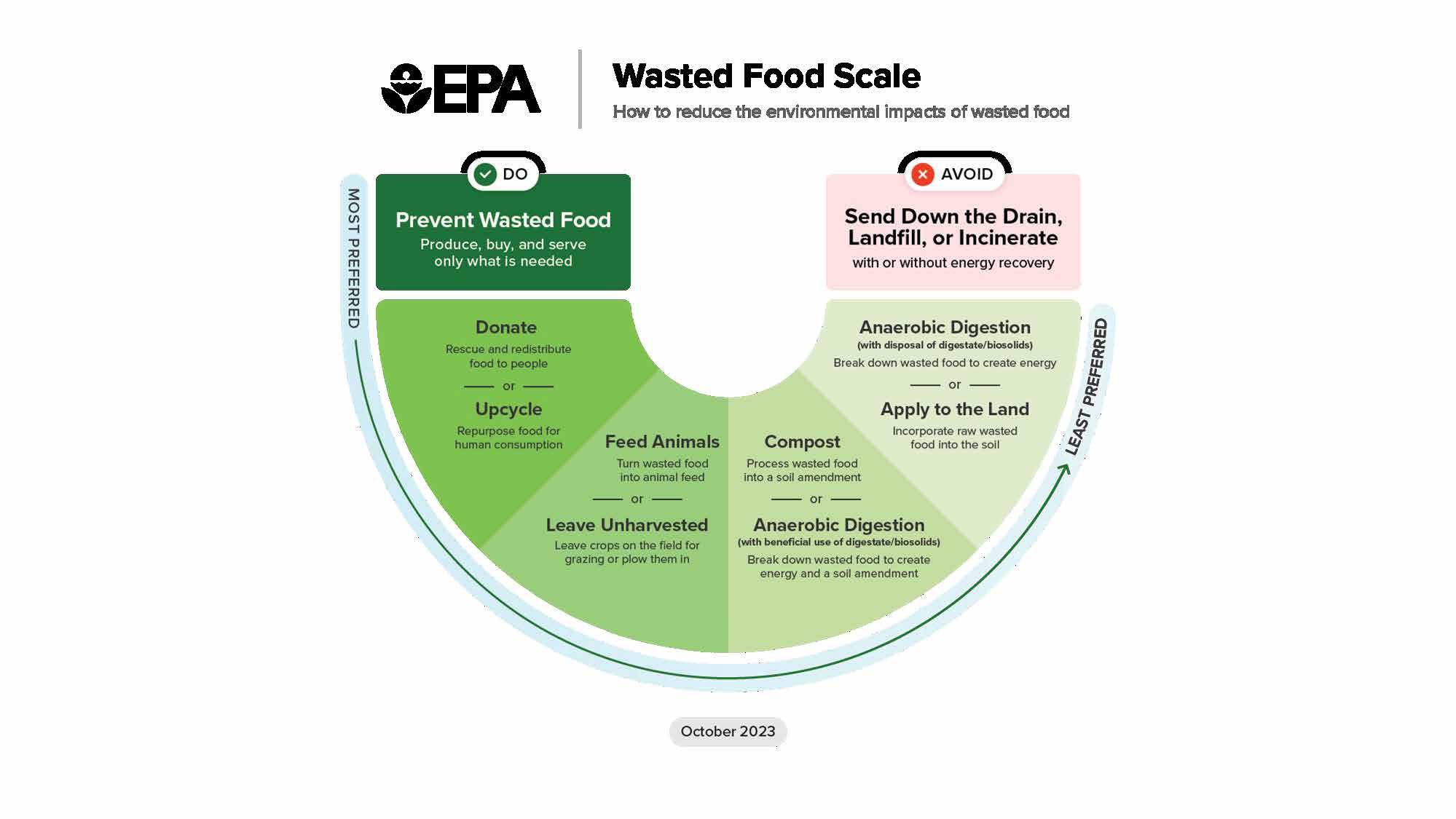
Standardising prep techniques through training, yield tracking, and visual aids can help chefs recognise just how much usable food goes unnoticed. On the service side, reconsidering portion sizes and offering flexibility can drastically reduce plate waste. Giving diners the option to choose smaller sizes or to skip side dishes they would not eat helps avoid unnecessary production.
Menu design can also support this, with interchangeable sides, daily specials based on surplus, and data-informed updates that phase out unpopular items.
Ending the Shift with Less in the Bin
At the end of a busy shift, many chefs do not stop to reflect on what is in the bin. But regular waste audits, even informal ones, can reveal recurring issues. Are the same vegetables always over-prepped? Are there trays of proteins thawed and unused? Is the garnish station
Avoid
Procurement Management
Avoid over-ordering
Avoid poor supplier
Avoid below-
standard ingredients
overstocked? These questions do not just highlight inefficiencies; they spark conversations. Teams that build time into the week for reflection, briefings, and adjustments are more likely to reduce waste organically.
In part two of this series, we will explore how chefs can move from awareness to innovation through creative repurposing, staff engagement, and customer communication. The goal is not just to waste less, but to inspire more. ■
& Reduce- The Chef’s Role
Inventory Management
Applying FIFO practice
Ordering less in (Quantity)
Ordering more in(Frequency)
Menu Planning & Design
Seasonal ingredient rotation Portion-Size
EngineeringFlexible 'Chef’s Special' Section Local and Perishable Ingredients
Prep & Service Measuring and Standardizing Adjusting Portions, Customization and PreOrdering
The Right Way To Store Boxed Beef & Lamb
Sulemana A. Sadik on why temperature and time matter for the quality and yield of chilled and frozen meat
In the world of meat handling, few things are as fundamental and often overlooked as proper temperature control. Whether you are dealing with chilled or frozen boxed beef and lamb, storage conditions directly affect not only shelf life but also eating quality, food safety, and customer satisfaction.
Let us begin with the basics. Chilled boxed beef and lamb should be stored consistently between 0°C and 1°C (32°F to 34°F). Going above 1°C, even slightly, begins to create conditions conducive to microbial growth. On the other hand, frozen boxed meats must be maintained at -18°C or lower (0°F), as this effectively halts enzymatic and bacterial activity.
It is not just about plugging in a chiller or freezer and assuming the job is done. The temperature must be monitored regularly with calibrated thermometers or digital tracking systems. Daily logs are not bureaucracy; they are essential for transparency, traceability, and accountability in any HACCP-compliant facility.
Why Proper Storage Matters
In chilled meat, temperature precision plays a crucial role in controlled aging. Proper aging enhances tenderness and flavor, a benefit to both the butcher and the end consumer. Boxed beef, particularly primal cuts destined for the high-end foodservice sector, is best when aged between 21 and 45 days, depending on the cut and program. Lamb can be aged too, but for a shorter period, typically 7–14 days is ideal to enhance texture without compromising its unique flavor profile.

The problem? Many operators unintentionally shorten this aging window by poor inventory rotation or inconsistent storage conditions.
Meat that could have been sold at its peak ends up being discounted due to surface discoloration, excessive purge, or reduced tenderness. That is money left on the table and a disappointed chef at the receiving end.
For frozen boxed meats, improper storage can cause freezer burn, and fluctuating temperatures can trigger partial thaw cycles, destroying texture and risking contamination. It is not uncommon to trace a quality complaint back to a single day when a power cut or open freezer door went unnoticed.
FIFO and Trustworthy Labels
In the rush of daily operations, the First In, First Out (FIFO) principle can get buried. But ignoring it has real costs.
Labels must clearly show packing date, slaughter date, aging duration, and expected best-before dates. These are not just labels; they tell the story of the product. Staff training on how to read, rotate, and record these details is vital. A well-aged piece of beef sold too early or too late tells a different story at the table and not always a good one.
Educating the Team and the Customer
The most forward-thinking operations make storage a team-wide responsibility, not just a job for the cold room supervisor. Drivers, warehouse handlers, and salespeople should all understand how storage affects flavor, yield, and even brand perception. The customer only sees the final dish. But if it is dry, tough, or lacking that subtle aged depth, they would not be blaming the cold chain— they will just move on to another supplier.
Respect the Process, Respect the Product: Beef and lamb are living tissues even after harvest. They continue to evolve in the cold room, especially under chilled conditions. By managing temperature and time with precision and respect, we do not just preserve meat, we enhance it.
In a world of increasing competition and tighter margins, the difference between good and great can often be traced back to how meat was stored before it ever reached a kitchen. These procedures are not suggestions; they are the backbone of quality assurance.
Let us do the right thing, not just for compliance, but because our customers, our chefs, and our craft deserve nothing less. ■



Sustainability on the Menu
Sustainability is not just about reducing waste. Dr. Taghreed Aljaffal shares how human-centred culinary sustainability puts people, wellbeing, and tradition at the heart of every meal.
When we discuss sustainability in the kitchen, we often focus on reducing waste by reusing scraps, fermenting peels, and turning stems into broth, as well as saving energy and water through responsible practices and tools. While these practices are important, they represent only the starting point. True sustainability goes beyond what we conserve; it also considers whom we are sustaining.
Social sustainability is just as crucial as carbon reduction. It involves valuing the people, traditions, cultures, and communities that contribute to every dish. This includes fair wages, mental health awareness, honouring culinary heritage, and strengthening food sovereignty. This aspect of sustainability encourages us to look beyond waste management and consider the human impact of our culinary practices. While environmental sustainability helps save the planet, social sustainability helps save ourselves. Culinary innovators are demonstrating that these two elements are interconnected.
Fairness in Every Bite
A sustainable meal begins with fairness. Ethical sourcing means working with producers who treat workers with dignity, pay living wages, and respect cultural knowledge. Supporting smallscale farmers and local producers strengthens food security while keeping traditions alive. Menus can reflect these values by highlighting the source and acknowledging the communities. Then, food becomes more than nourishment; it becomes a bridge between diner and producer, a connection rooted in dignity.
Equity Behind the Pass
Step inside most kitchens and you will smell diversity, languages, accents, and
cultures woven together. But diversity alone does not guarantee equity. Social sustainability means ensuring fair contracts, equal pay, and clear career pathways for everyone. Inclusive kitchens actively recruit from underrepresented groups, provide training to help staff thrive, and foster safe working cultures where creativity can flourish without fear of harassment or exploitation. Equity is not charity; it is responsibility.
Wellbeing in the Workplace
Hospitality has long been associated with punishing hours, high stress, and high turnover. But can exhausted chefs cook with joy? Can burnt-out servers deliver memorable guest experiences?
Let us reshape the culture. Reasonable shifts, nutritious staff meals, and access to mental health support should become part of the recipe for a healthier workforce. Some kitchens are even reimagining design itself to reduce fatigue and preserve passion. Sustainability is not sustainable if it comes at the cost of people's wellbeing.
The Community’s Table
Restaurants do not exist in isolation; they are cultural anchors. Social sustainability expands its role beyond commerce and into the community. Hosting food literacy workshops for schools or holding inclusive community nights makes dining accessible to all. Even the way stories are told matters. Sharing the origins of ingredients, traditions, and producers through menus or social media connects diners to the wider world of food and fosters awareness of its social impact.
Preserving Culinary Heritage
In an age of globalised dining, one quiet danger is the loss of food identity.

Preserving recipes, techniques, and rituals ensures that future generations inherit more than just convenience and fast food. Social sustainability documenting spice blends passed down through families, protecting traditional fishing or farming practices, and designing menus that honour seasonal and cultural rhythms. Heritage is not nostalgia; it is resilience. Old is Gold!
The Future of Dining is Human
If environmental sustainability seeks to protect the planet, social sustainability seeks to protect ourselves, our identities, and our heritage. It reminds us that the flavour of food is found not only in taste but in fairness, dignity, and belonging.
For the culinary world, this is both a challenge and an opportunity. By embedding fairness, equity, wellbeing, and community into the fabric of kitchens, we can redefine what excellence means in hospitality. The measure of a meal should not only be its presentation or taste, but also how deeply it sustains the people who make it possible.
This approach does not mean sacrificing luxury or profitability; rather, it is about redefining excellence. A Michelin star impresses, while a Green Star represents lasting commitment. A perfect soufflé may wow diners, but a fair wage uplifts lives. A seasonal menu delights, while preserving culinary traditions connects us to generations past.
For chefs, restaurateurs, and food and beverage leaders across the Gulf, the message is clear: the future of dining is human-centred. To serve food sustainably means to uphold dignity, justice, and a sense of belonging. ■


Home Is Where the Heart Is
How do you start a career with zero experience? In a new country. With barely any English. Sounds crazy? That’s exactly how Chef Dhanushka Navod rolled up his white sleeves, starting with stewarding and learning everything from scratch. Today, the pastry sous chef is turning sugar, chocolate, and mango into edible stories
The polymath Rabindranath Tagore once wrote in Gitanjali, ‘The traveller has to knock at every alien door to come to his own, and one has to wander through all the outer worlds to reach the innermost shrine at the end.’
These lines speak to the heart of Chef Dhanushka Navod, who came to Dubai with nothing but resolve, built his skills from the ground up, and found his culinary self. The Pastry Sous Chef at W Dubai - The Palm manages everything from developing new menus to overseeing cost control and handling special requests, as well as fulfilling last-minute orders for birthdays, VIPs, or festivities. "I always support the team, whatever task the head chefs give us, I make sure the result is delivered up to the highest standards," says the 30-year-old.
Creativity, for Dhanushka, is not a flash of inspiration; it is a process that begins by understanding what guests enjoy, using social media, books, and trends as a springboard for new ideas; never copying, but constantly reinventing. Then he works with his team to refine each concept, conducting tasting sessions, iterating, and adjusting until it is perfect. "If something is not right, we fix it. Everyone tastes and gives feedback. That is how we improve," he explains.
When you love what you do, every challenge becomes an opportunity Born in the lush, mountainous heart of Sri Lanka, Chef Dhanushka hails from Ratnapura, a region known for its rolling emerald-green hills and sprawling tea plantations. His hometown, surrounded by misty morning peaks and fertile valleys, was where he learned the value of hard work and how to face life head-on.
Chef Dhanushka finished high school in 2014, focusing on commerce, yet the path to university eluded him. At that moment, family and a twist of luck intervened. His uncle, who was in Dubai, suggested he try working there.
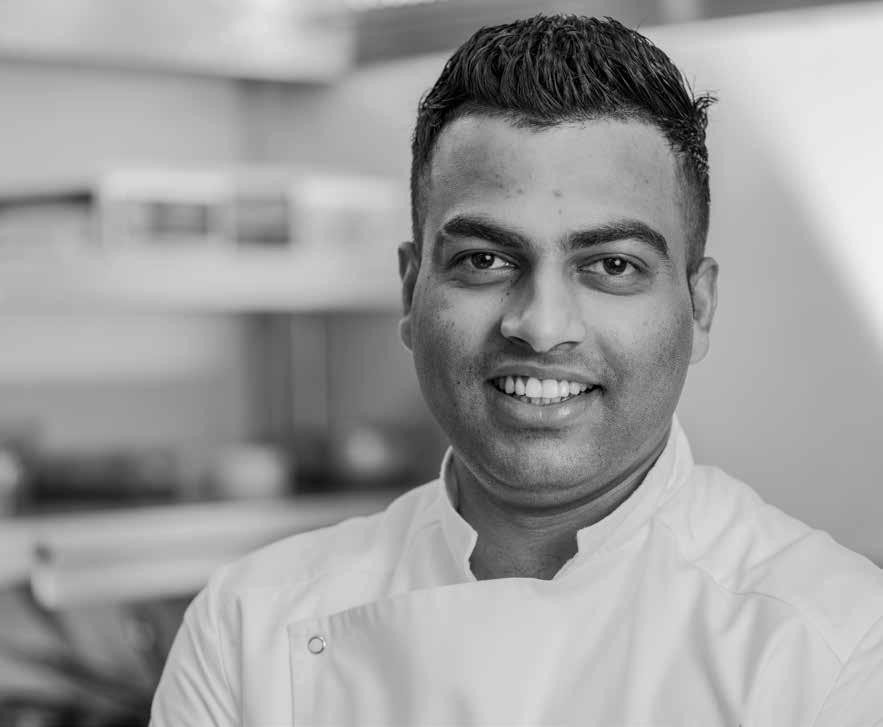
When you love what you do, every challenge becomes an opportunity
With no prior experience and curiosity about what lay ahead, Chef Dhanushka set off for Dubai.
“I finally arrived in Dubai a year later. At that time, it was tough to find a job. The visa was only for one month. I faced so many interviews. On top of that, language was a barrier. I struggled with my English and found it difficult to speak properly," he admits.
Every day brought challenges, but each small effort began to add up when he landed a role at Le Méridien Dubai Hotel and Conference Center. And as growth comes step by step, he began with stewarding and getting familiar with different aspects of the hospitality industry.
"I worked six months as a steward. It was really tough, I even cried at times," he recalls honestly. Homesickness hit hard. The adjustment from the green hills of Sri Lanka to the fast-paced world of Dubai's hospitality industry
was overwhelming. "Every day after my shift, I would sit on the staircase near my room, stare at the airport, and think about home. But with time, I became more interested in my work and started learning quickly.”
Having spent months in cleaning and support roles, he found himself drawn to the pastry kitchen. Half the team there was from Sri Lanka, including the executive pastry chefs, and watching them create cakes and desserts fanned the flames of pastry. "I thought, if I can do that too… why not?" he says, on his decision to enroll in a cross-training program. The pastry chefs encouraged him to continue his current work while making the most of cross-training opportunities, which in turn gave him the confidence to set out on his pastry path.
His timing could not have been better. During his cross-training, an opening came up, and he finally got the chance to join the kitchen full-time. "I was thrilled. I did not have any experience before, so this opportunity was huge for me," he lights up. Over the next three and a half years, he assisted in the preparation and baking of various breads and desserts, eventually earning promotion to first commis.
"Even I was surprised at how quickly I adapted and excelled. They gave me the promotion because I grasped the
projects, the production, everything very quickly," he says, expressing gratitude to his mentors, Chefs Sanjaya, Dhanushka, Dileep Kumara, Buddika Siriwardhana, and Nuwan Prasanga.
At the beginning of 2018, he moved to Rosewood Abu Dhabi, supporting the team in managing daily pastry operations, including ingredient preparation, portion control, and maintaining a clean, organized work environment. By the time he left for a new job, he was a demi chef. "I joined the Pullman Hotel and Resorts Deira Abu Dhabi, working under Chef Dammika and collaborating on the development of new dessert recipes and seasonal menus." Chef Danushka worked there until the pandemic upended life.
Soon after, an opportunity at Five Palm Jumeirah beckoned him forward. “There, I learned under the guidance of Chef Adnan Khan. I spent four and a half years honing my skills, progressing from Chef de Partie to Junior Sous Chef.”
While working there, Chef Dhanushka received what he calls a 'golden opportunity.' “I got a scholarship to pursue a one-year Diploma in Hospitality - Commercial Cookery (Patisserie) offered by ICCA Dubai. I am grateful to Chef Dammika and Madam Shanaaz from ICCA for this. I had no formal background before that, so it really helped me understand things more professionally.”
It has been four months since he joined W Dubai- The Palm, and having stepped up from a Junior Sous Chef to a Pastry Sous Chef role, he approaches this new chapter with humility and a hunger to learn. "I am learning," he admits. "Because everyone is not 100% correct. You should always try to learn more," he says.
Effective kitchen leadership, he believes, starts with open communication to keep morale high. But he also knows when to step in. "You need to be approachable with the team and figure things out. But if someone is not following the rules,
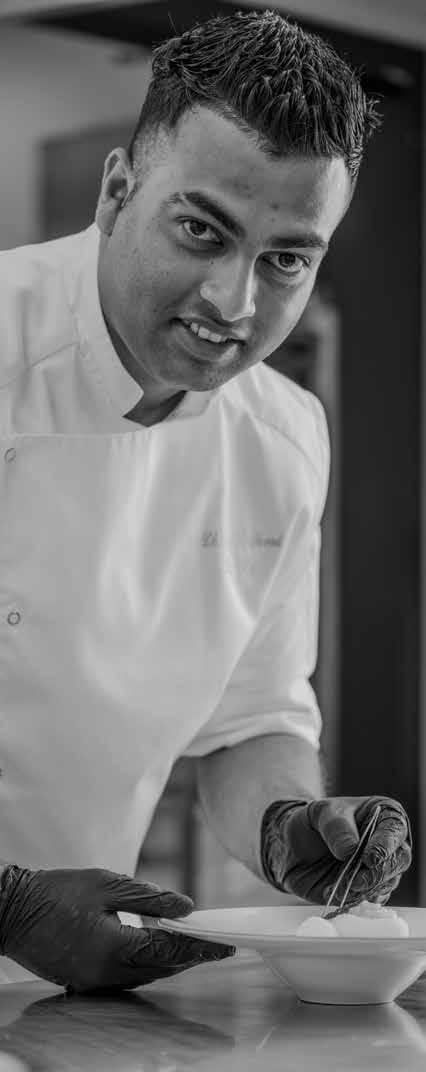
When passion becomes your home, no city feels foreign anymore
you need to address it constructively." With young, talented chefs, he listens first, discusses how they executed a dish, then shares his own tips, always motivating the whole team rather than just rewarding one person. "It is like a cricket team. You cannot have just one batsman," he says, pointing to the importance of teamwork.
Chef Dhanushka knows his way around competitions and the thrill of chasing gold. "I have competed in live cake and plated dessert categories, winning medals at the Salon Culinaire, and even
joined the UAE National Team for the 2022 Global Chef Challenge ."
Stepping up for the Arla Pro challenge, he has mapped out his concept, featuring mango, yuzu, and layers of texture. "I like mango flavor, but I wanted to combine new shapes, flavors, and refine the idea to create a dessert that balanced flavors and textures. The base is a crème brûlée," he explains, walking through the plating. "Then a biscuit, and on top of that, the mango passion yuzu element. And ice cream on top and cream cheese sorbet."
Behind every dessert and every dream, Chef Dhanushka has the support of family, mentors, and friends who make the journey sweeter. “ I thank Chef Saman Sagara for his guidance and help in refining my competition dishes with his invaluable advice.”
He also thanks his friend, Iroshan Madusanka, and his uncle, who first brought him to the city and continues to be part of his support system. "My wife works in accounting, a completely different field. She is my biggest support," he says, speaking warmly about his family.
Thinking back on his journey, Chef Dhanushka is struck by how far he has come. It is hard for him to believe that nearly a decade has passed since he first arrived in Dubai. "At first, I thought I would stay only two years," he smiles. Over time, Dubai became more than just a place to work for him. "I still remember returning to Sri Lanka for my first vacation in years. The experience was bittersweet. I was happy to be home, but I missed Dubai," he says. "At the same time, I really enjoy my work."
Through the passage of time, Chef Dhanushka has realised that home is not merely a place; it is a feeling you carry with you. You can be anywhere in the world, but when your work aligns with your passion, that is also when you feel at home. After all, there is truth in the saying, ‘Home is where the heart is, and the heart is where your passion lies.’ ■
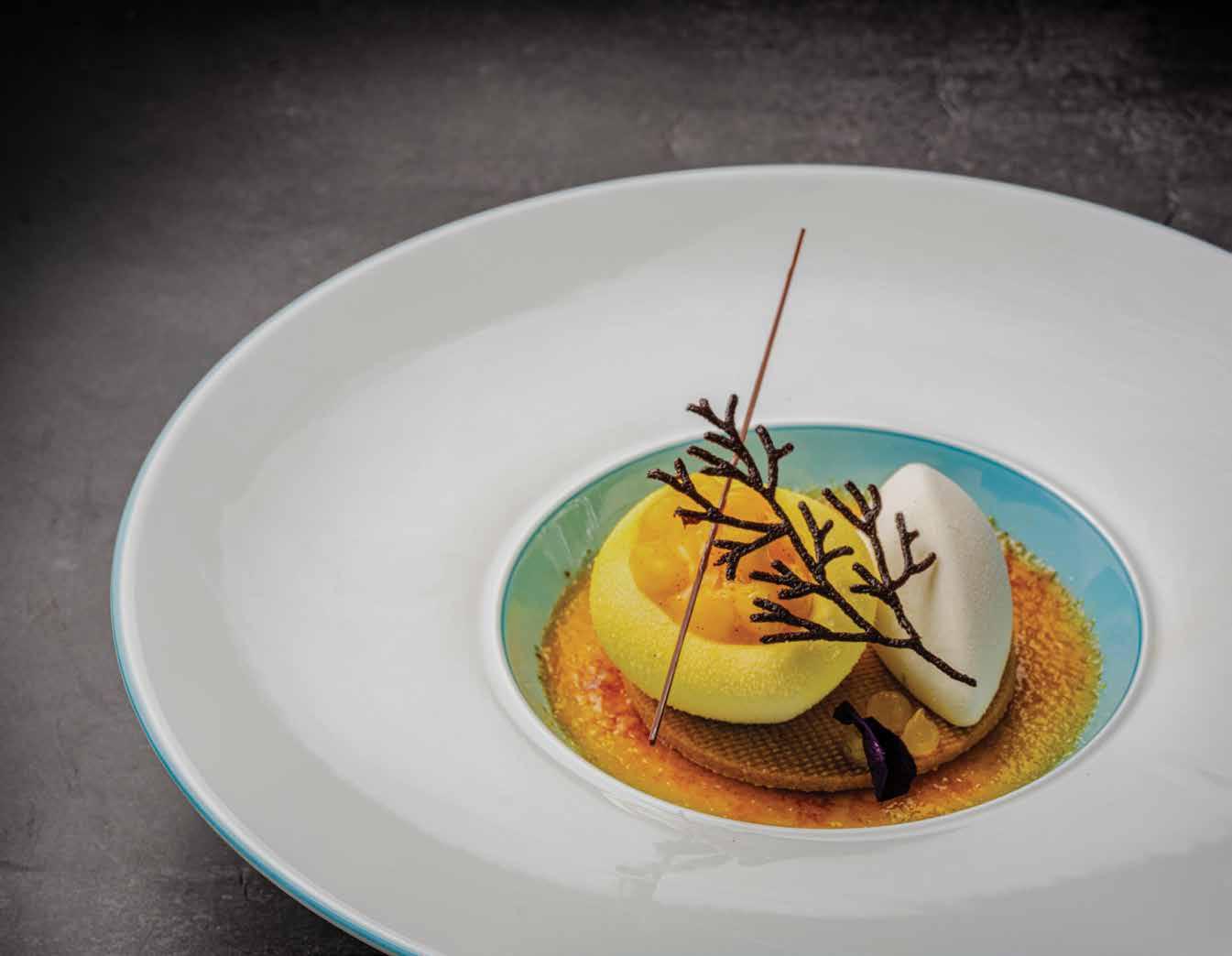
Mango
CheesecakeYuzuVanilla
Cream Brûlée with Cream Cheese Sorbet
Yuzu Orange Cheesecake
ARLA Cream Cheese (25%)
Yuzu Purée
and vanilla pod. Combine with the warm cream. Bake at 140°C for 35 minutes.
Mango Compote
Purée
g
Egg Yolk 30 g
Sugar 45 g
Orange Zest ½ piece
Gelatin 2 pieces
ARLA Cream (30%, whipped) 60 g
Method
Cook yuzu purée, egg yolk, sugar, and orange zest to 85°C. Add gelatin and blend well.
Mix in the cream cheese until smooth.
Once cooled, fold in the whipped cream.
Vanilla Cream Brûlée
Cream
Egg Yolk
Vanilla Pod ½ piece Method
Warm the cream and mix egg yolk, sugar,
Boil mango purée, sugar, and pectin NH together. Cool the mixture, then add the diced mango.
Chocolate Tuile
Yuzu Cream
Melt the butter first.
Mix all dry ingredients together and make a paste.
Spread thinly and bake at 160°C for 6 minutes.
Cook yuzu purée, sugar, and egg yolk to 85°C. Add butter, white chocolate, and cocoa butter.
Blend until smooth.
Cream Cheese Sorbet
(25%)
Boil water, glucose, sugar, stabilizer, and vanilla pod together. Cool mixture to 45°C, then add cream cheese and mix well.
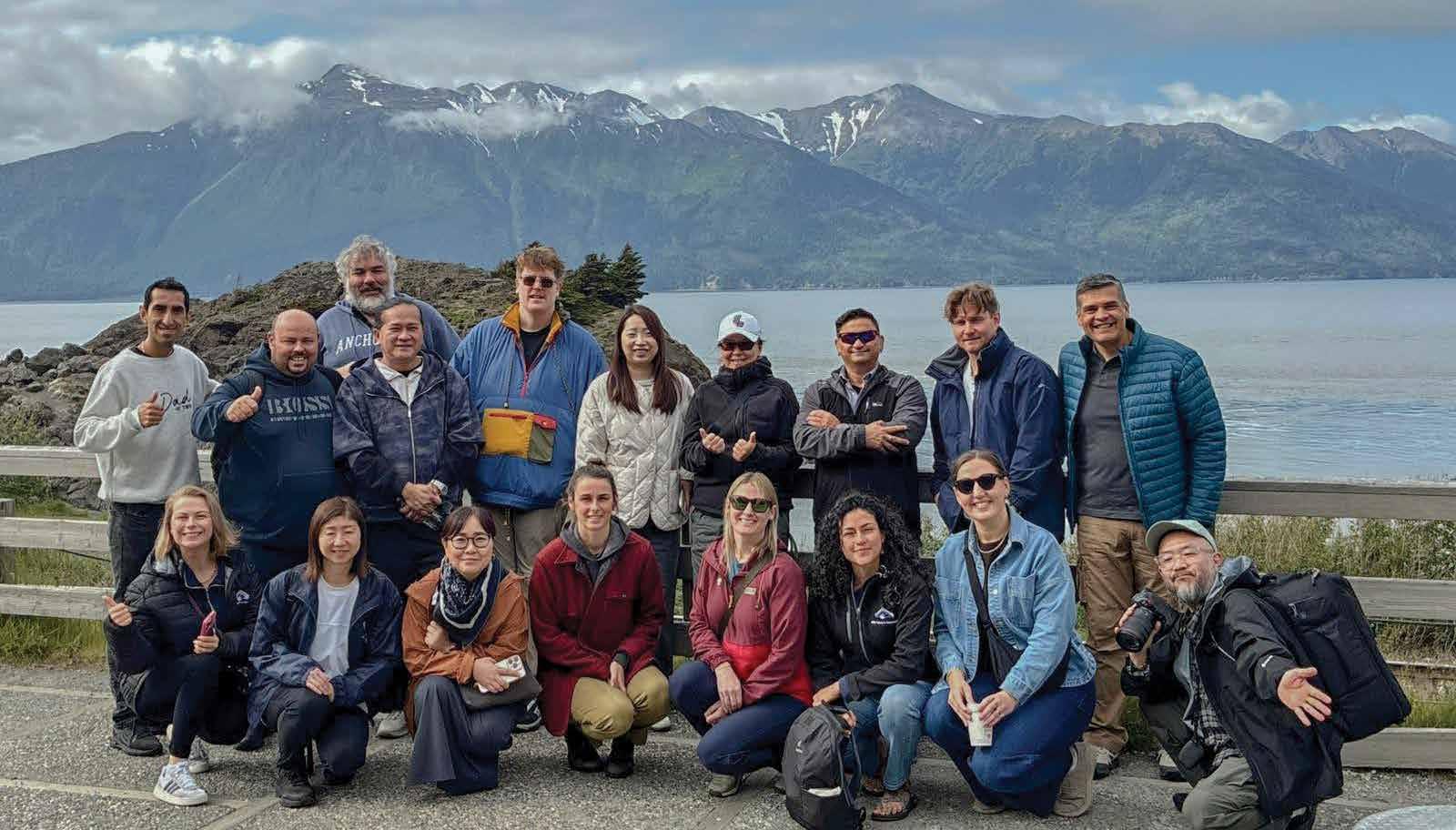
Alaska Seafood Marketing Institute International Culinary Retreat
Where Wild Meets Wonder — Inside Alaska International Culinary Retreat 2025!
In the heart of Alaska's untamed wilderness, a group of world-class chefs traded their starched whites for waders, their test kitchens for riverbanks, and their fine-dining tables for campfires. The 2025 Alaska Seafood Marketing Institute (ASMI) International Culinary Retreat wasn't just another culinary showcase; it was a journey into the soul of sustainable seafood and the spirit of adventure that defines the Last Frontier.
From June 17 to 22, Southcentral Alaska became a living classroom, playground, and creative laboratory for 12 culinary innovators representing every corner of the globe, from Spain to Japan, Peru to Latvia, Ukraine to the UAE. Together, they experienced what few ever do: cooking, tasting, and storytelling at the source of some of the world's purest seafood.
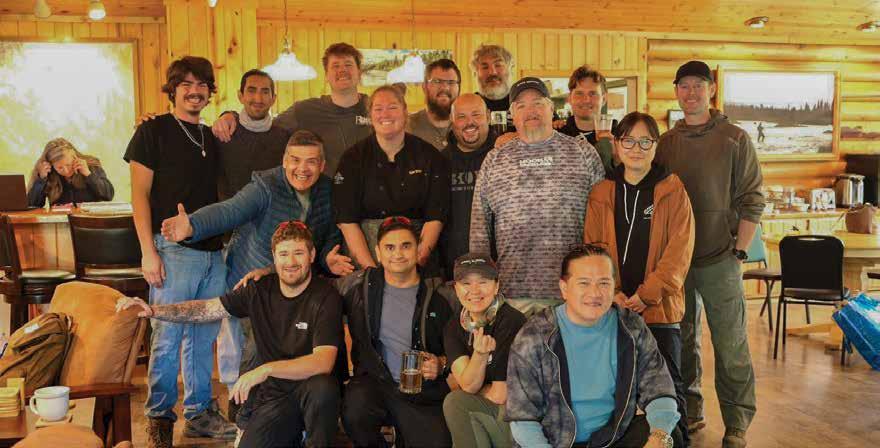
Wild Taste, Global Impact: How the Alaska Culinary Retreat United the World's Top Chefs
Twelve chefs. Six days. One unforgettable journey into the heart of sustainable seafood.
Anchorage, Alaska- June 2025. The Alaska Seafood Marketing Institute hosted an extraordinary event that blended adventure, education, and
culinary innovation through the Alaska International Culinary Retreat 2025.
Leading chefs and food influencers, including Michelin-starred talents, educators, and media personalities, came together to explore the flavour, sustainability, and spirit of wild Alaska seafood. From the bustling docks of Anchorage to the serene rivers of Wilderness Place Lodge, the retreat
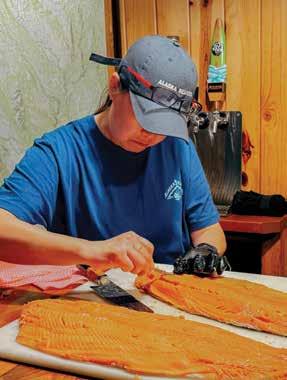
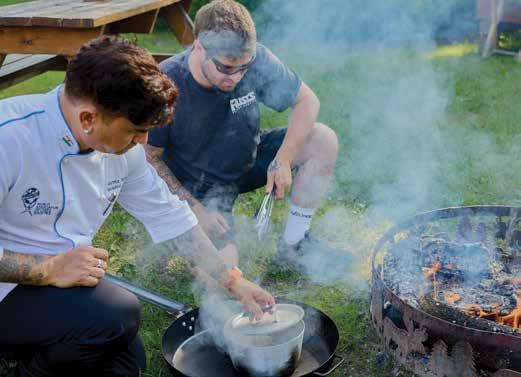
proved that the best way to understand Alaska seafood is to experience it where it begins, in the wild.
Anchorage: A Flavourful Welcome to the Last Frontier
The retreat opened at the historic Hotel Captain Cook, where ASMI's international team, Nicole Alba, Megan Belair, Susana Cardona, and Hannah Schlosstein, welcomed guests with a seafood breakfast celebrating Alaska's pristine bounty.
A tour of FAVCO, one of Anchorage's leading seafood processors, showcased the state's gold standard for freshness, traceability, and responsible harvesting. Later, at the Alaska Native Heritage Center, chefs connected with Indigenous cultures that have stewarded Alaska's waters for generations.
Dinner at the Crow's Nest, overlooking Cook Inlet, brought the day full circle: king crab, sablefish, and halibut dishes crafted with precision and plated with purpose.
"It was perfectly balanced, part education, part inspiration, and entirely enjoyable." – Retreat participant
Into the Wild: A Classroom Without Walls
On the third day, the group traded taxis for floatplanes, flying deep into Alaska's wilderness to Wilderness Place Lodge, a remote destination accessible only by air.
Surrounded by spruce forests and glacierfed rivers, the chefs experienced seafood at its purest source. ASMI staff led sessions on science-based fisheries management and sustainability in practice, revealing how Alaska's system keeps its fisheries healthy for future generations.
The evening's Alaska crab feast became
a highlight, a shared celebration of local bounty, global friendship, and the creative freedom that comes when chefs step outside their comfort zones.
Hands-On Discovery: Whitefish and Collaboration
Day four focused on Alaska whitefish, from pollock to cod, rockfish, and sablefish. A morning of river fishing and open fire cooking grounded chefs in Alaska's landscape and rhythm. Later, Chef Luke French (UK) demonstrated miso-marinated sablefish, combining precision with artistry.
Among the standout moments was a dish from Chef Dwarika Bhatt (UAE), Executive Chef at Zero Gravity, Jumeirah Hotels & Resorts, Dubai, who fused Alaska pollock with Emirati spices and citrus.
"Working with Alaska seafood in such a pure environment," Bhatt reflected, "brings you back to instinct — you cook with respect, not routine."
That evening's collaborative dinner turned the lodge into a global kitchen: Peruvian ceviche, Spanish saffron-braised sablefish, and Indonesian sambal-grilled pollock showcased how Alaska seafood transcends borders and palates alike.
Salmon at the Center
The retreat's final full day celebrated Alaska's culinary ambassador, wild salmon. Chefs explored all five speciesking, sockeye, coho, chum, and pink through tastings, filleting demonstrations, and creative applications.
The closing dinner featured global interpretations, from Japanese-inspired sashimi to South American salmon risotto. Chef Bhatt joined colleagues from Japan and Colombia in crafting a salmon trio that symbolized the retreat's mission: diverse techniques, one shared respect for nature.
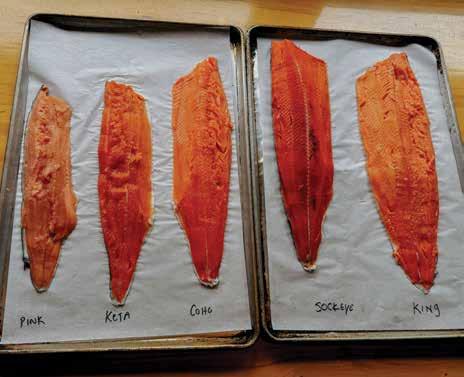
From Experience to Advocacy
When the retreat ended, its impact was only beginning. Chefs returned home inspired to share Alaska's storyintegrating wild seafood into menus, masterclasses, and digital media.
For ASMI, the retreat strengthened connections in key markets, including Japan, China, Spain, the UAE, and the UK. For the chefs, it offered more than inspiration; it provided understanding of how responsible sourcing, environmental stewardship, and culinary excellence can thrive together.
"In Dubai, we think globally about ingredients. In Alaska, I learned to think about the source."
– Chef Dwarika Bhatt, Dubai, UAE
A Journey That Lingers
The 2025 Alaska Culinary Retreat wasn't about luxury; it was about authenticity, about feeling icy river water on your hands as you catch your own fish, then plating it hours later with peers who speak a dozen languages but share one passion.
It was about learning that sustainability isn't a slogan, it's a way of life, lived every day in Alaska.
In the end, the chefs left with more than recipes. They carried home the rhythm of the rivers, the stories of the people, and a renewed respect for nature's balance.
Wild Alaska seafood connects the world one meal, one memory, and one mindful bite at a time.
In Alaska, wild isn't a slogan, it's a mindset. And as these chefs proved, when you cook at the source, you carry the story with you from Anchorage to Dubai, Tokyo to Madrid, and every kitchen in between. ■

Hooked on Alaska
Chef Dwarika Bhatt of Zero Gravity, Dubai, recently experienced Alaska's wild seafood and pristine landscapes firsthand. He takes us on an adventure full of fishing in glacier-fed rivers to bonding with chefs from around the world; the trip lets us vicariously experience the thrill and wonder of it all
When John Muir first set foot in Alaska back in 1879, he was so taken by its raw, untouched beauty that it’s said he felt that after seeing it, no other place quite measures up. For Chef Dwarika Bhatt, it was impossible to disagree. Once in Alaska, its beauty and bounty claimed him completely.
“The crisp Alaskan air was a refreshing welcome,” Bhatt recalls. Being in Alaska, he felt incredibly close to nature. The way the environment is preserved shows a deep respect for nature itself. The scientific approach Alaska takes to managing its fisheries is incredible. Every fish is tracked, from its migration to its age. They’re not just randomly catching fish for food; everything is done thoughtfully and sustainably,” he says.
As part of the Alaska Seafood Marketing
The way Alaska preserves its environment shows a deep respect for nature itself
Institute International Culinary Retreat 2025, Chef Dwarika spent five days in Alaska. The first two were in Anchorage, a small, charming town where he connected with the indigenous culture and regional cuisine. "Anchorage was beautiful, but what made the trip special were the people I met, the rest of the international team of 12 chefs from across the globe," he adds.
On the third day, the group flew to Wilderness Place Lodge to enjoy seafood at its freshest. For Chef Dwarika, the highlight was fishing. “It was quite professional, you have full gear, and they take you out in a boat. Our sports license meant we could catch fish, but we had to release them. It was really humbling and unforgettable.”
But it wasn’t just about the catch. The cozy wooden cottages created a communal space. “ The seafood was super fresh, the food delicious and pure. With no TV or reliable signals, we bonded over shared meals and the simplicity of life in the wild. We became really good friends, like brothers. By the end, it felt like saying goodbye to family,” he recalls.
By the end, Chef Dwarika understood why Muir felt no other place could compare. Alaska finds a way of capturing one’s memories that few other places do. ■
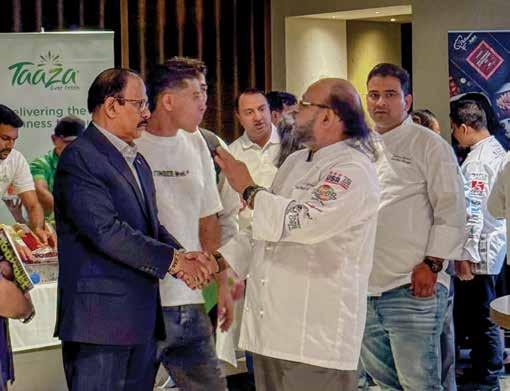
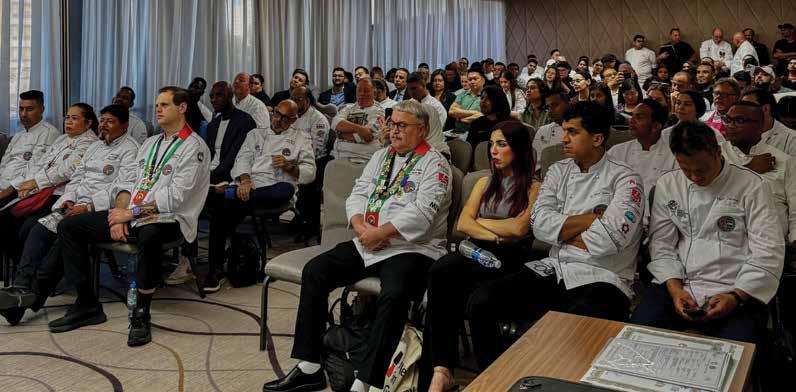
The Guild Meet
Culinary Director Jay Williams hosted a successful October ECG meeting at the Radisson Blu Dubai Deira Creekside, drawing a great turnout of both chefs and suppliers
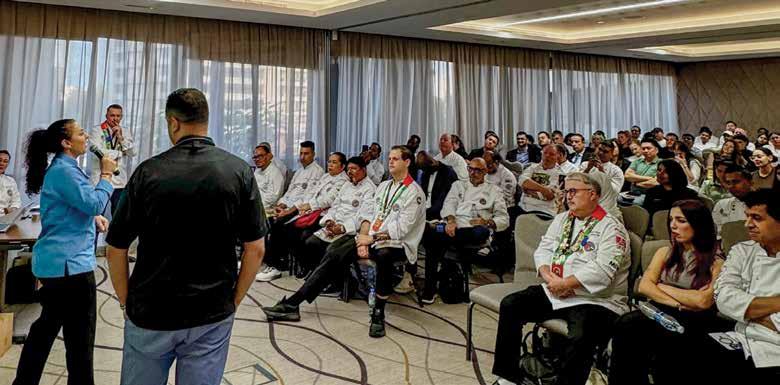

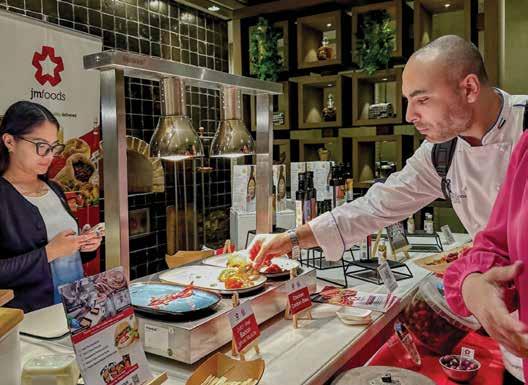
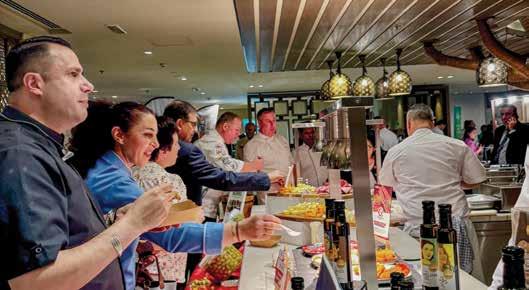




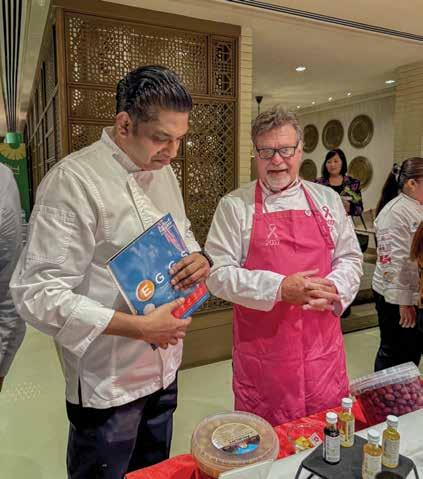
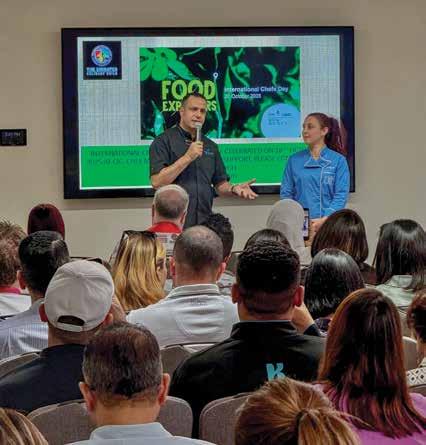



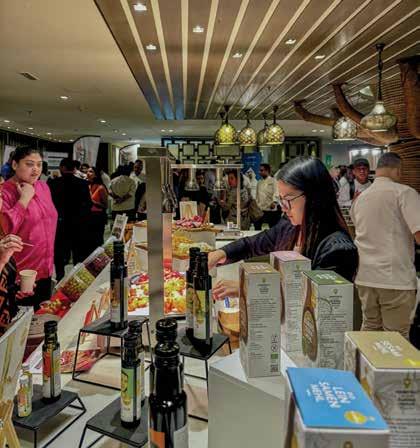
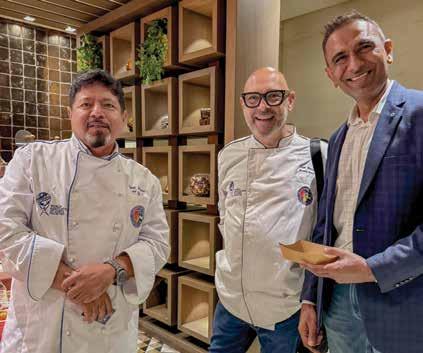


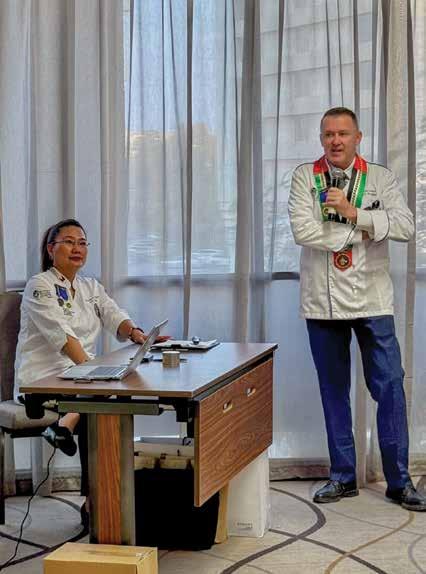

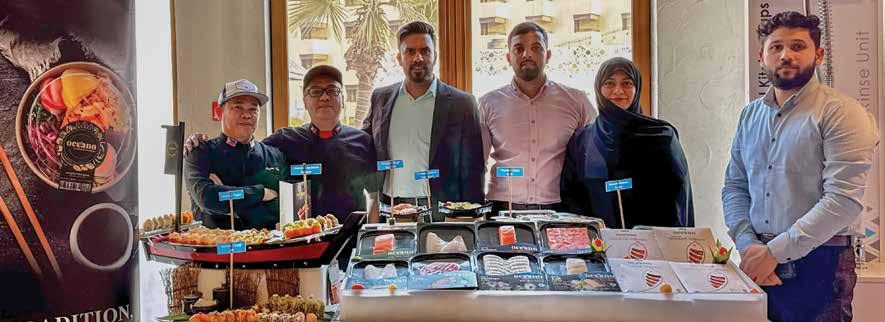

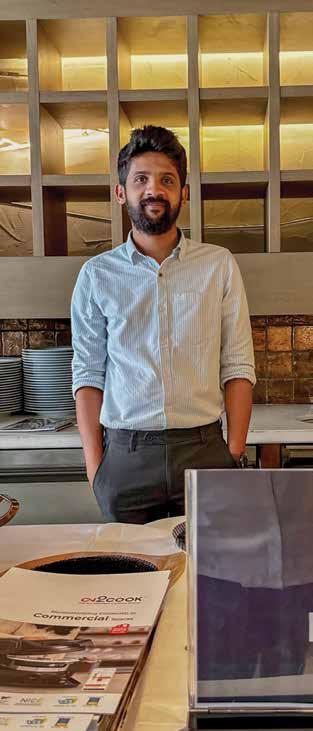

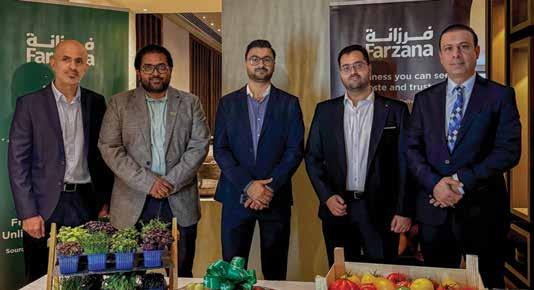
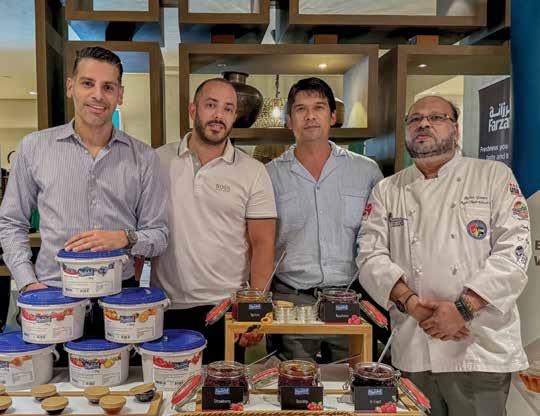


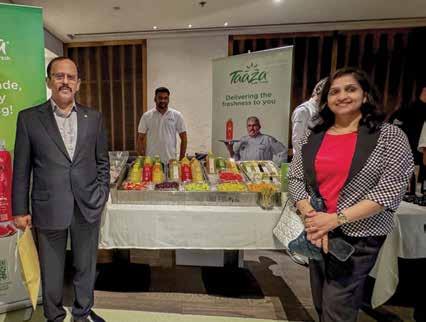
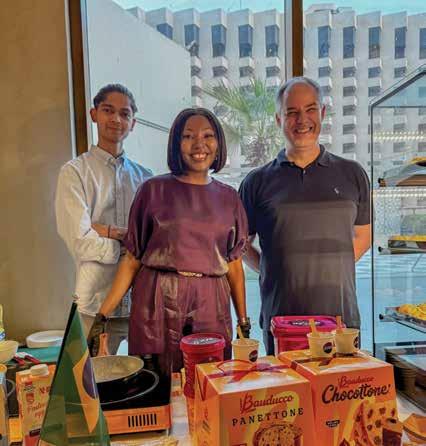
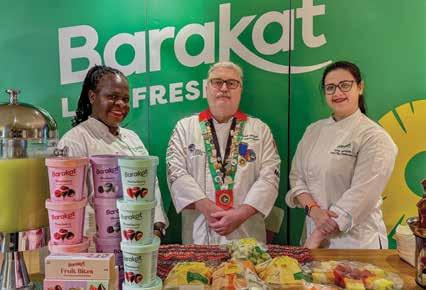
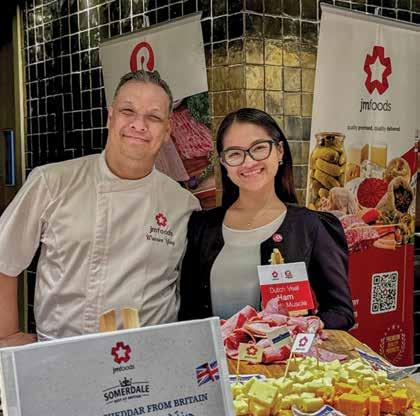


ECG Corporate Member directory
Agthia Group PJSC
Sasha Kannan, Category Development Manager Tel: +971 56 177 87 86, sasha.kannan@agthia.com, www.agthia.com
Al Chef
Ranin Bakhitt, Marketing Manager
Tel: +971 4 357 0320, Mob: +971 50 687 0224 ranin.b@alwholesale.ae, www.alcheftohome.com
Al Wholesale
Ranin Bakhitt, Trade Marketing Manager, Mob: +971 50 6870 224, ranin.b@alwholesale.ae, www.alwholesale.ae
Alaska Seafood Marketing Institute (ASMI) Manjusha Jambhekar, Overseas Marketing Representative – MENAWA, Tel: +971 4 357 7979, Mob: +971 55 5333740 manjusha.m@focusmworld.com, www.alaskaseafood.org
Alliance Abroad International
Zama Nkabinde, Talent Acquisition Manager, Mob: +971 52 2339 779, znkabinde@allianceabroad.com, www.allianceabroad.com
Alto Shaam, Inc
Gabriel Estrella Talentti, Director of Sales, Tel: +971 4 321 9712, Mob: + 971 50 8531 707 gabriele@alto-shaam.com, www.alto-shaam.com
Americana Foods
Laurent Stevenart, Plant Based Food Director, Mob: +971 52 1354 732, lstevenart@americana-food.com, www.americanafoods.com
Arab Marketing and Finance, Inc. (AMFI) Simon Bakht, Tel: +961-1-740378 / 741223 / 751262, SBakht@amfime.com
Arla Foods
Rachna Amarnani, Marketing Specialist, raamy@arlafoods.com, B7 Building Digital park - Dubai Silicon Oasis - Industrial Area - Dubai www.ArlaPro.com, www.arlafoods.com
Bakemart FZ LLC
Syed Masood, Director of Sales Mob : +971 55 609 7526, Tel: +971 4 56708 masood@bakemart.ae, www.bakemart.ae
Barakat Group of Company
Kenneth D’Costa, Managing Director Neil Ranasinghe, Head Culinary Innovation Tel: +971 4 8802121
Cuisine Solutions Middle East LLC FZ Juan van Huyssteen, Company GM Mob: +971 52 926 5628, jhuyssteen@cuisinesolutions.com, www.cuisinesolutions.com
Del Monte Foods (U.A.E) FZE Hany Shamseldeen, Mob +971 50 146 7400, hali@freshdelmonte.com, me.freshdelmonte.com
Diamond Meat Processing Co.L.L.C
Kamparath Suresh, Assistant General Manager Business Development, Mob: +971 50 655 4768 wnedal@siniorafood.com, www.almasadubai.com
dmg events
Hassan, Tel: +971 4 4380355, Mob: +971 56 8360993, aysehassan@dmgeventsme.com, www.thehotelshow.com
Emirates Snack Foods
Marwan Husseini / Vincent Lobo, Head of Sales – Food Service / Creative Head Mob: +971 56 5267 181, +971 55 3692 344 marwan.husseini@esf-uae.com vincent@esf-uae.com, www.esf-uae.com
Essity Hygiene and Health AB Ozge Osmanoglu, Customer Marketing Activation Manager MEIA, Mob: +971 52 7571 486 ozge.osmanoglu@essity.com, www.torkmeia.com
Faisal Al Nusif Trading Co. L.L.C Thomas Das, Managing Director Tel: 04 3391149, thomasdas@fantco.net, Web: www.fantco.net
Farm Fresh
Feeroz Hasan, Business Development Manager Al Quoz, P.O Box 118351, Dubai, UAE Office No : +971 4 3397279 Ext: 253 Fax: +971 4 3397262, Mob: +971 56 1750883
Farzana
Fariborz Khadem Pour, Head of Food Service, Mob: +971 55 8846 293, Tel: +971 4 3200 101, fariborz@farzana.com, www.farzana.com
Flora Professional
Marwan Abidaoud, Jean Lteif, Ronica Sanchez, Nadia Lagdah, Neelam Karim, Regional Lead Culinary Chef - AMET, Culinary Chef UAE & QBOK, Food Service Sales Manager, Head of Marketing, Senior Brand Manager, Mob: +971 50 796 6264, +971 52 829 9891, +971 58 233 1463, +971 50 290 3820, +971 53 369 4190 marwan.abidaoud@florafg.com, jean.lteif@florafg.com, ronica.sanchez@florafg.com, Nadia.Lagdah@florafg.com, neelam.karim@florafg.com
FSEP Catering Equipment Trading LLC
Shivani Rawat, Office Manager Tel: +971 4 8851 610 info@fseprof.com, www.fseprof.com
German Icecream Factory
Boris Mueller, Mob: +971 50 108 9030 boris@drmuellers1969.com www.drmuellers1969.com
Greenhouse Foodstuff Trading
Edgard Abounader, UAE Sales Manager –HORECA, Tel: +971 4 8170000, Mob: +971 56 442 4608, Edgard.Abounader@greenhouseuae.com, www.greenhouseuae.com
Ginox Swiss Kitchen
Tiziana Ricottone, Personal Assistant & Communications Manager, Mob: +971 50 5091 689, tiziana.ricottone@ginoxgroup.com, www.ginoxgroup.com
Hamid and Kumar Enterprises LLC
Sunil Ahluwalia, General Manager, Tel: +971 4 3474712, +971 4 3474571 dry@hkfoodgroup.com, www.hkfoodgroup.com
Harvey and Brockless Foodstuff Trading LLC
Julie Caulton, Sales Director, Tel: +971 4 272 5524, +971 50 507 7539 Julie.caulton@harveyandbrockless.co.uk, www.harveyandbrockless.co.uk
HK Enterprises Era Jain, Marketing Manager, Mob: +971 56 6589 246, era@hkfoodgroup.com, www.hkfoodgroup.com
Hospitality Monster
Naseer Kareem, Manager, Mob: +971 56 871 00 87, +971 50 256 72 00, hello@thehospitalitymonster.com, thehospitalitymonster.com
Hospitality by Dubai World Trade Centre Georg.Hessler, Director - Culinary Operations, Tel: 04 3086571, Georg.Hessler@dwtc.com, https://www.dwtchospitality.com/en/
HUG AG
Riyadh Hessian, 6102 Malters / , food-service@hug-luzern.ch, www.hug-luzern.ch, fb/hugfoodservice Distribution UAE and Oman: Aramtec, PO Box 6936, Al Quoz Industrial Area No. 1, Near Khaleej Times Office, Mob +971 507648434, www.aramtec.com
IFFCO
Mary Rose Lopez, Associate Customer Service Manager, Mob:+971 506719882, 065029025 / 6264 mlopez@iffco.com, www.iffco.com
Indoguna Dubai LLC / Indoguna Productions FZCO Ana Elena Saenz, Juancho Capistrano, Regional Business Dev Manager, Group Sales and Marketing, Mob:+971 55 573 7035, +971 58 246 9330 ana@indoguna.ae, juancho@indoguna-dubai.ae indogunadubai.com, indogunaproductions.com
IRCA MEA TRADING LLC
Shairra Mae Bartirzal-Periales, Trade Marketing Manager, Mob:+971 54 515 4430, shairra.bartirzal@irca.eu, www.ircagroup.com
JM FOODS LLC
Rajan J.S. / Maikel Cooke / Grace Renomeron Management, Tel: +971 4 883 8238, sales@jmfoodgulf.com, www.jmfoodgulf.com
Johnson Diversey Gulf
Marc Robitzkat Mob: 050 459 4031, Off: 04 8819470 marc.robitzkat@jonhnsondiversey.com
KAPP
Kerem Uner, Sales and Marketing Director Tel: +90 53 2599 9638, kerem.uner@kapp.com.tr, www.kapp.com.tr
Kerry Taste & Nutrition MENTA
Simon Martin, Executive Chef Tel: +971 52 450 0845 simon.martin@kerry.com, www.kerry.com
LG FMCG TRADING LLC
Joel C. Peñafiel, Trade Marketing Manager Tel: +971 56 993 5175, joel.cortez@lalsgroup.com, www.lalsgroup.com/brand/81/fmcg
Lowe Refrigeration LLC
Mark Wood, General Manager
Tel: +971 4 8829440, Mob: +971 52 8693695 mark.wood@lowerental.com, www.lowerental.com
Masterbaker Marketing FZCO
Sanket Shah, Sales Manager
Tel: +971 4 8239 800, Mob: +971 50 4516 459 sankets@uae.switzgroup.com www.masterbakerme.com
Meat & Livestock Australia
Damon Holmes, Business Development Manager, Tel: +971 52169 4743, dholmes@mla.com.au, www.lambandbeef.com
MEIKO Middle East FZE
Jay Dhanrajani, Sales Manager Tel: +971 4 3415 172, jay.kumar@meiko.ae, www.meiko.ae
Meyer Group Ltd
Anjana Vaswani Kavasseri, General Manager - Middle East, Tel: +971 50 5950 772, anjana@meyeruk. com, www.meyergroup.co.uk
MKN Maschinenfabrik
Kurt Neubauer GmbH & Co.KG
Elias Rached, Regional Director Sales Middle East & Africa, Tel: +971 4 358 4000, Mob: +971 50 558 7477 rac@mkn-middle-east.com, www.mkn.com
Nestle Middle East FZE
Elie Lteif / Luma Karadsheh, Culinary Advisor / Commercial Development Manager, Mob: +971 55 4427 010, 55 3437 632 (Elie) elie.lteif@ae.nestle.com, luma.karadsheh@ae, www.nestleprofessionalmena.com
Nina Pita
Mario Nehmeh, Sales manager, Tel: +971 50 9347 930, mario@ninapita.com, www.ninapita.com
NRTC Group
Iyad Nouneh, Regional Head of Digital Marketing & E-Commerce Manager, Tel: +971 4 320 8889, marketingmanager@nrtcgroup.com www.nrtcgroup.com
Peachtree Foods ME
Manisha Dissanayake, Regional Sales Manager, Mob: +971 50 6416 139 mesales@popcakesa.co.za, www.popcakesa.co.za
Pear Bureau Northwest
Nina Halal, Director Mob: (Lebanon) +961 3664088, (UAE) +971 58284 0008, halal@cyberia.net.lb
Potatoes USA
Victoria Hassani, Managing Director, Mob: +971 50 1013 541 potatoesusa@gmadubai.com, www.usapotatoes.com
Quadrant International LLC
Dipu Muralidharan Nair, Managing Director, Tel: +971 4 885 2551, Mob: +971 50 559 7913 dipu.nair@quadrantintl.com, www.quadrantintl.com
RAK Porcelain
Sadik Variyathodi, General Manager, Mob: +971 50 4868 141, +971 4 3335 474 sadik@rakrestofair.ae, www.restofair.ae
Restofair RAK LLC
Sadik Variyathodi, General Manager Mob: +971 50 4868 141, sadik@rakrestofair.ae, www.restofair.ae
Robot Coupe
Chandrakanth Pathi, Area Manager-UAE Tel: +971 54 4894896, pathi@robot-coupe.com, www.robot-coupe.com
Safco International Genera Trading
Pankaj Chanta / Naresh Khushalani, Corporate Head - Pastry & Bakery / Marketing Manager, Mob: +971 55 899 0183, +971 870 2000, chef.pankaj@safcointl.com/naresh@safcointl, www.safcointl.com
Silal Food & Technology
Aparna Joseph, Omaima Abdalla , ManagerMarketing & Branding, Marketing Officer Tel: +971 2 614 4467, Mob: +971 52 650 3454 ajoseph@silal.ae, oabdalla@silal.ae, www.silal.ae
Skinny Genie
Lucy Mwangi, Sales Executive Mob: +971 56 411 8287, + 971 56 411 8287 lucy@skinny-genie.com, www.skinny-genie.com
Sounbula Mills
Karim Al Azhari, Ceo & Owner Sounbula Mills karim@sounbulamills.com
November 2025 Gulf Gourmet
Sweet Connection the Gluten-Free Kitchen
Ahmed Alhamadani (Founder & Managing Director), Chef Janitha (Head Chef), Mob: +971 50 4599 401, +971 50 3057 760 info@chillydate.com, www.chillydatefoods.com
Switch Foods
Robert Hazzam, Sales Manager
Tel: +971 2 6759 555, Mob: +971 52 8979 062, rhazzam@switchfoods.com, switchfoods.com
Taaza Group Companies LLC
Ms. Krishna Vijith, Chief Executive Officer
Tel: +971 56 2829 002; +971 4 2828 993 krishna@taaza.ae, www.taaza.ae
The Deep Seafood Company LLC
Shibu Abdul Jabbar, Director Sales & Operation’s Tel: +971 2 673 34 45, Mob: +971 55 233 66 88 shibu@thedeepseafood.com, www.thedeepseafood.com
Tork - Essity Hygiene and Health AB
Ozge Osmanoglu, Tel: +971 4 551 5907, Mob: +971 52 757 1486 tork.meia@essity.com, www.Torkmeia.com
Tramontina
Saniya Sarguru, Marketing Coordinator, Mob: +971 54 995 8033, Tramontina.ae
UNOX Middle East DMCC
Matthew Roberts, Managing Director Tel: +971 4 5542146, Mob: +971 52 304332, info.uae@unox.com, www.unox.com
Upfield Middle East Limited FZCO
Marwan Abi Daoud, Flora Professional Regional Lead Culinary Chef AMEA Mob: +971 50 796 6264 marwan.abidaoud@florafg.com,
USA Cheese Guild
Angelique Hollister, Senior Vice President, Global Cheese Marketing, Tel: 703 528 3049, ahollister@usdec.org, https://www.usacheeseguild.org/
US Meat Export Federation
Bassam Bousaleh, Tel: +971 50 3589197, +971 50 358 9197 Bassamb@ams-me.com
USA Poultry and Egg Export Council Inc (USAPEEC)
Jena Gress, Global Marketing Manager Tel: 14048823920, www.usapeec.org
US Poultry
Andrew El Halal, Marketing Manager Mob: (Lebanon) +961 3200332, (UAE) +971 52 135 1405 andrewh@amfi-me.com
VITO AG
Mark Marquez, Mob: 971 56 2431303 info@vito.ag, www.VITO.ag
Welbilt
Rakesh Tiwari, Mob: +971 56 406 1628, rakesh.tiwari@welbilt.com

THE EMIRATES CULINARY GUILD
APPLICATION FORM
Date of Application: .................................................
Family Name: First Name/s: Ms/ Mrs/ Mr/ Other:
Nationality: Civil Status: Date of Birth: dd/mm/yyyy
Employee/ Business Owner: Name of Business: Designation:
Work Address: Email Address: Contact Number:
Type of Membership: (please tick)
SENIOR:
(Above the rank of chef de partie/ senior chef de partie on executive chef’s recommendation).
MEMBER:
(Below the rank of chef de partie 29 years old and over).
AED350 joining fee/ AED150 renewal fee
Includes certificate; member-pin, member medal and ECG ceremonial collar
AED150 joining fee/AED75 renewal fee
Includes certificate; member-pin, member medal and ECG ceremonial collar
YOUNG MEMBER: (under 28 years) Free
Includes certificate; member-pin
Declaration to be Signed by Applicant:
I wish to join The Emirates Culinary Guild in collaboration with The Women’s Culinary Chapter.
I have read the ECG Constitution and By-laws. I agree to be bound by the requirements of the constitution. If elected, I promise to support the Guild and its’ endeavours to the best of my abilities.
Signature: .....................................................
Proposed By: Signature: ..............................
Seconded By: Signature: ..............................
For Official Use Only
Remarks:
Payment Received?
Certificate Given Pin Given Medal & Collar Given
Approved by President: Signature: ..............................
Approved by Chairman: Signature: ..............................
Note: The membership is only applicable to those who are working in the UAE as professional chef or with a background related as Chef in the hotel and restaurant industry.
The WCC is in collaboration with the Emirates Culinary Guild, which is a member of the World Association of Chef’s Societies
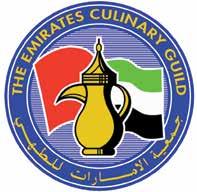

Cuisine Solutions: Quality products from the MASTERS OF SOUS VIDE
We are chefs. We understand the challenges, pressures, and rewards of culinary life. At Cuisine Solutions, we don't replace chefs' talent or creativity—we support it. We're your culinary partner, delivering products with exceptional quality, consistency, and food safety.
We select ingredients, craft recipes, refine techniques, and manage operations. Like you, we strive to deliver flawless dining experiences and constantly improve both process and product.

This pursuit of perfection led our team to pioneer sous vide cookingFrench for "under pressure." Developed in 1971 by our Chief Scientist, Dr. Bruno Goussault, sous vide involves vacuum-sealing ingredients, cooking
them precisely, and flash-freezing or refrigerating to preserve texture and flavor. That's why top chefs and passionate foodies trust our products.
We were among the first to recognize sous vide's power to elevate simple and complex ingredients across all venues. It offers precision, tenderness, and flavor beyond traditional methods.
Thanks to our chefs, sous vide is transforming the industry-helping address labor shortages, rising costs, and growing demand for clean labels and traceability. ■
Juan van Huyssteen, General Manager, Cuisine Solutions INC, received the membership certificate from Chef Harald Oberender, VP of Corporate ECG, and Chef Alan Orreal, President of the ECG.

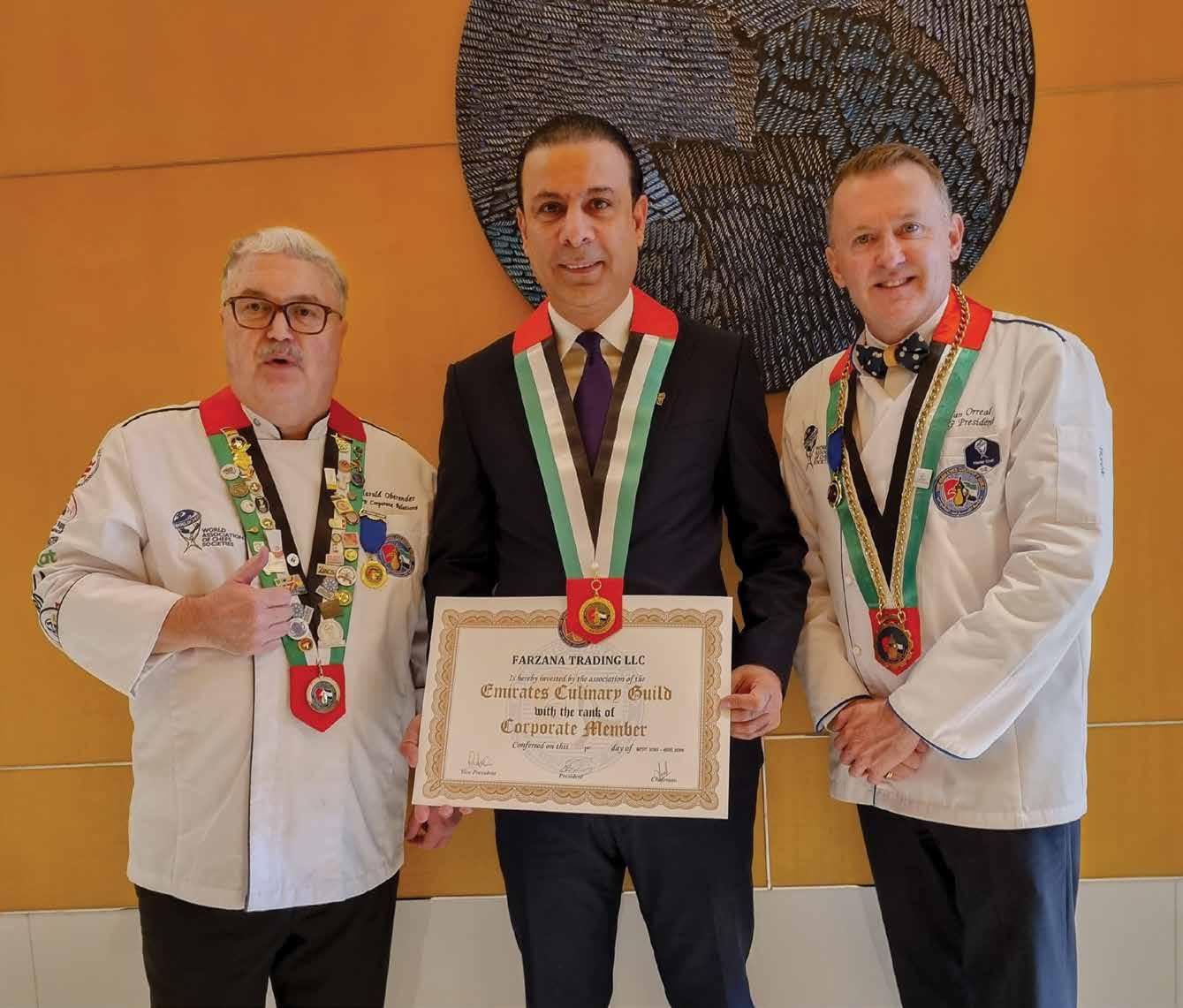
Farzana: Partnering with Chefs for Culinary Excellence
For over six decades, Farzana has been at the forefront of the UAE’s food and beverage landscape, proudly serving the nation’s most renowned hotels, restaurants, and catering establishments. As a trusted name in foodservice, Farzana has built its reputation on an unwavering commitment to quality, consistency, and customer satisfaction.
With a diverse and ever-expanding portfolio, Farzana offers an extensive selection of fresh fruits and vegetables, frozen foods, dairy, dry goods, and
specialty ingredients sourced from the finest producers around the world. Our products cater to every culinary need — from premium imported items to regionally sourced staples — ensuring chefs have access to the ingredients that inspire creativity and deliver excellence on every plate.
Our state-of-the-art distribution network is designed to meet the dynamic demands of the foodservice industry.
Equipped with advanced cold chain logistics, dedicated storage facilities, and a fleet of temperature-controlled vehicles, we ensure that every product reaches our clients in optimal condition. From daily restaurant deliveries to large-scale catering supply, reliability and freshness remain the hallmarks of our service.
At Farzana, we believe that great food begins with great ingredients — and great partnerships. By working closely with chefs and culinary professionals, we strive to support innovation in the kitchen and contribute to the continued growth of the region’s thriving foodservice industry. ■
Fariborz Khadem Pour- Head of Foodservice, Farzana, received the membership certificate from Chef Harald Oberender, VP of Corporate ECG, and Chef Alan Orreal, President of the ECG.

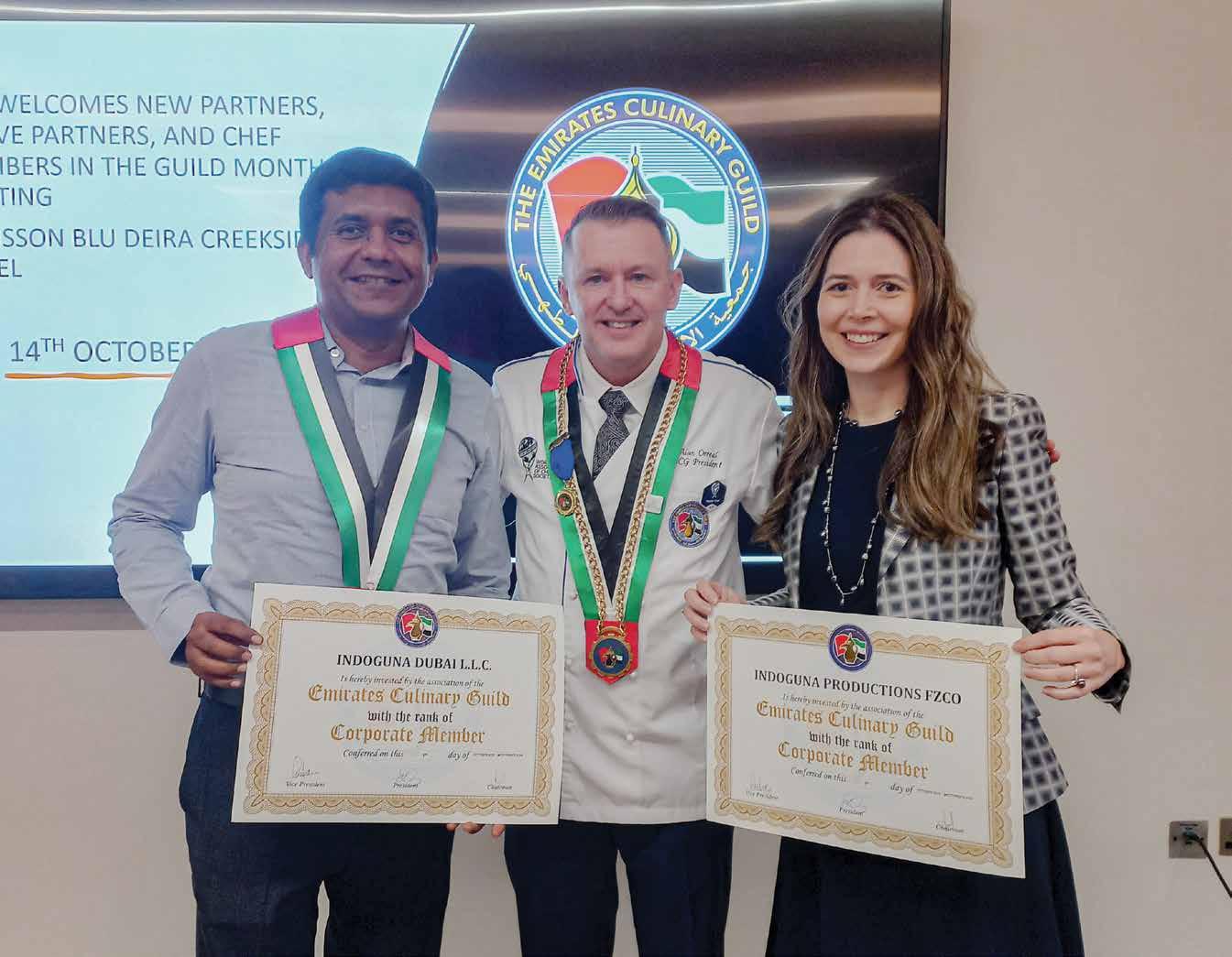
Indoguna Dubai LLC, Indoguna Productions FZCO
Indoguna Dubai is the UAE’s trusted leader in premium food distribution, sourcing exceptional meats, seafood, poultry, and specialty products from around the world. Serving chefs, restaurants, and retailers across the nation, the company has built its reputation on quality, reliability, and innovation—ensuring that every delivery inspires culinary creativity.
The strength of Indoguna Dubai lies in its backbone: Indoguna Productions. With this vertical integration, the company doesn’t just source—it creates. From concept to production to distribution, this synergy ensures unmatched consistency and the ability to deliver
exclusive home brands that have become staples in the region: Carne Meats for artisanal butchery, Masterpiece for culinary essentials, Yum Bites for creative snacking and ready-to-serve solutions, and Ocean Gems for responsibly sourced seafood. Together, these brands embody the company’s vision of raising food service standards in the UAE.
This vision was set in motion by Helene Raudaschl, founder of Indoguna, whose entrepreneurial drive continues to power
innovation at Indoguna Productions. A decade ago, she discovered Karlo Pacheco, then the Culinary Director of Rotana, whose chef-driven expertise and hospitality background aligned seamlessly with the company’s mission. Today, Karlo leads as Managing Director of Indoguna Dubai, blending culinary insight with strategic leadership to guide the company into its next era of growth.
Under Helene and Karlo’s combined leadership, Indoguna Dubai has become more than a distributor—it is a partner to the food industry. With advanced logistics, strict food safety systems, and deep market knowledge, the company consistently delivers not only products but also the confidence chefs and businesses need to succeed.) ■
Ana Elena Saenz - Regional Business Development Manager, and Anoop Kumar – Director of Sales and Commercial – Indoguna Dubai LLC received the membership certificate from Chef Alan Orreal, President of the ECG.
Trends Express Culinary
Simon Martin, Executive Chef at Kerry Taste & Nutrition, on the latest culinary trends, including playful flavor pairings, indulgent comfort foods, and multisensory dining experiences
Welcome back to Trends Express. Without further ado, let's jump on board the "Trends Express" and see what's hot and appearing in our region. Remember, "LIKE IT, BUY IT, SNAP IT, SHARE IT."
They're not complicated, but just a few simple ingredients will rock your culinary planet …..
Wow, what a summer it has been, and now we are all back and pushing the culinary boundaries towards the next level. Let us take a few minutes to see what is big out there in the region, which culinary trends are going to Float your Boat and bring us satisfied customers as well as drive bigger sales tickets??
As the season moves towards al fresco eating and BBQ, we are seeing trends lean towards comfort foods like proteinrich “HIGH-LOW PAIRINGS” such as fries topped with Labneh and sweet chili sauce or hash browns with caviar. This trend combines all your favourite casual foods with a luxurious twist. So, it is time to get creative and stay on trend. Let us look out for Mac N Cheese with truffle or peanut butter and pickle toasties. Dark chocolate and salted popcorn is the thing for me... I am salivating at the thought of this as I write. It also works with food and mocktails, so think a passionfruit mocktail paired with a duck hotdog topped with crispy fried jalapenos ☺ ….ooohh I hear you say. Or, more downto-earth, try pairing your favorite cola with cubed watermelon. Go on, this will surprise you… it is really, really good.
Gen Z and social media are continuing to drive the never-ending quest for Umami, spicy flavours. This also encapsulates

Chef Simon says…
bolder flavours mainly from East Asia. Shichimi Togarashi (Japanese seven spice) is a great example, and Lao Gan Ma from China, along with Korean Gochujang, is still the top amongst the Gen Z crowd. Only this week I tried a Gochujang and egg mayo sandwich, and to my surprise, it was way above my “EGGSPECTATIONS” Lol. Looking at this, I have also seen Wasabi Chocolate making a welcome return to our region in the last month. At this time of year, we should focus on younger customers to help drive trends through their social media interactions. When was the last time your food or beverage was reposted? What is your best Gen Z dish? Yesterday I had Birria Noodles and a Gelato sando…I Must Be Young at Heart.
Finally, what is your music playlist for your customers? Did you know the right tunes can increase the food taste by up to 20% yes, I did say 20%. Some airlines now have a food playlist, so
maybe a chorus of Tosca when you are serving pasta, and of course, a red checked tablecloth will also enhance the experience. Why not try this out tonight? I am going to play La Marseillaise while we have Duck confit and Dauphinoise potatoes. Looking through my music, I am now wondering how sachet tort will taste if I dig out my Johann Strauss. Of course, not sure a blast from "PIT BULL' or "PUFF DADDY" will bring anything to my tacos or hot dog ☺. But as they say, I am all ears. Have you tried this? How was it? What did you consume and to what tunes? Research also indicates that with this music enhancement, customers are willing to pay more for the food.
As usual, I have been trying many new combinations, from chicken lollypops in white chocolate to chili con carne with vanilla ice cream. Although I must say my favourite this month was avocado dipped into milk chocolate, I CAN ONLY SAY AMAZING AMAZING AMAZING..… GO ON, TELL ME YOUR GO TO...., IT MIGHT SURPRISE ME ☺
Finally, looking at trends, our corporate partners at the Emirates Culinary Guild are also helping define the landscape of trends with their visions. Their foresight to make their latest products available to us at our monthly meetings reflects both innovation and current market trends. Stay ahead of the curve, talk to them, and try their products. Join them and us in driving the trends in our region. ■
Kerry Foodservice provides custom-made solutions (coatings, sauces, beverages, etc.) and branded solutions such as Chef’s Palette and DaVinci Gourmet to global and regional chains, QSRs, and casual diners across the region.


